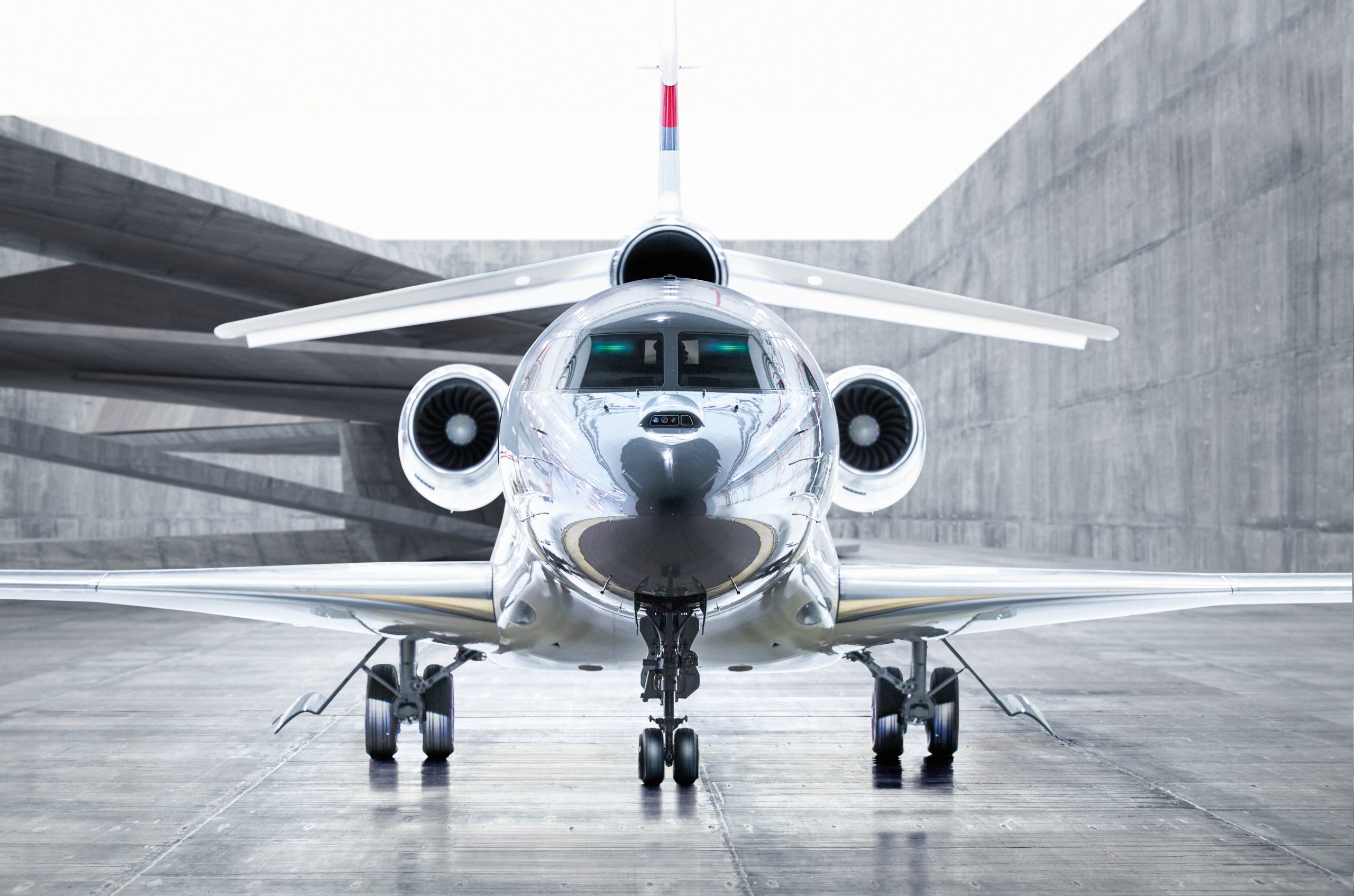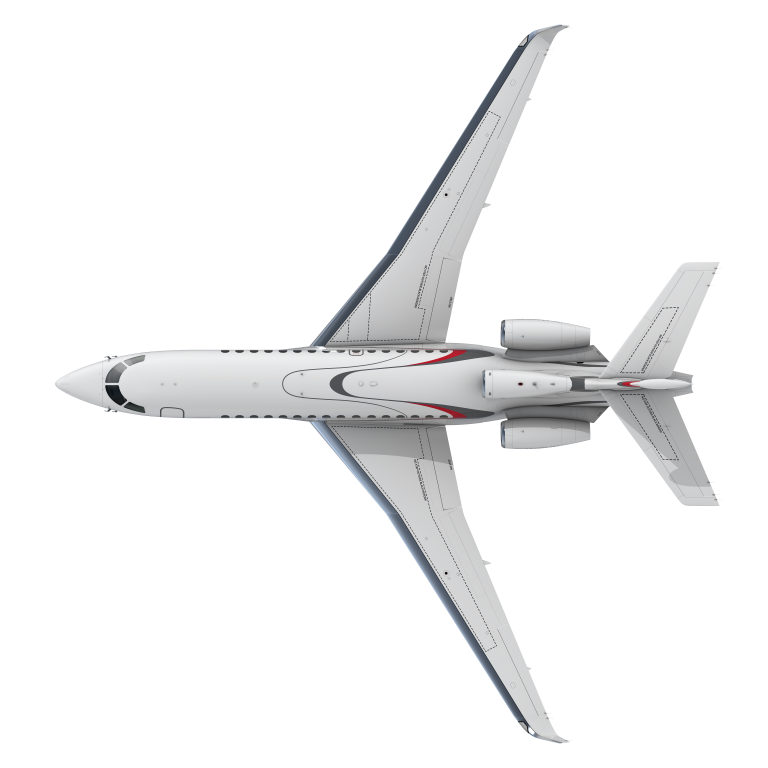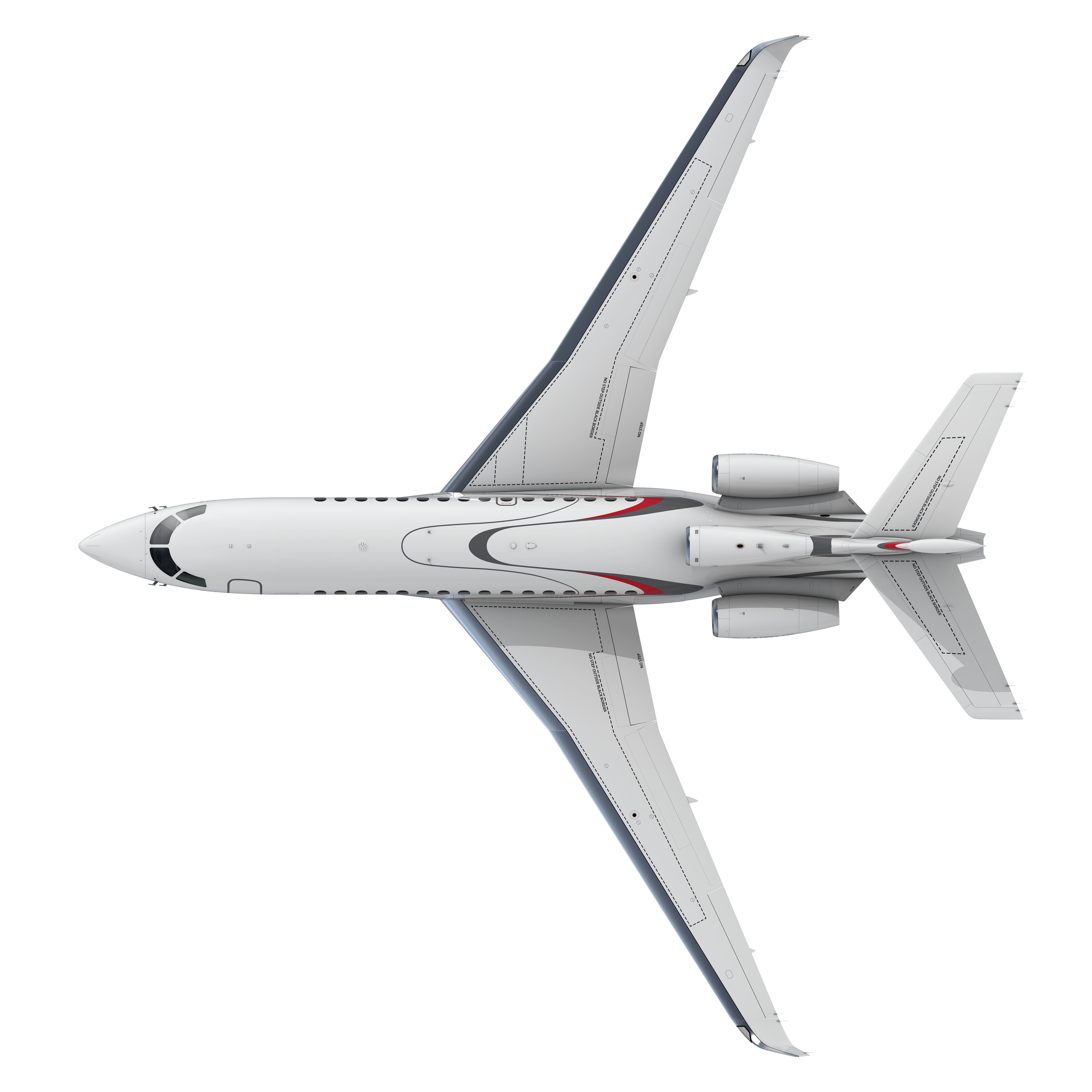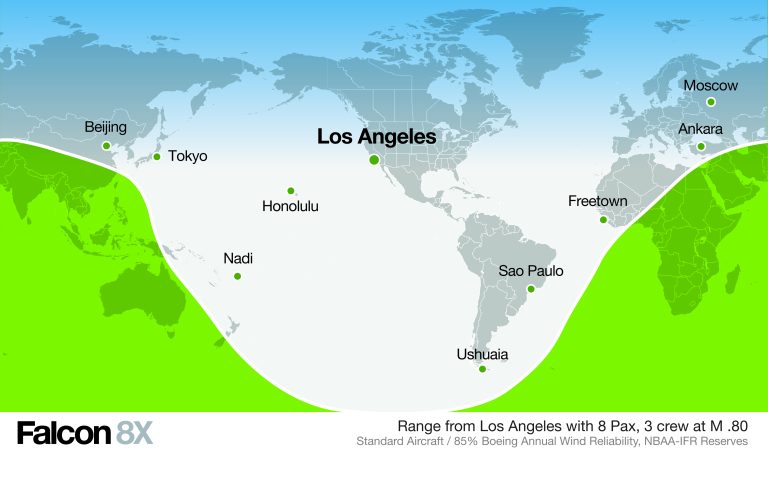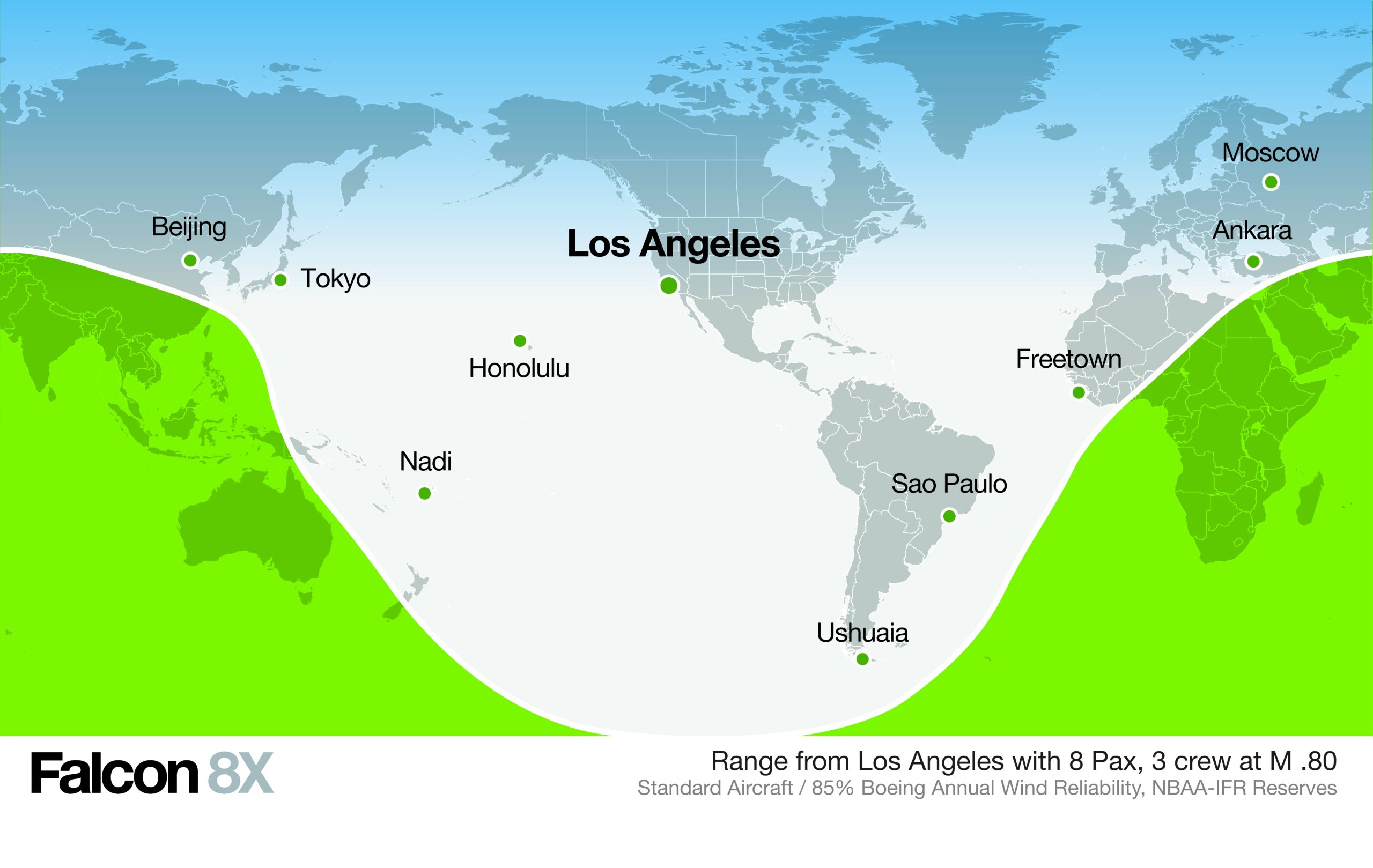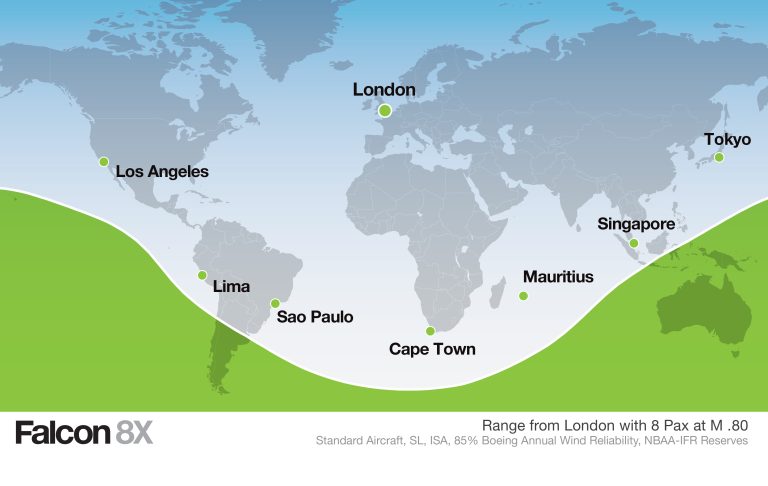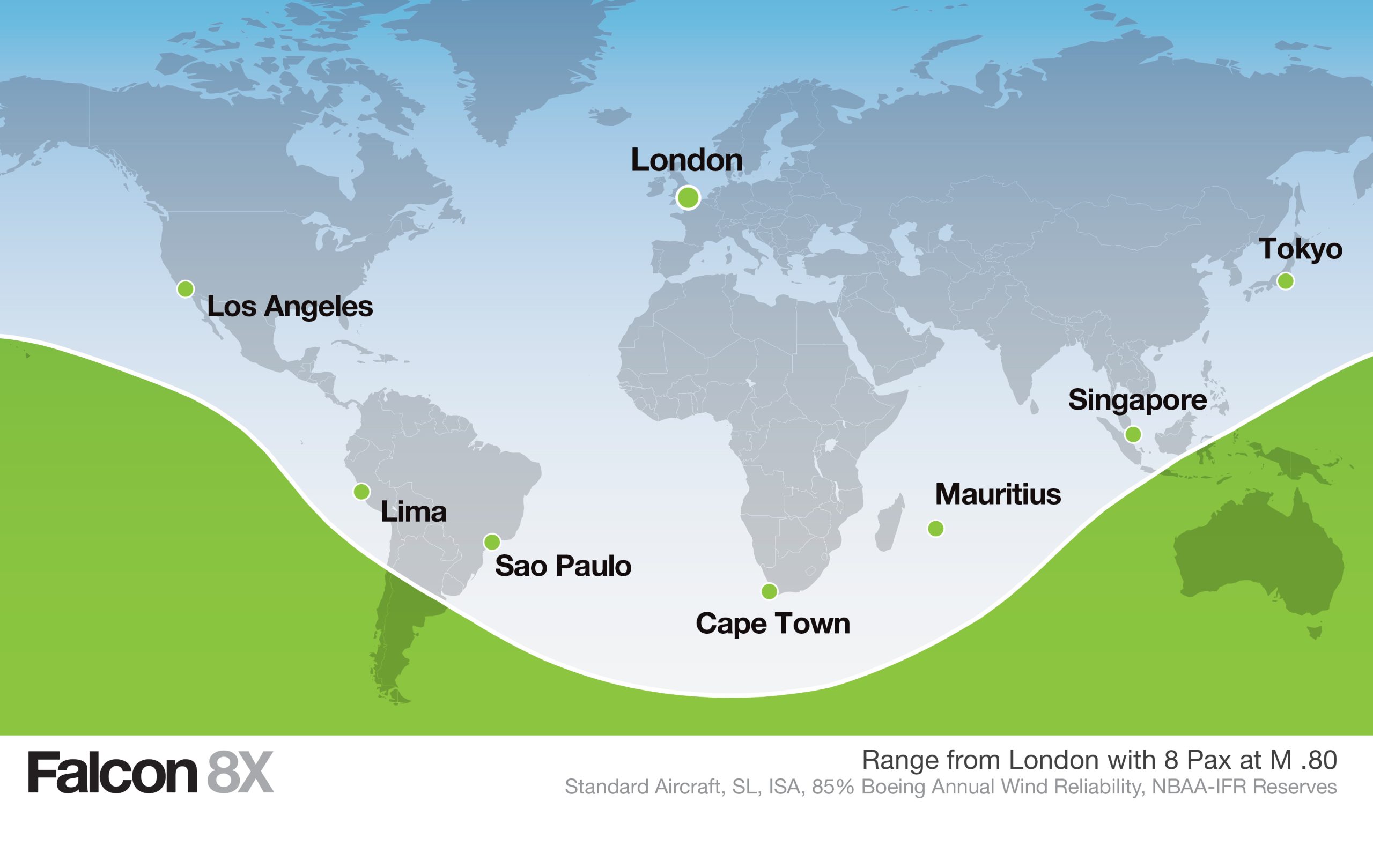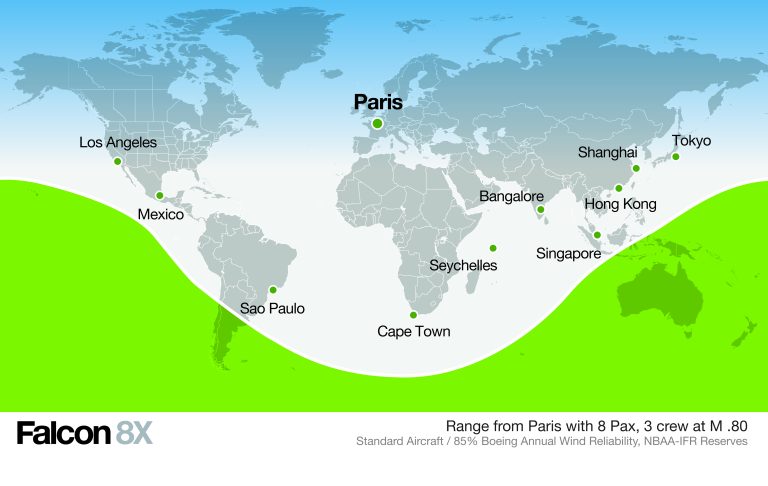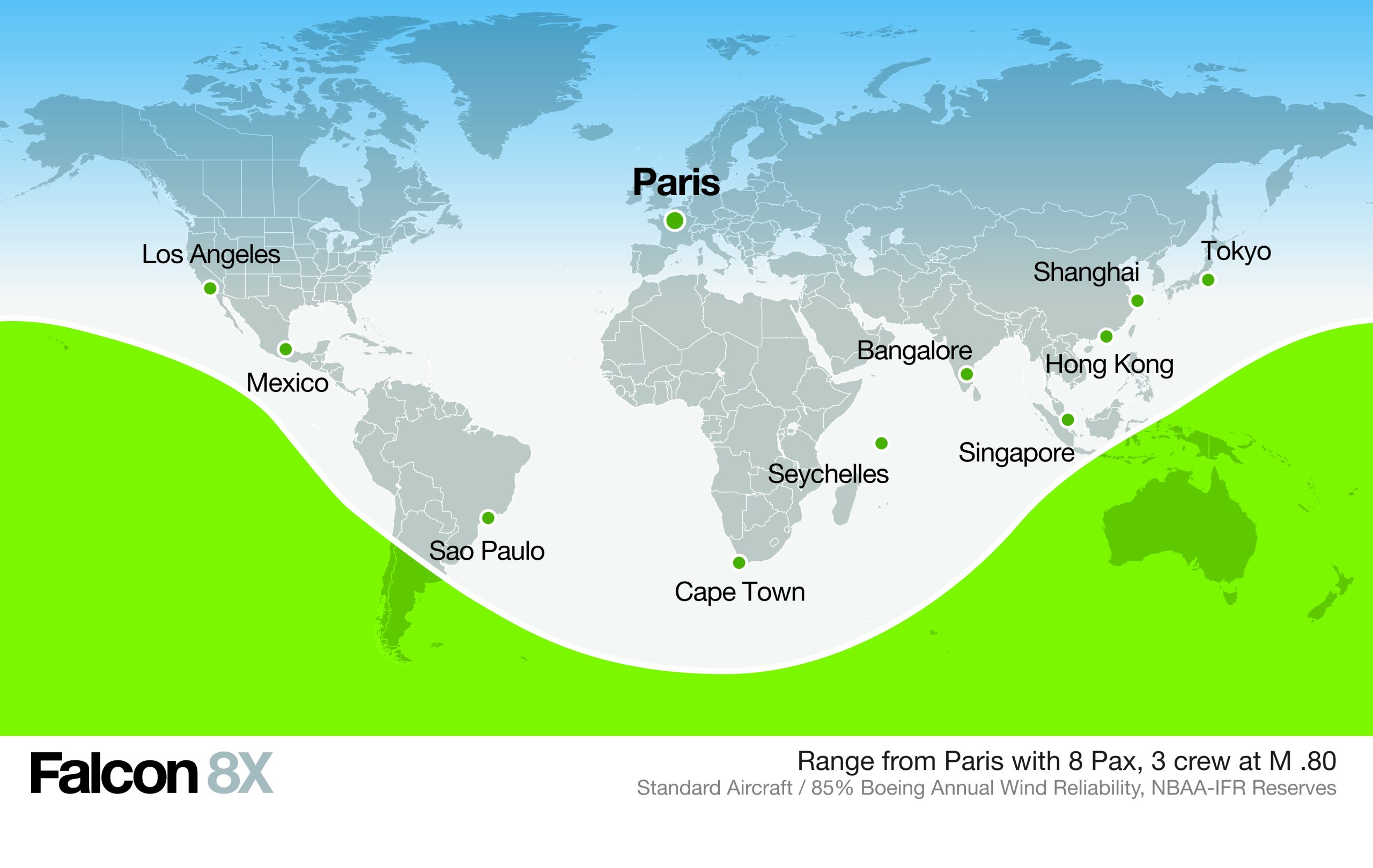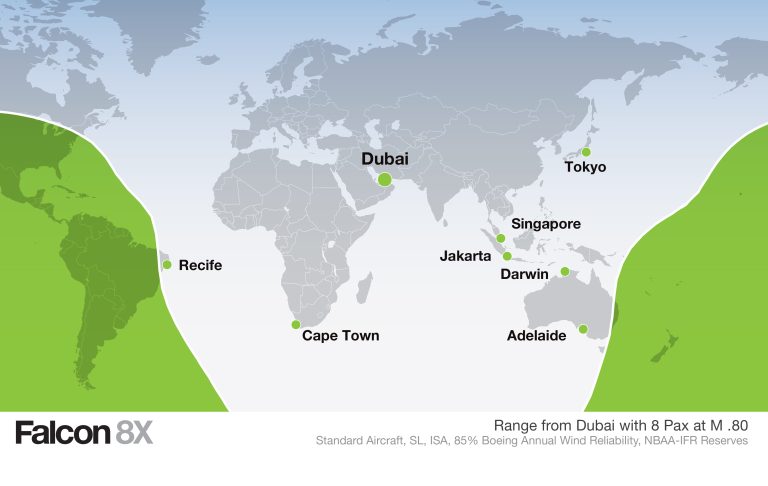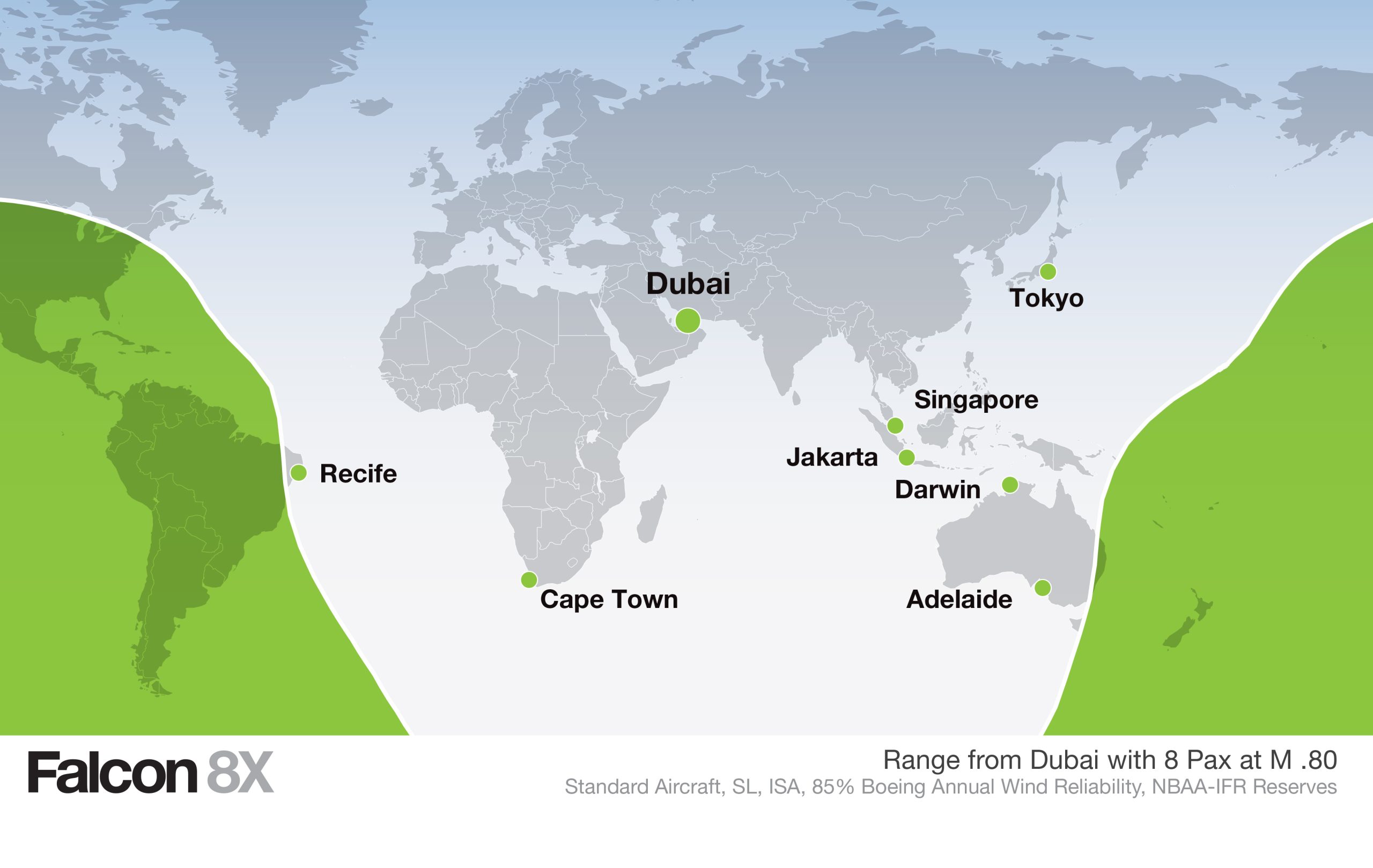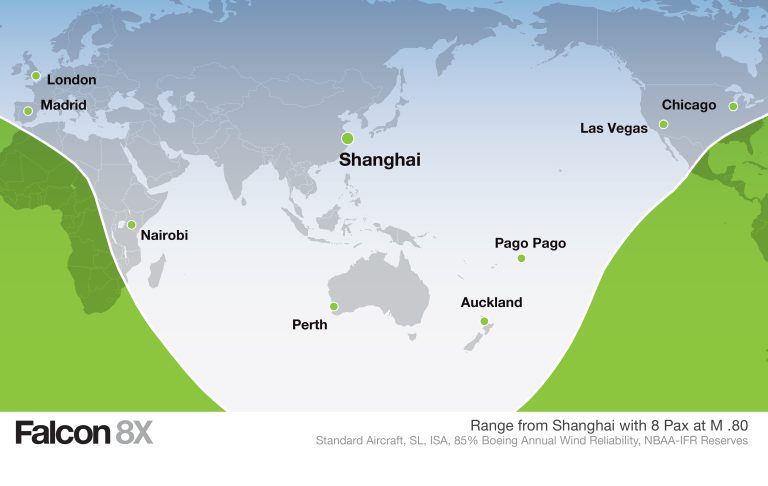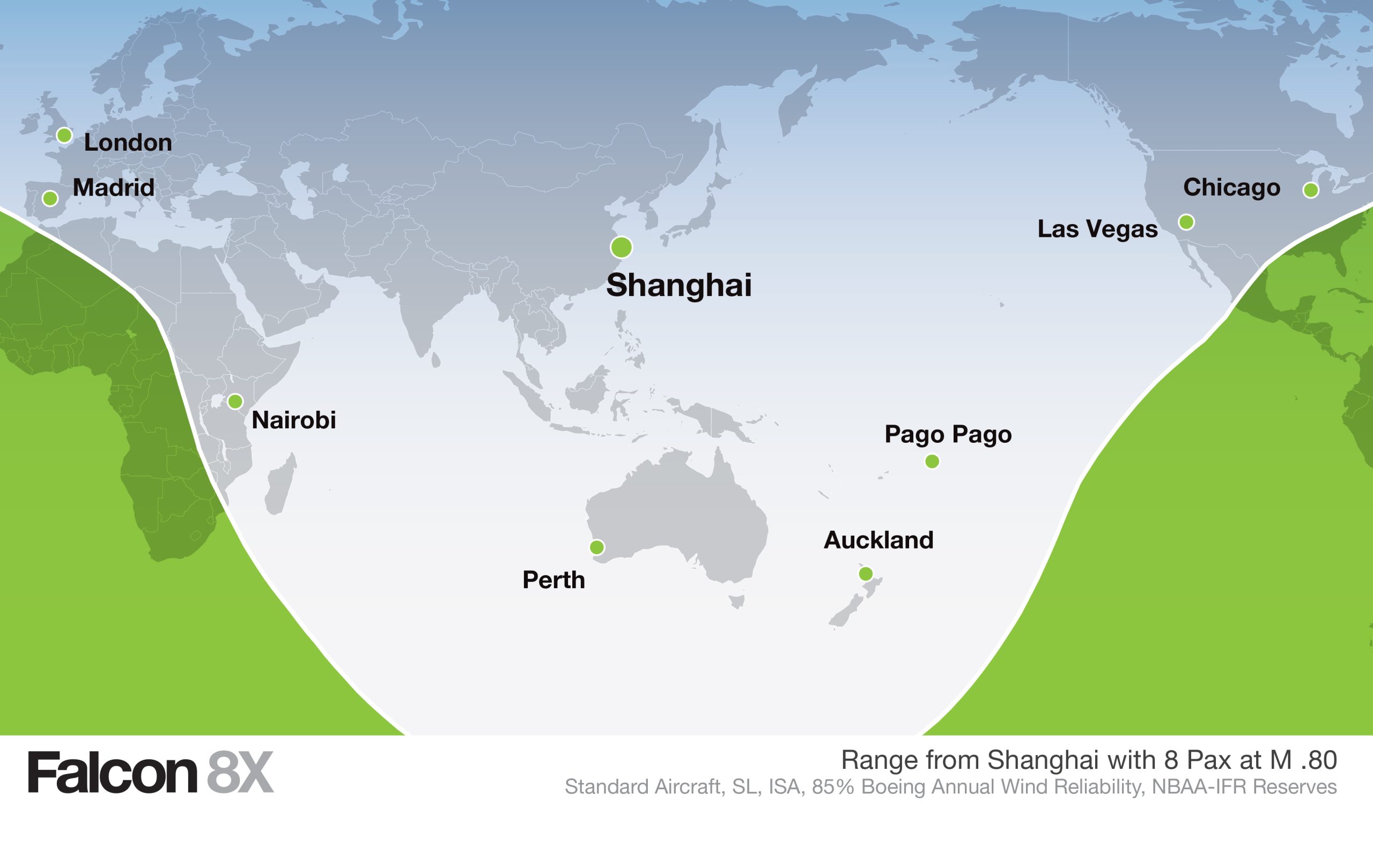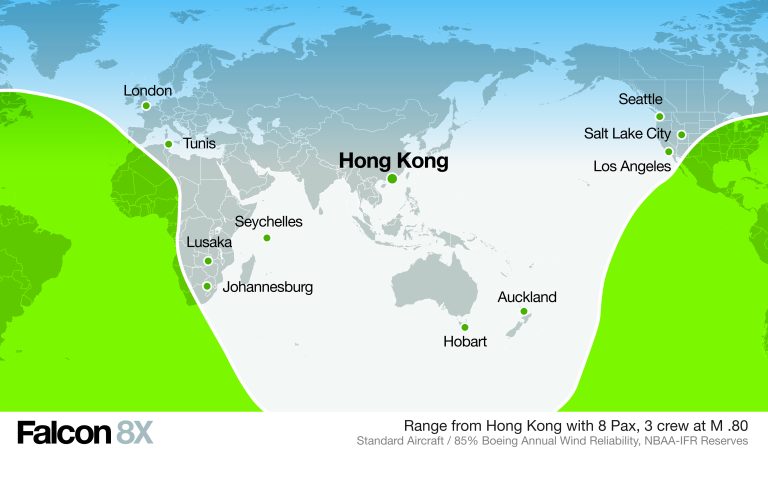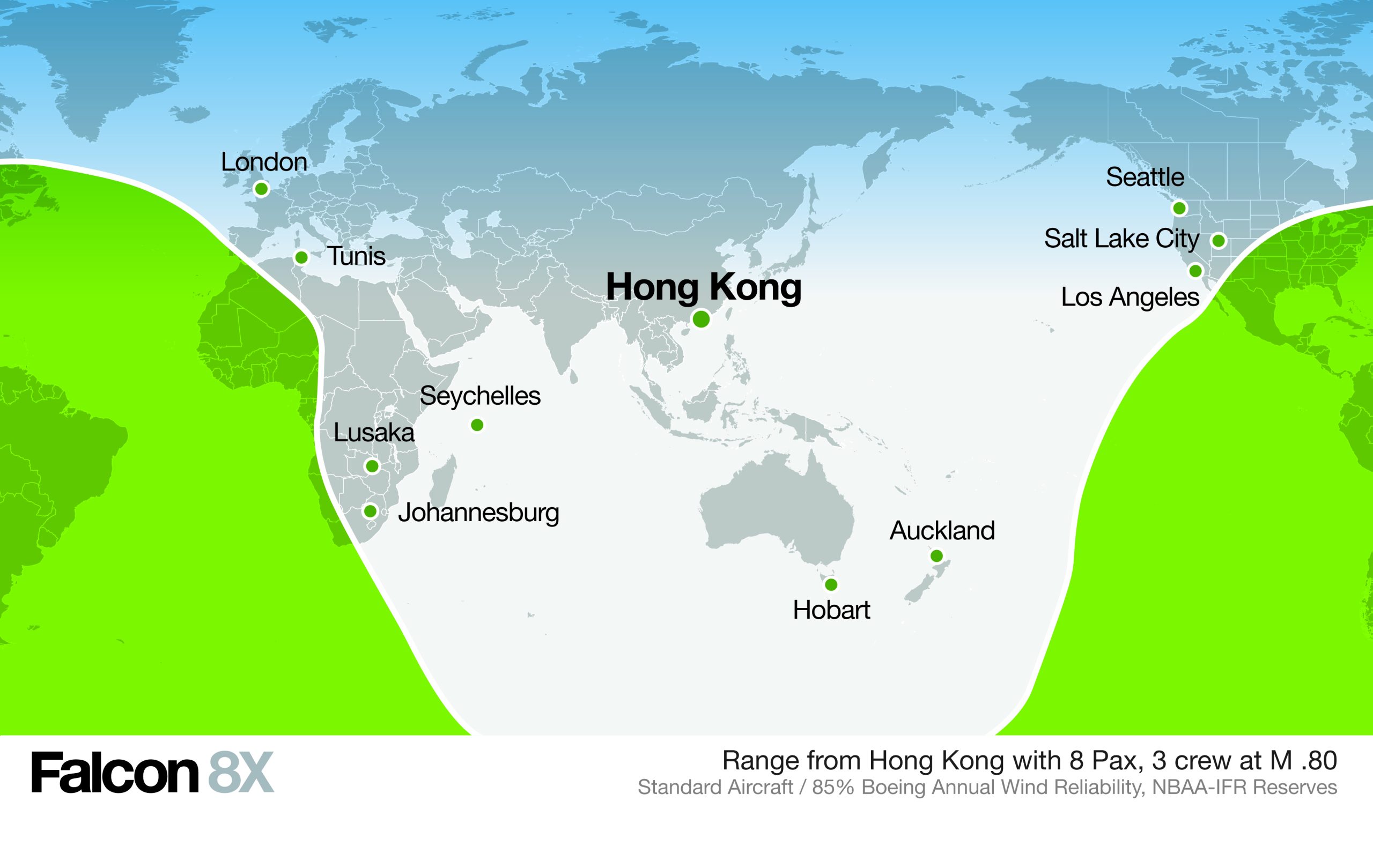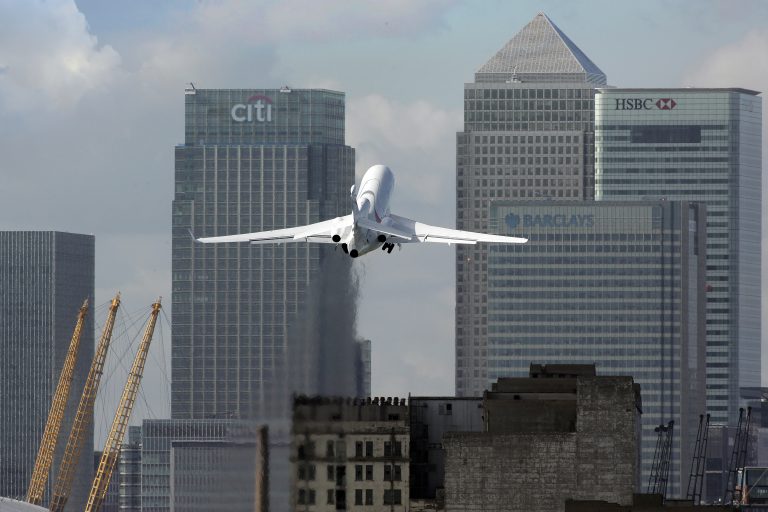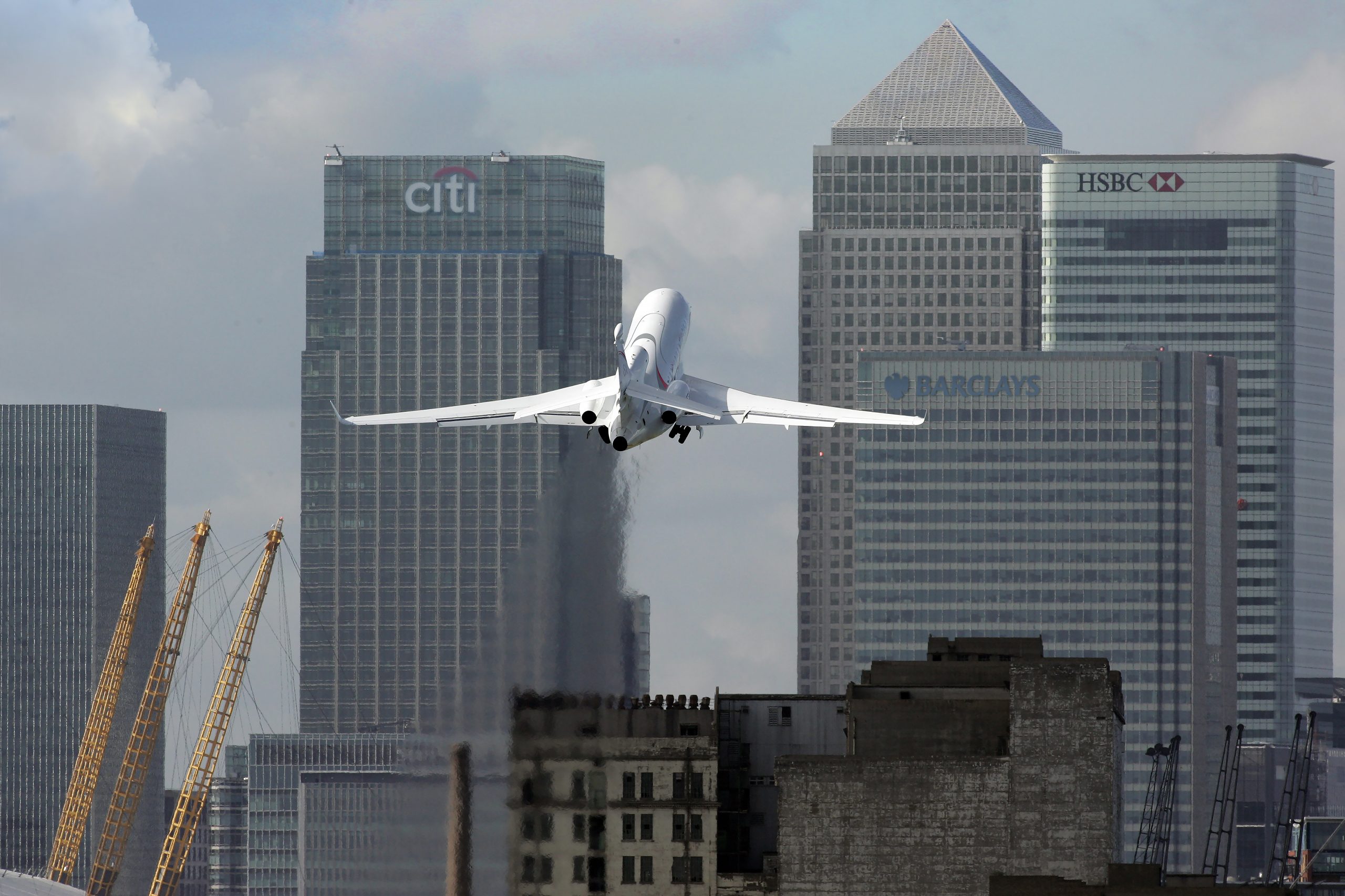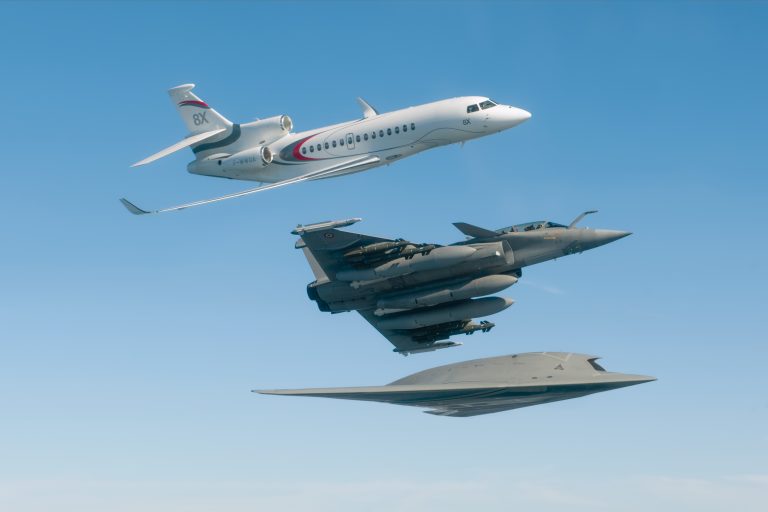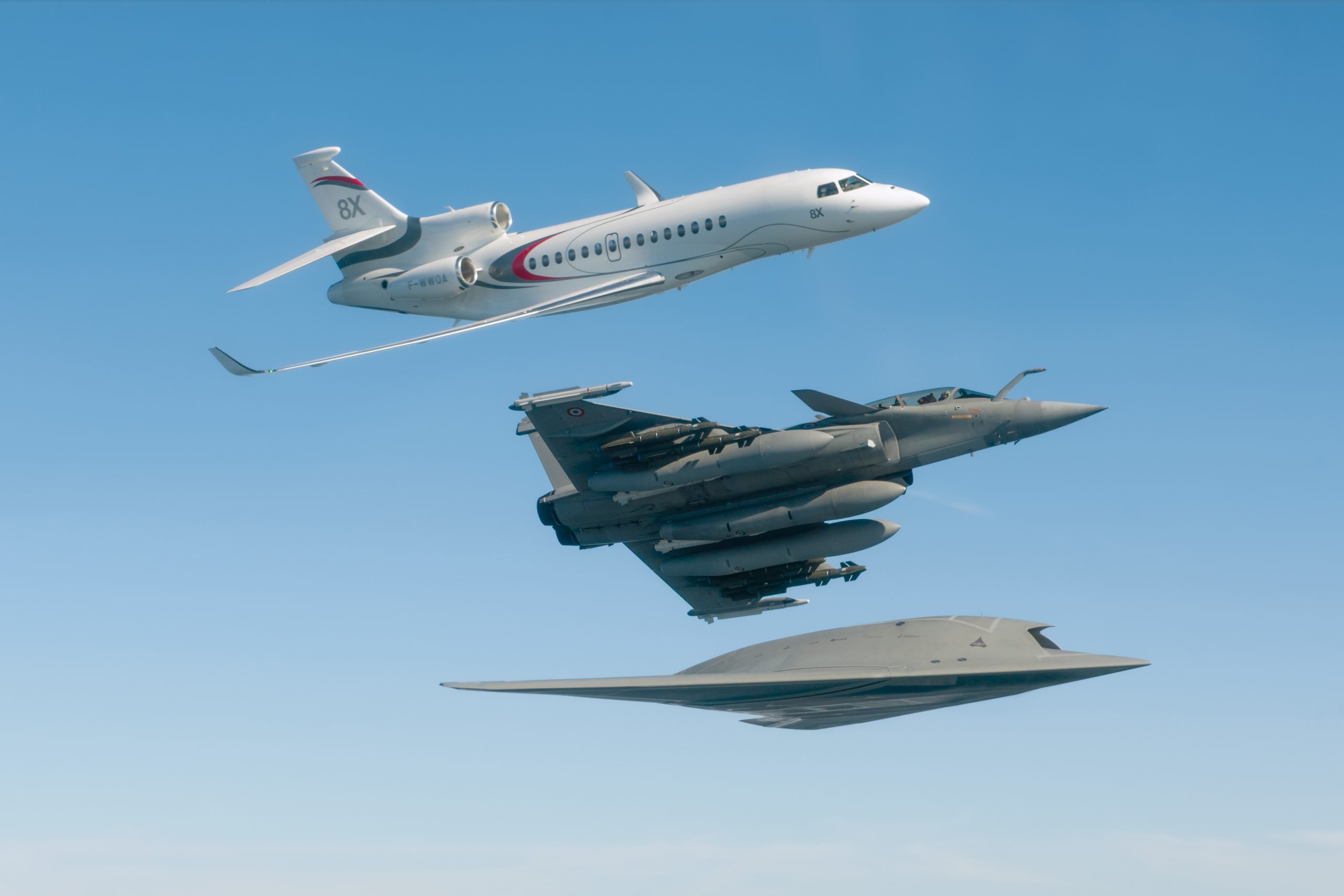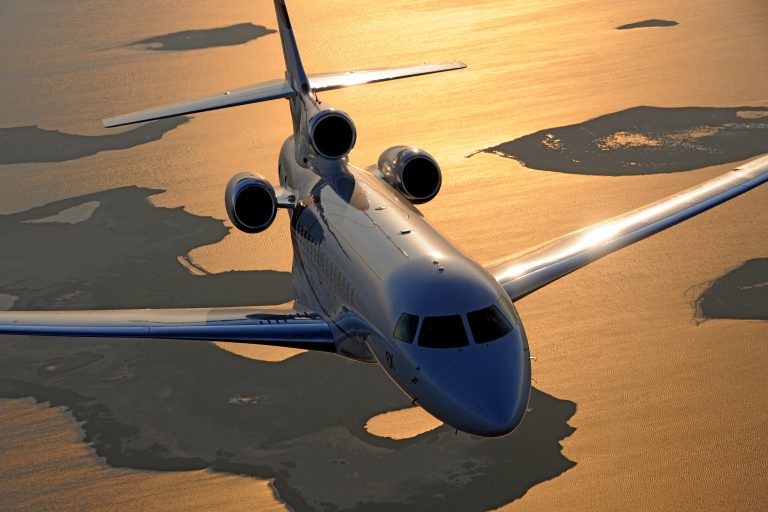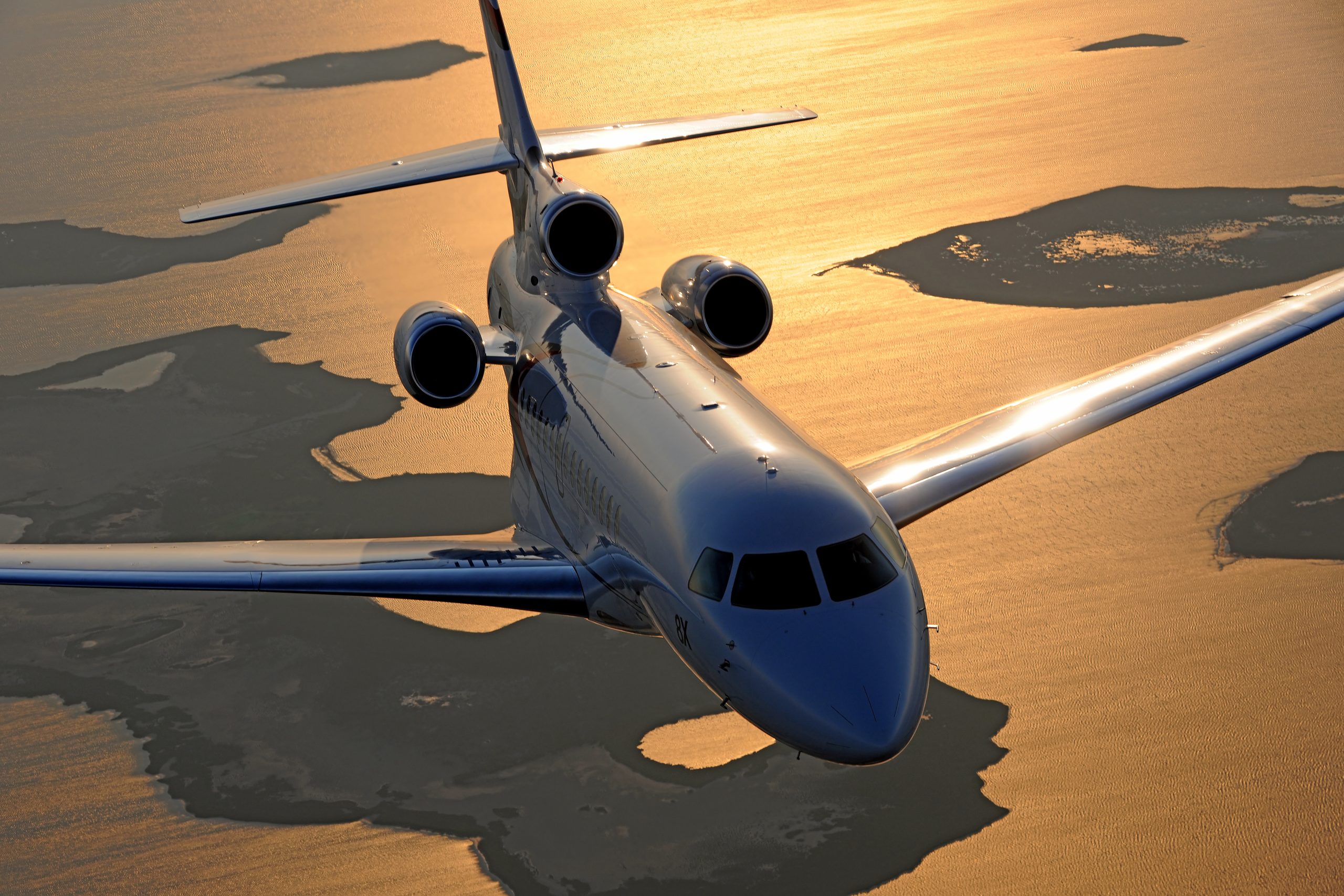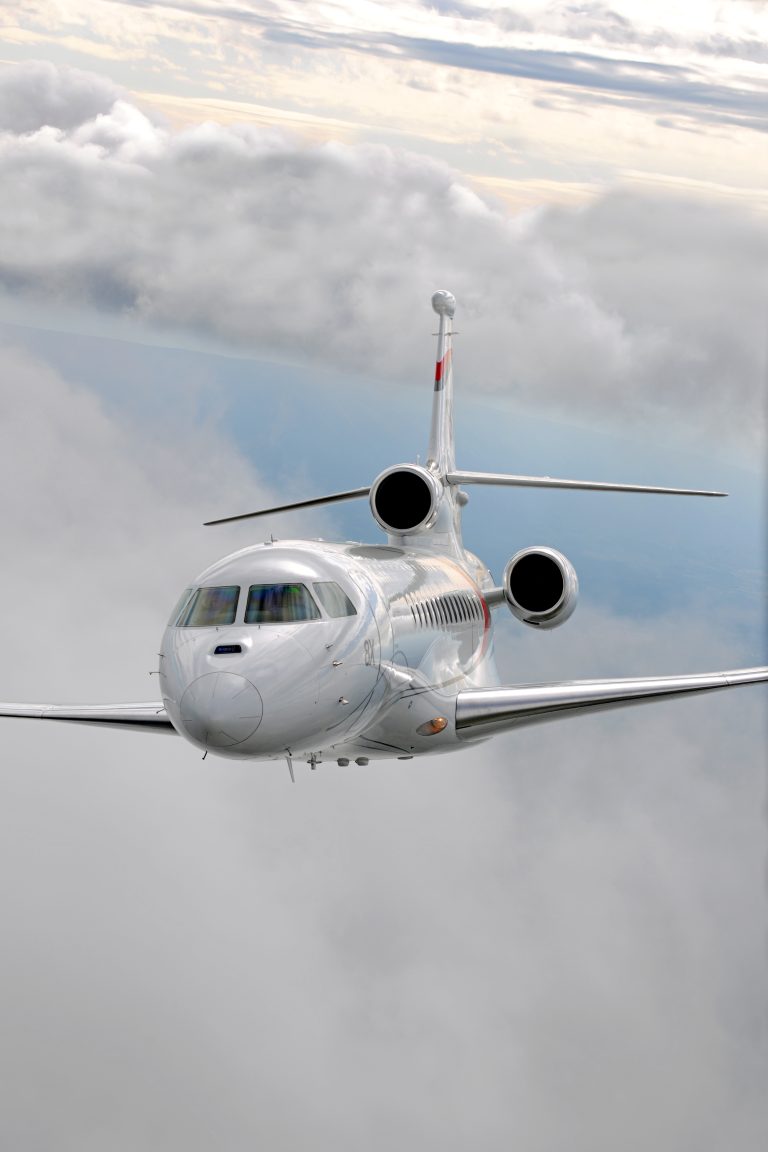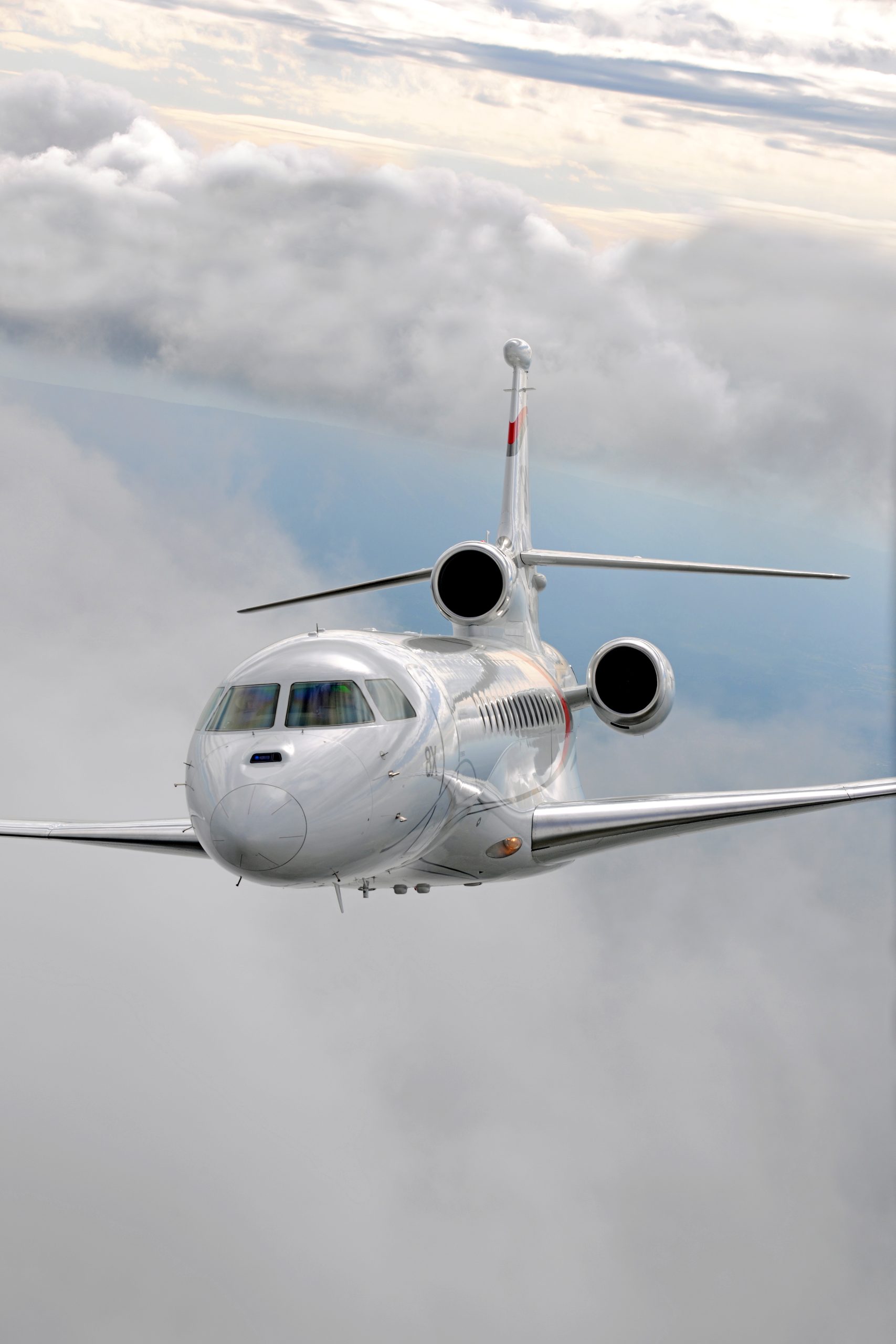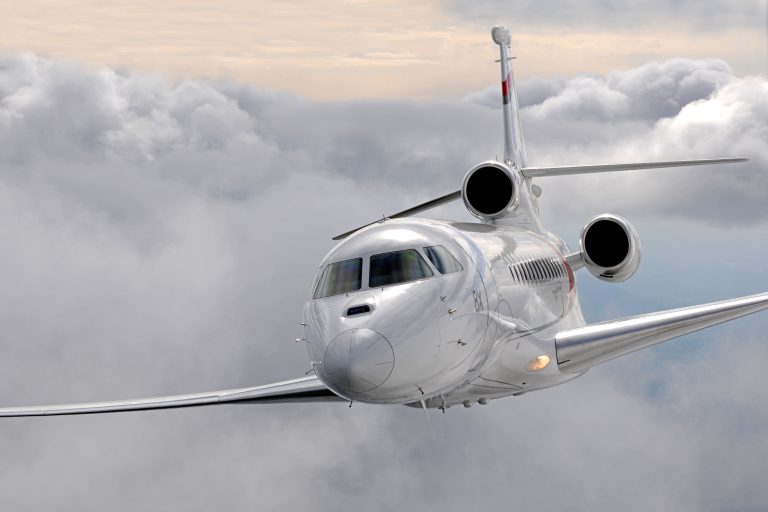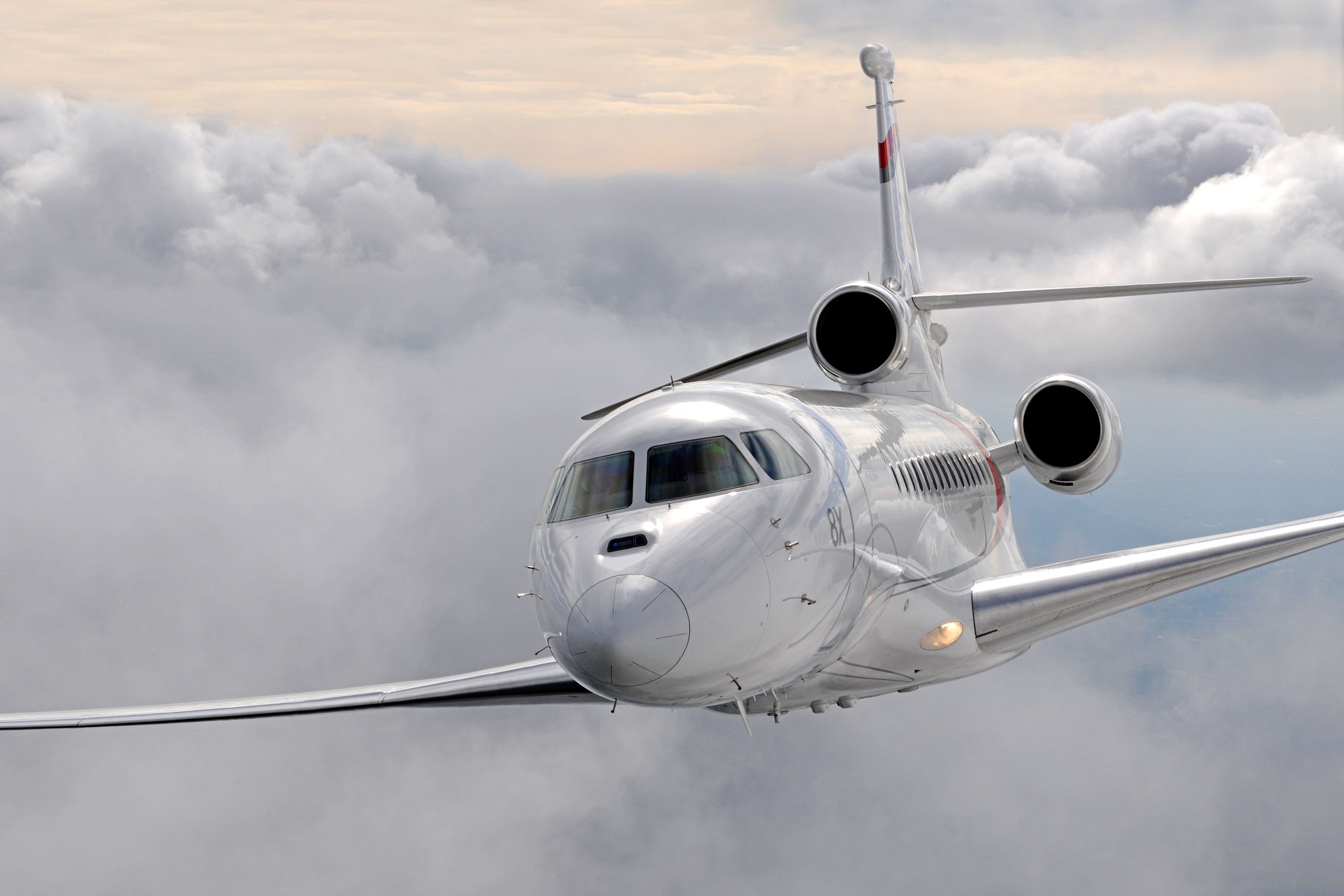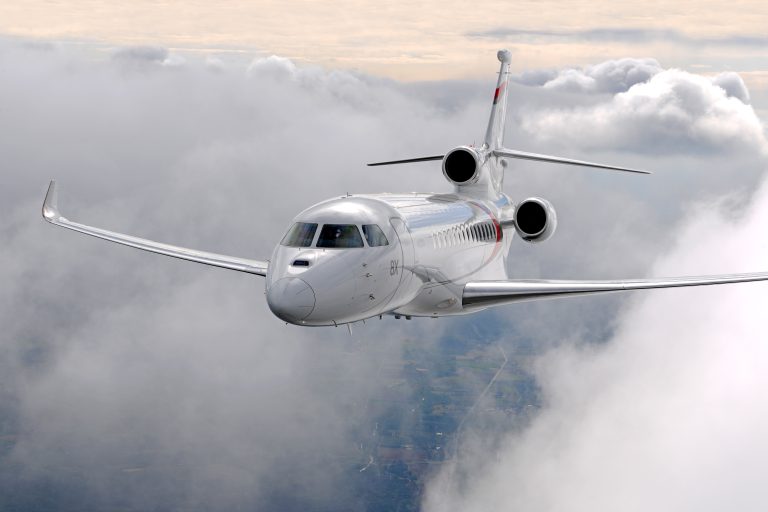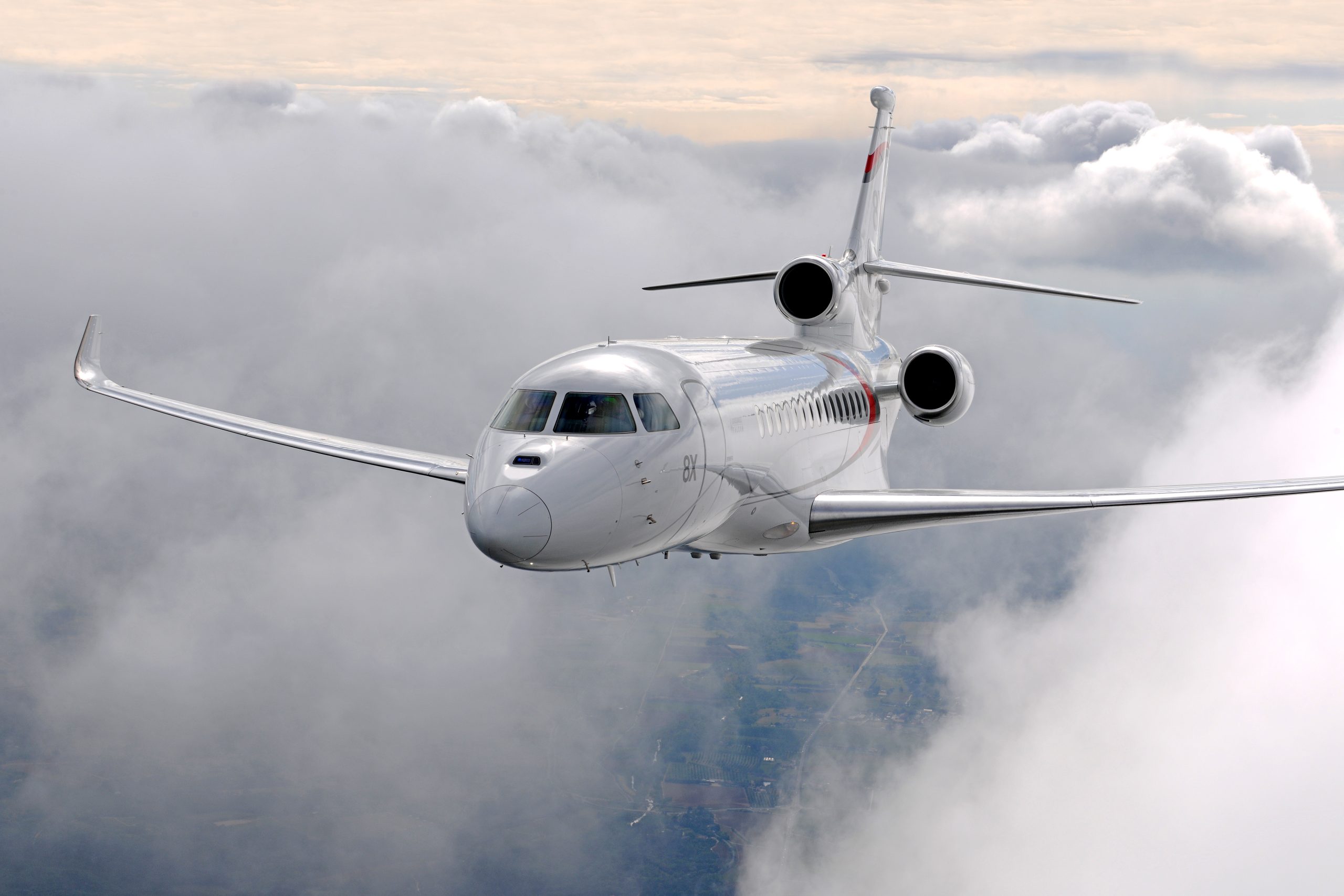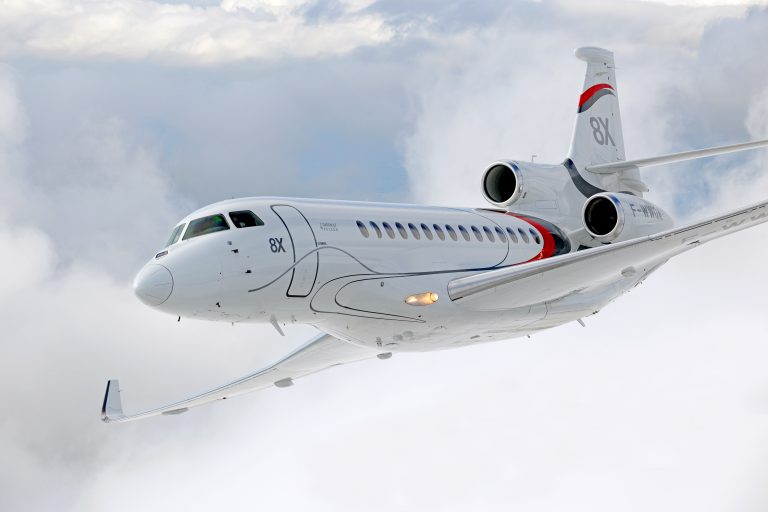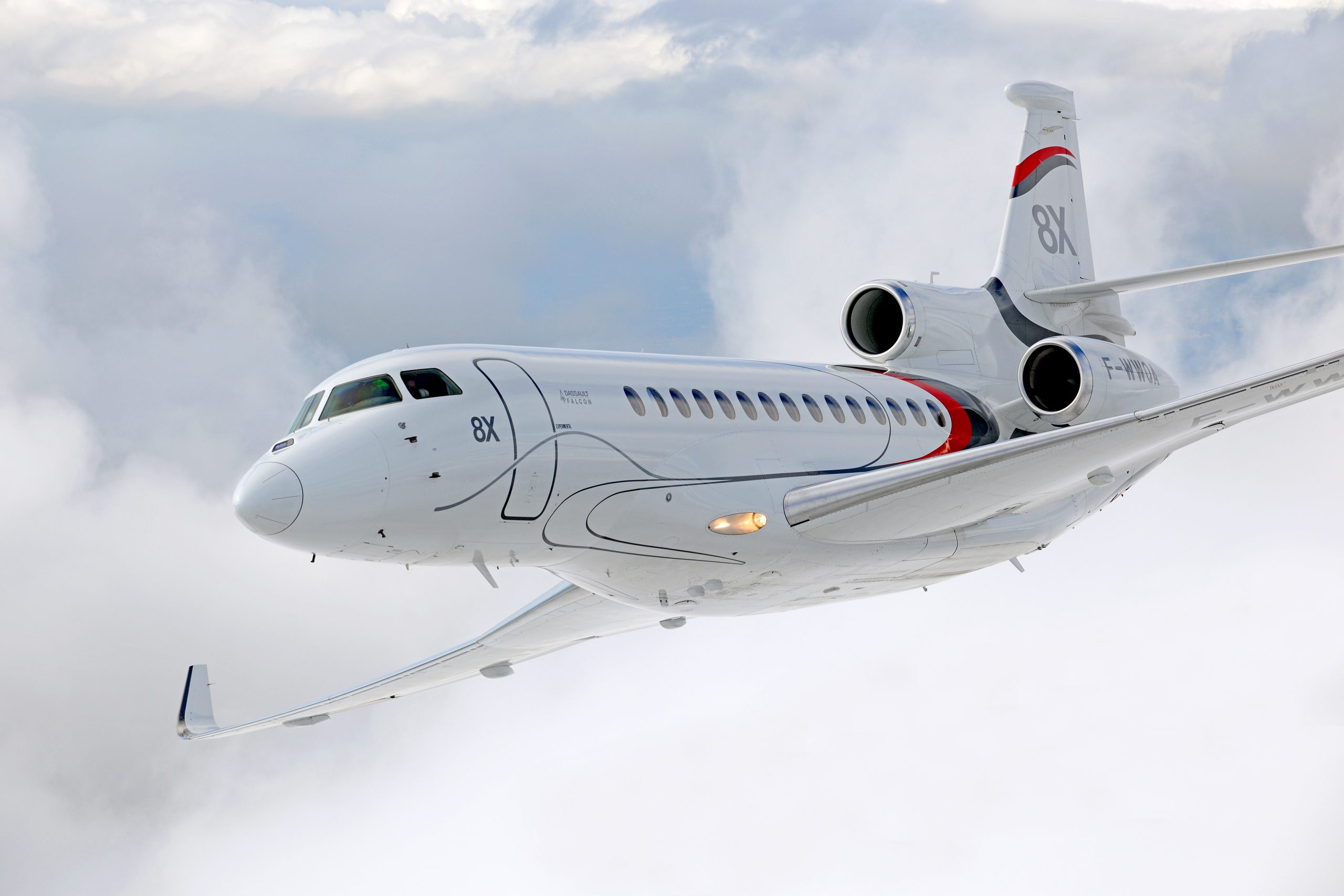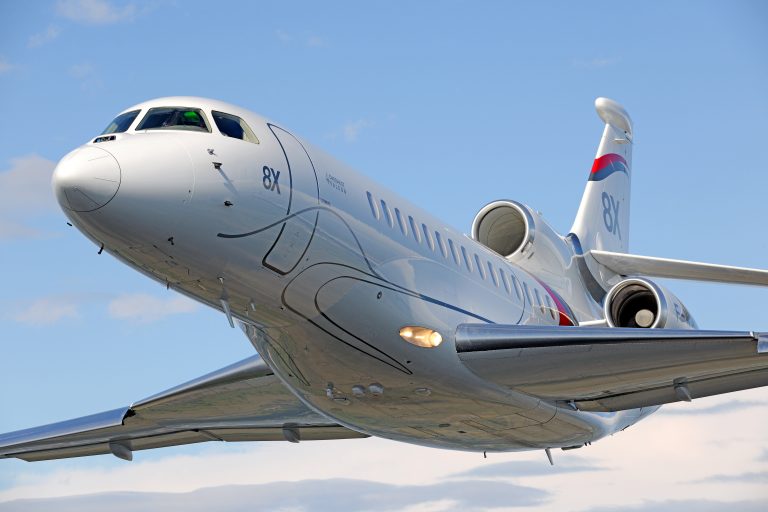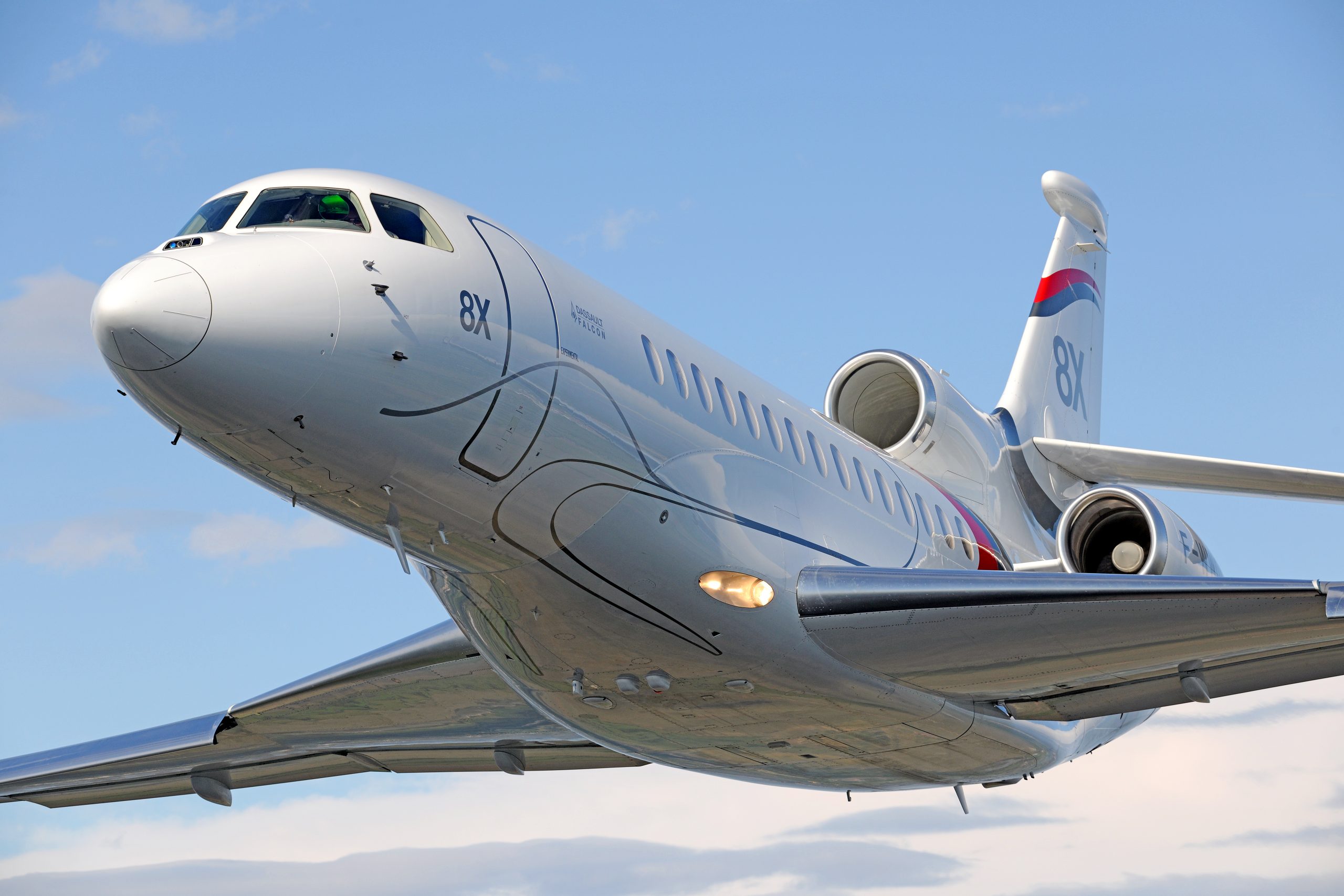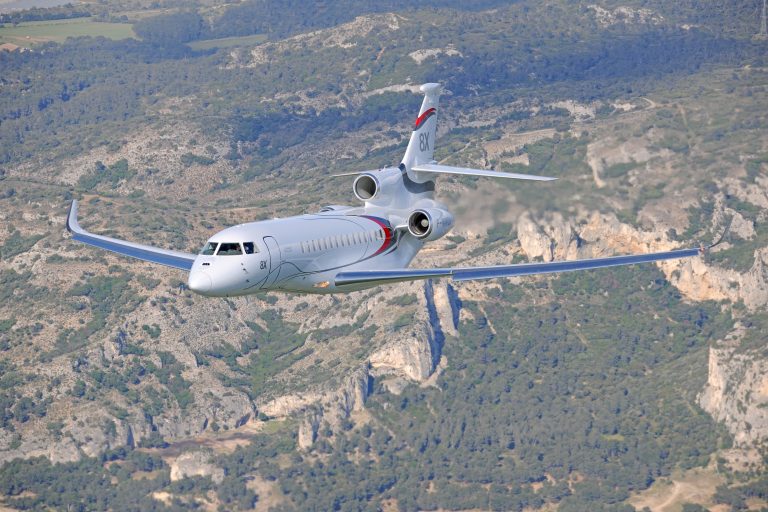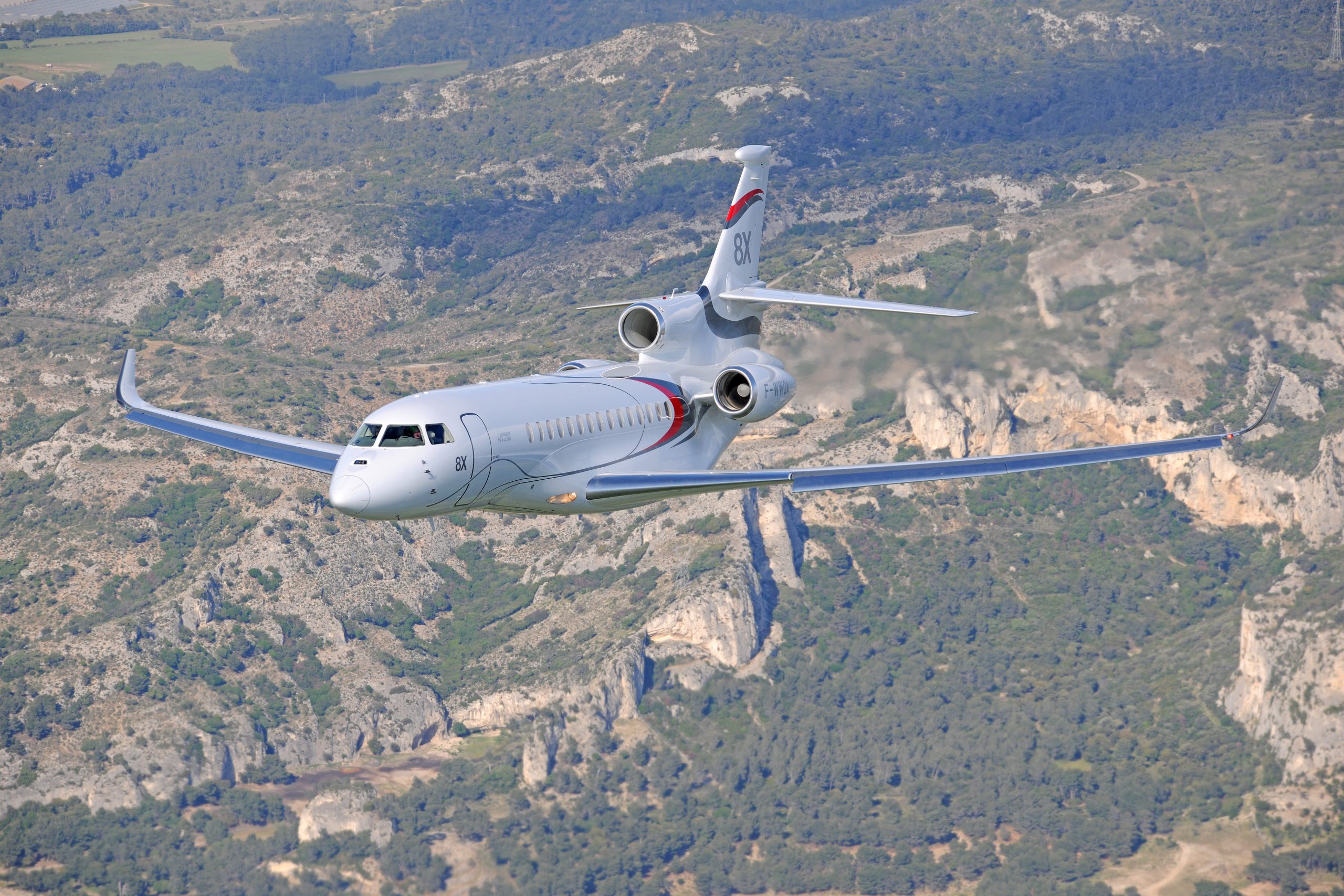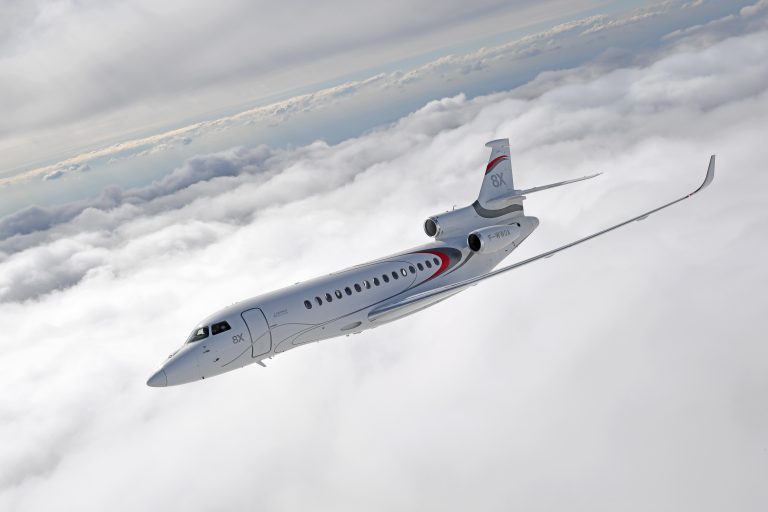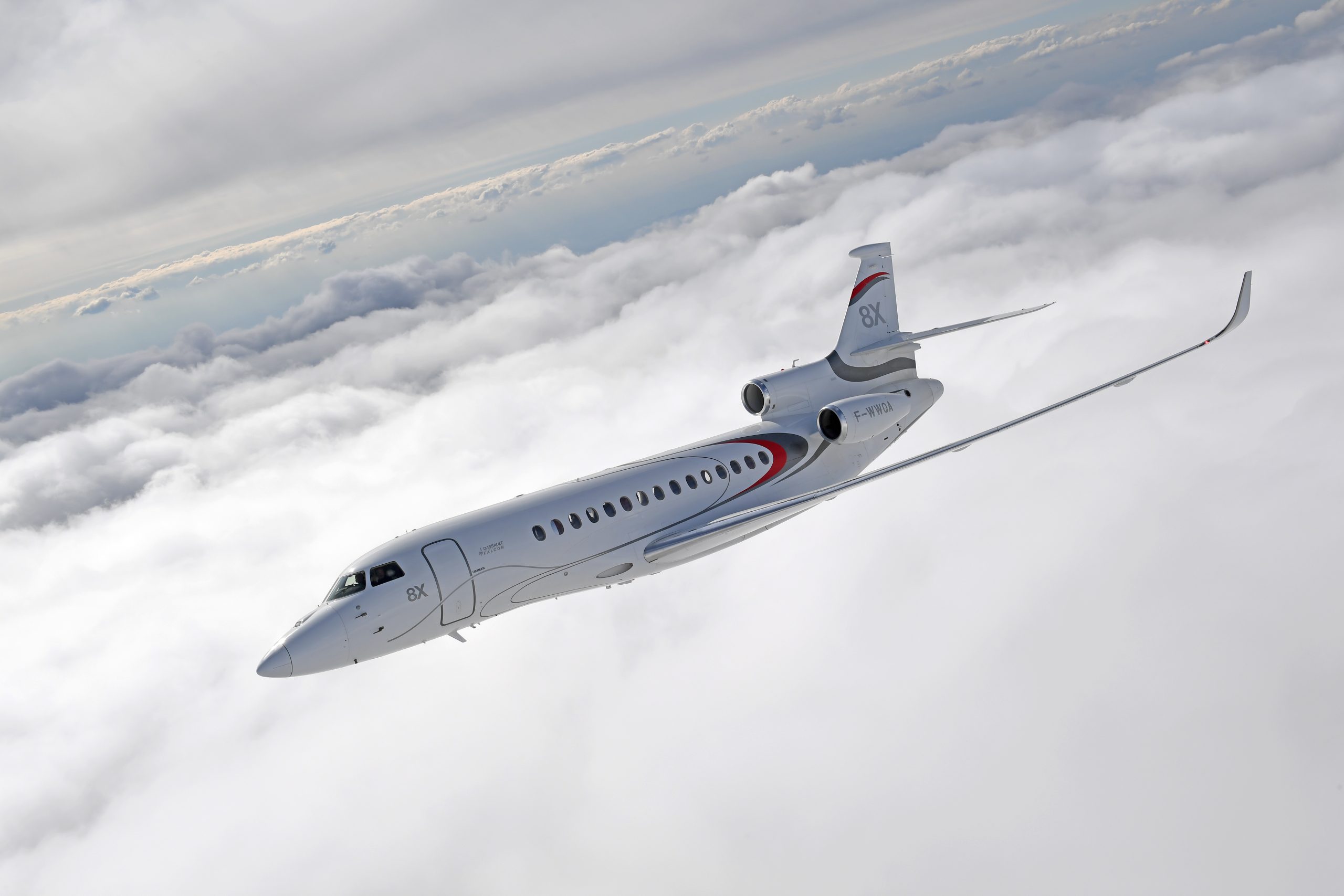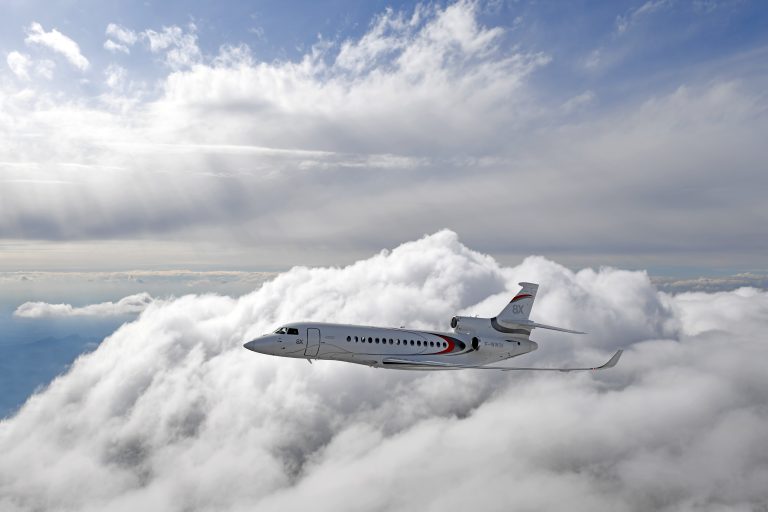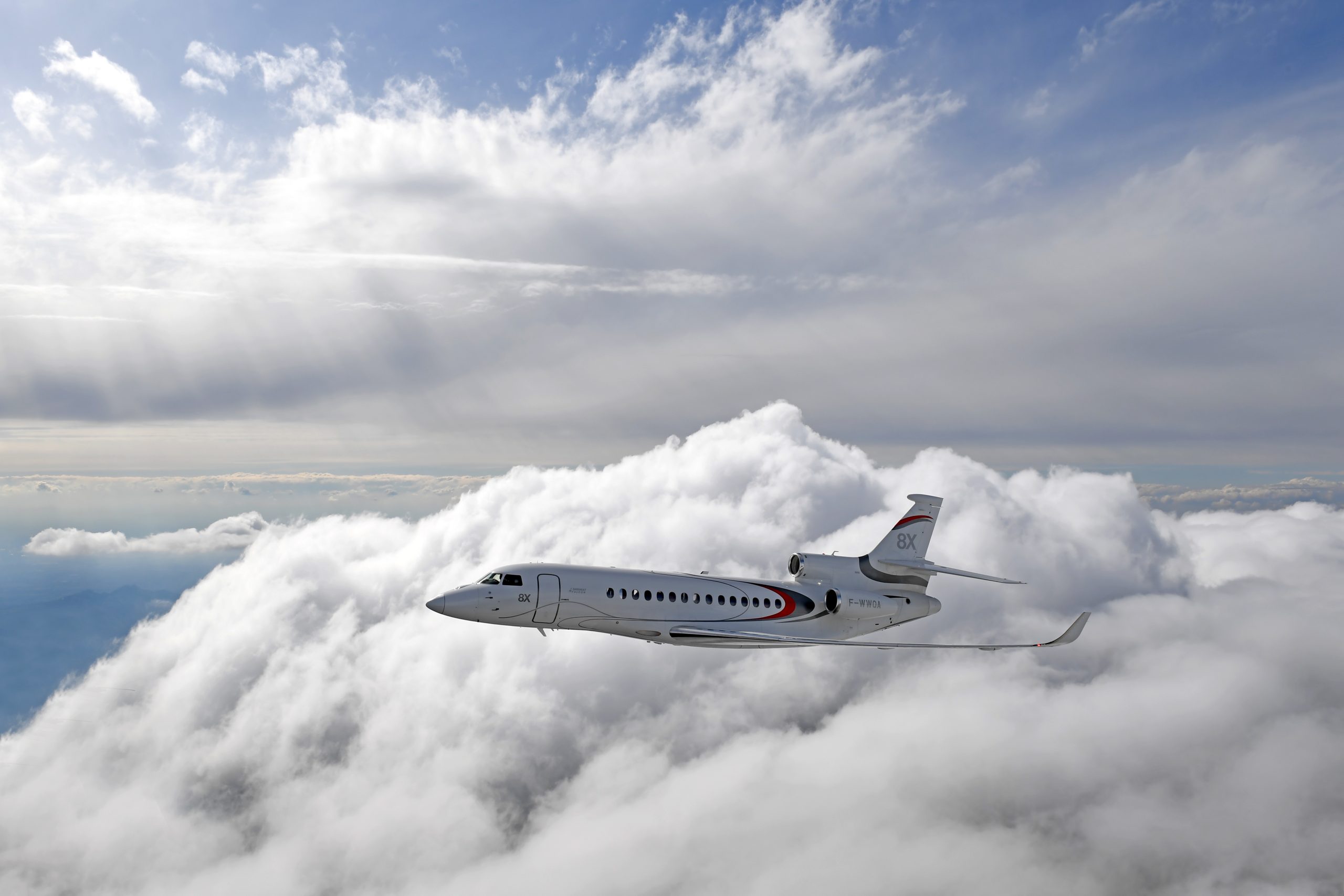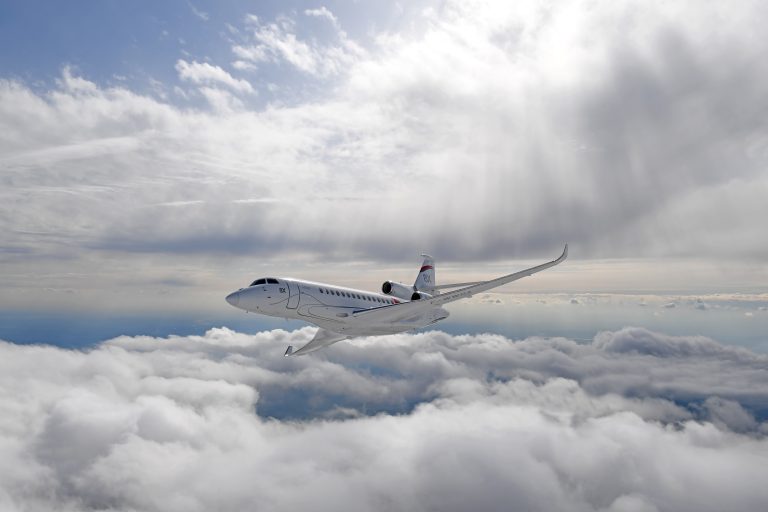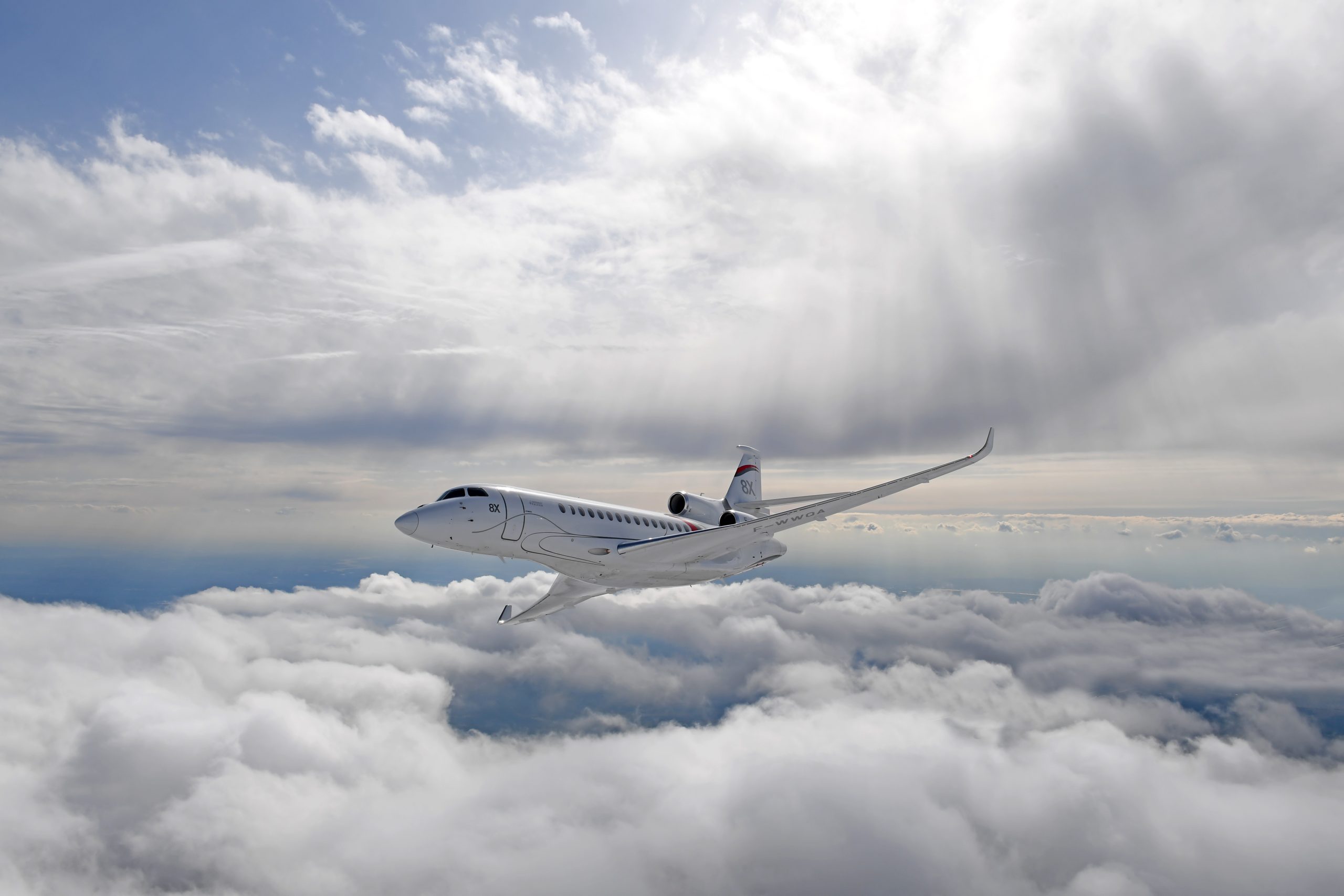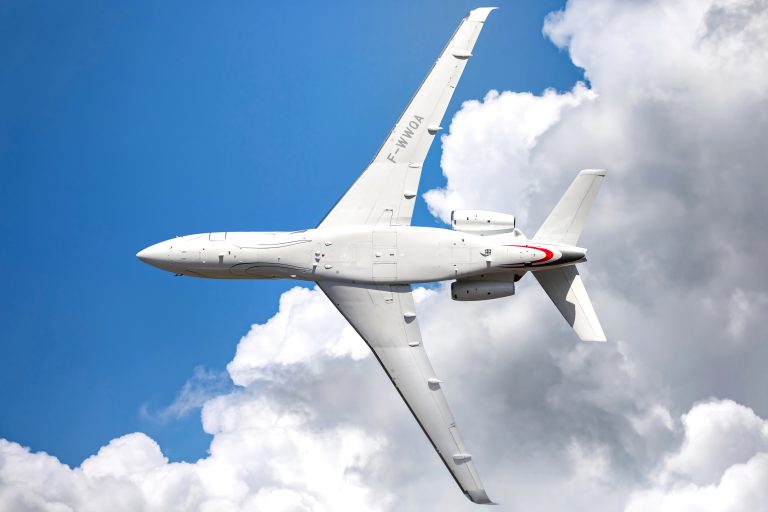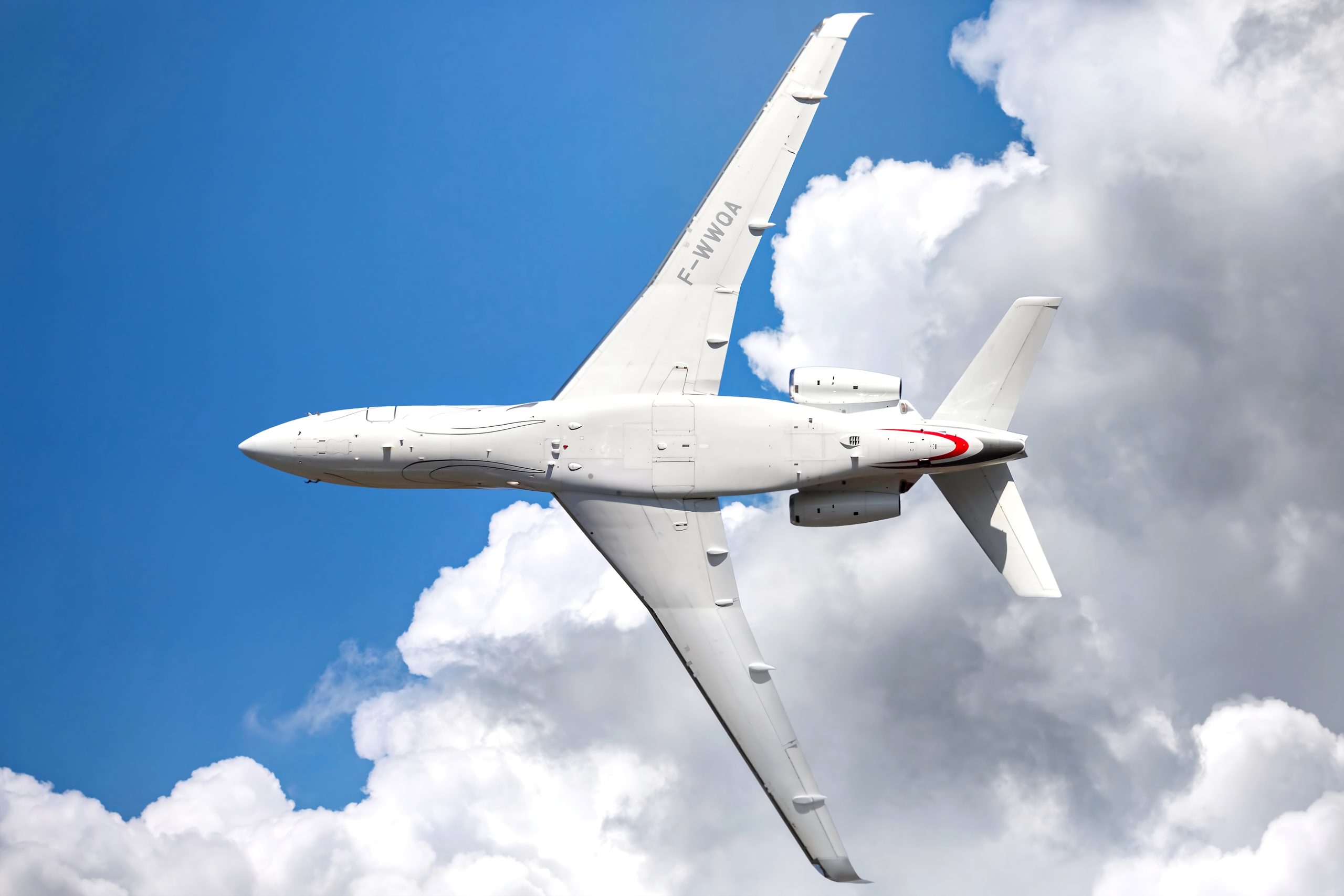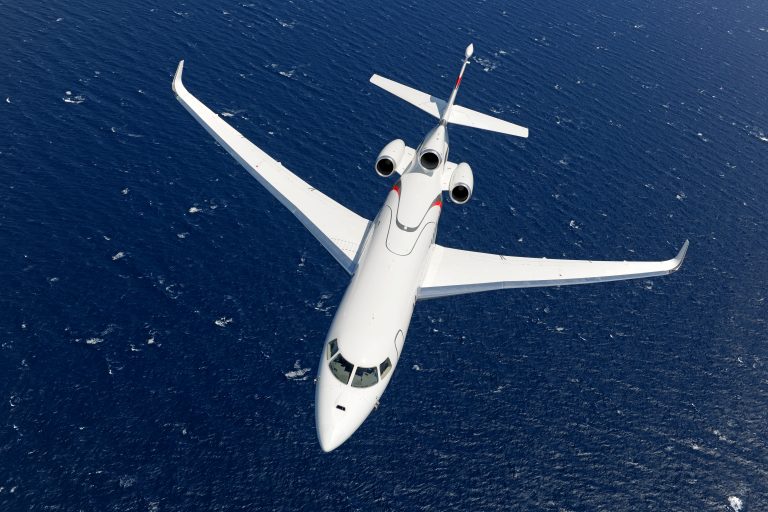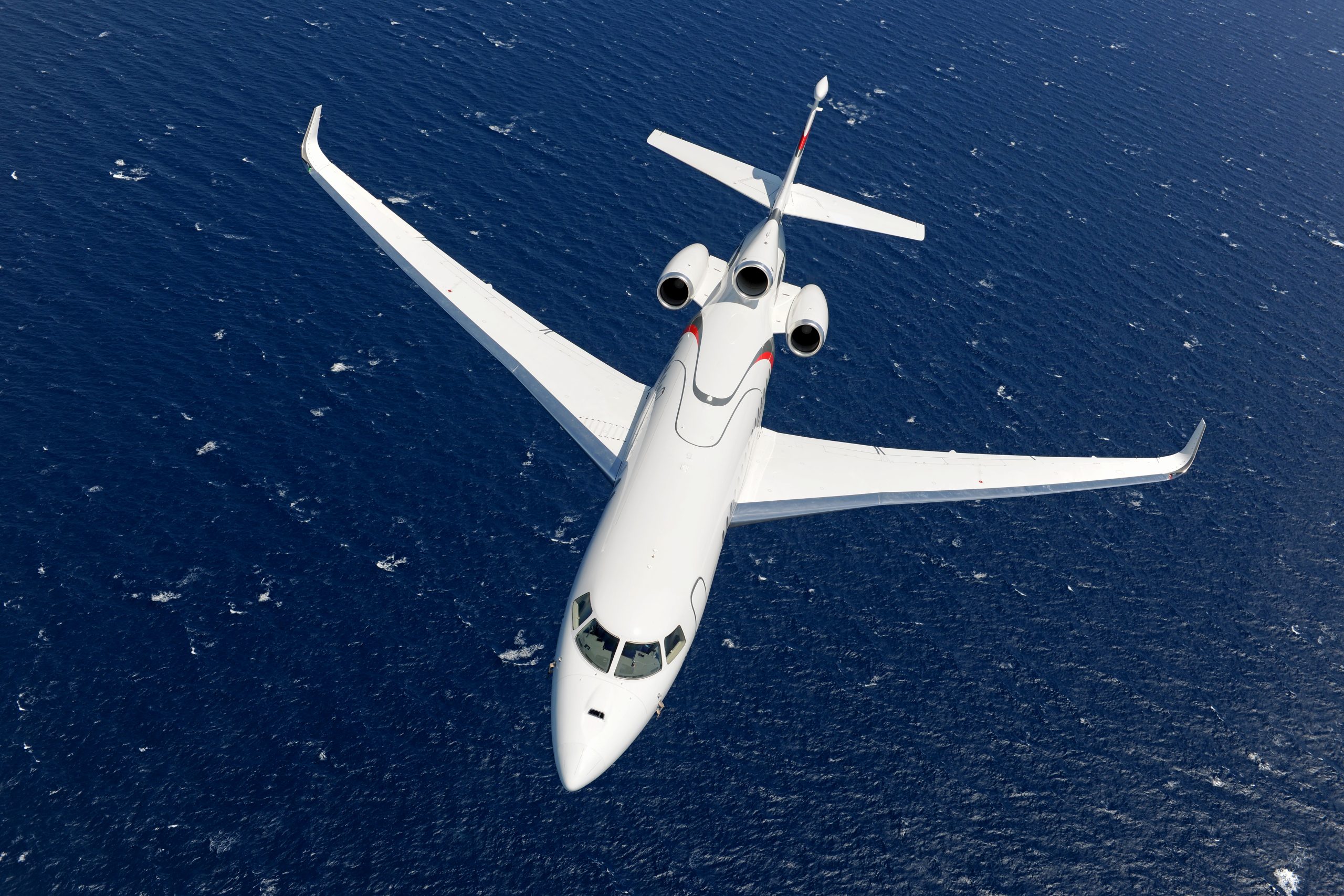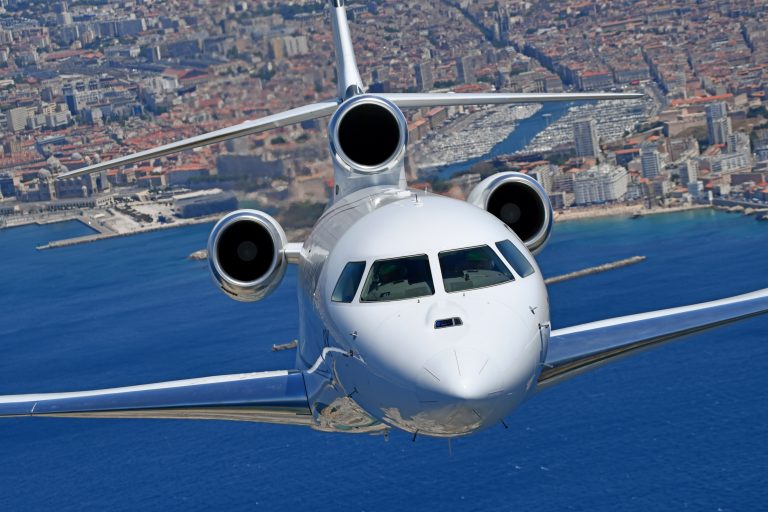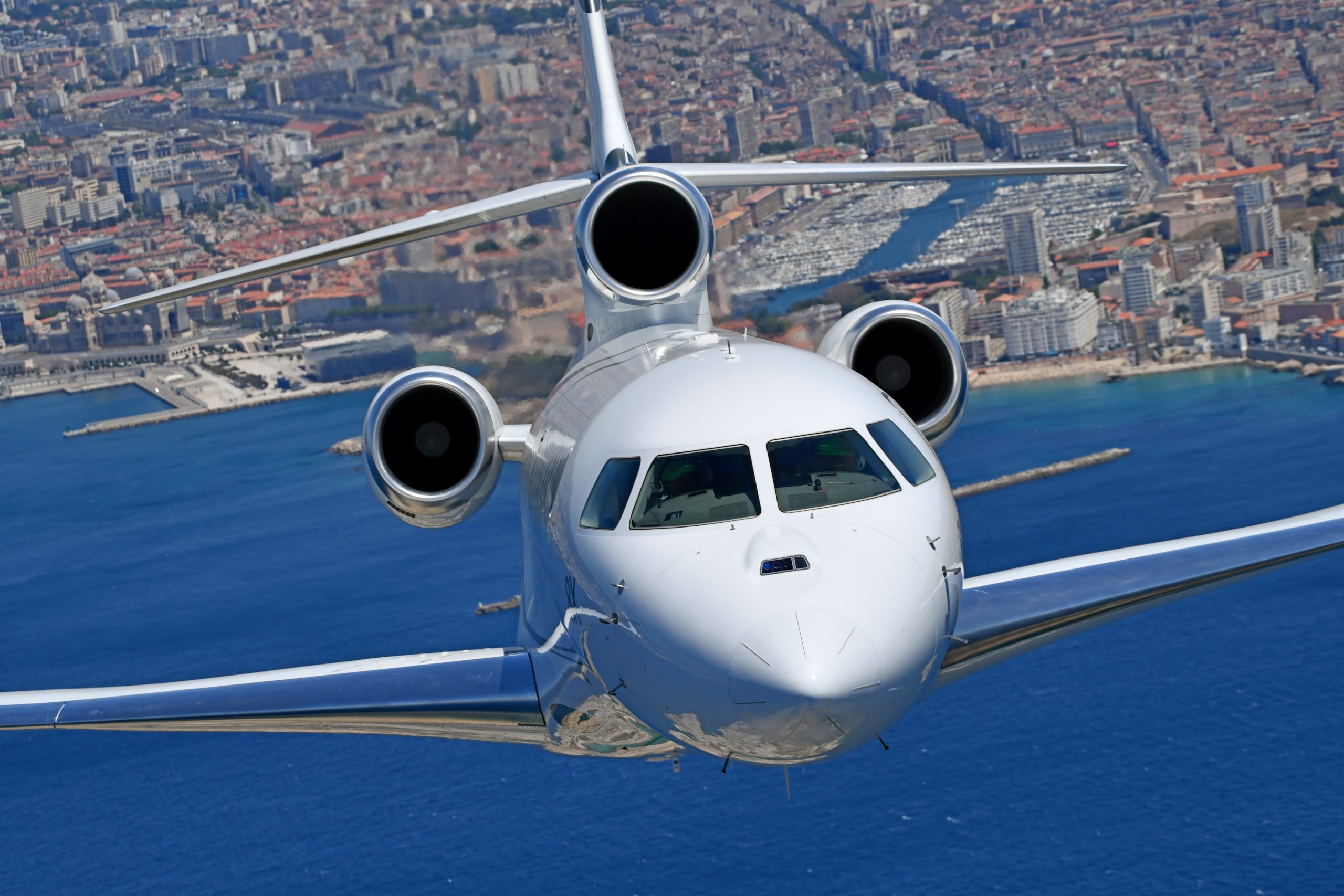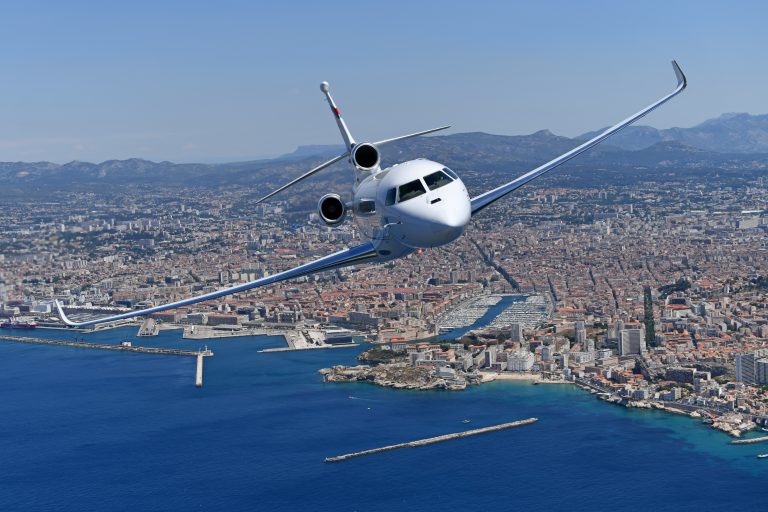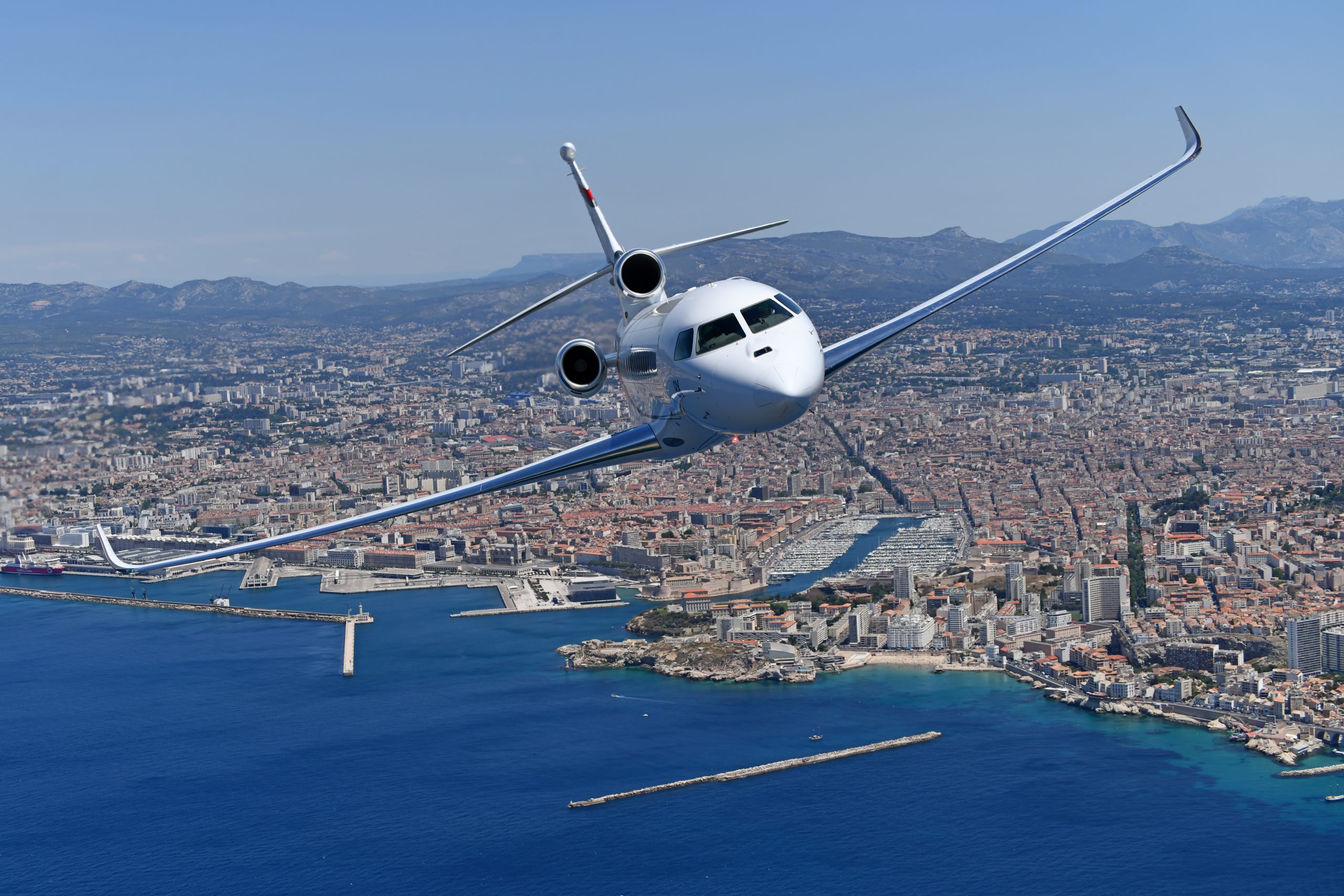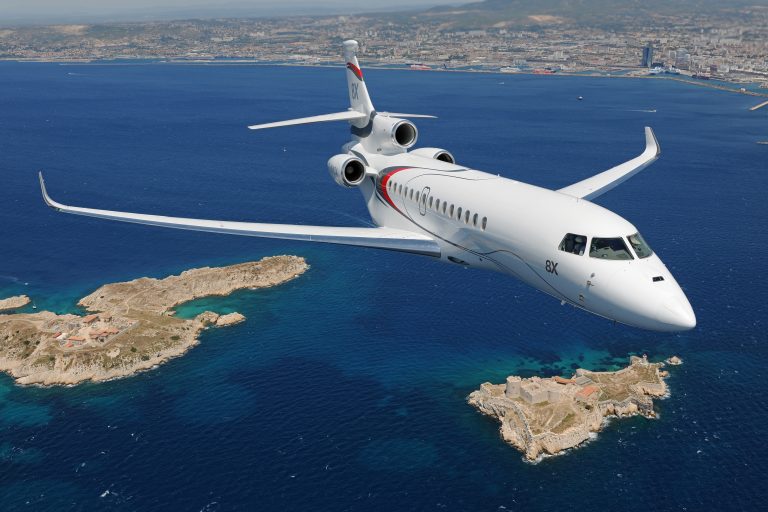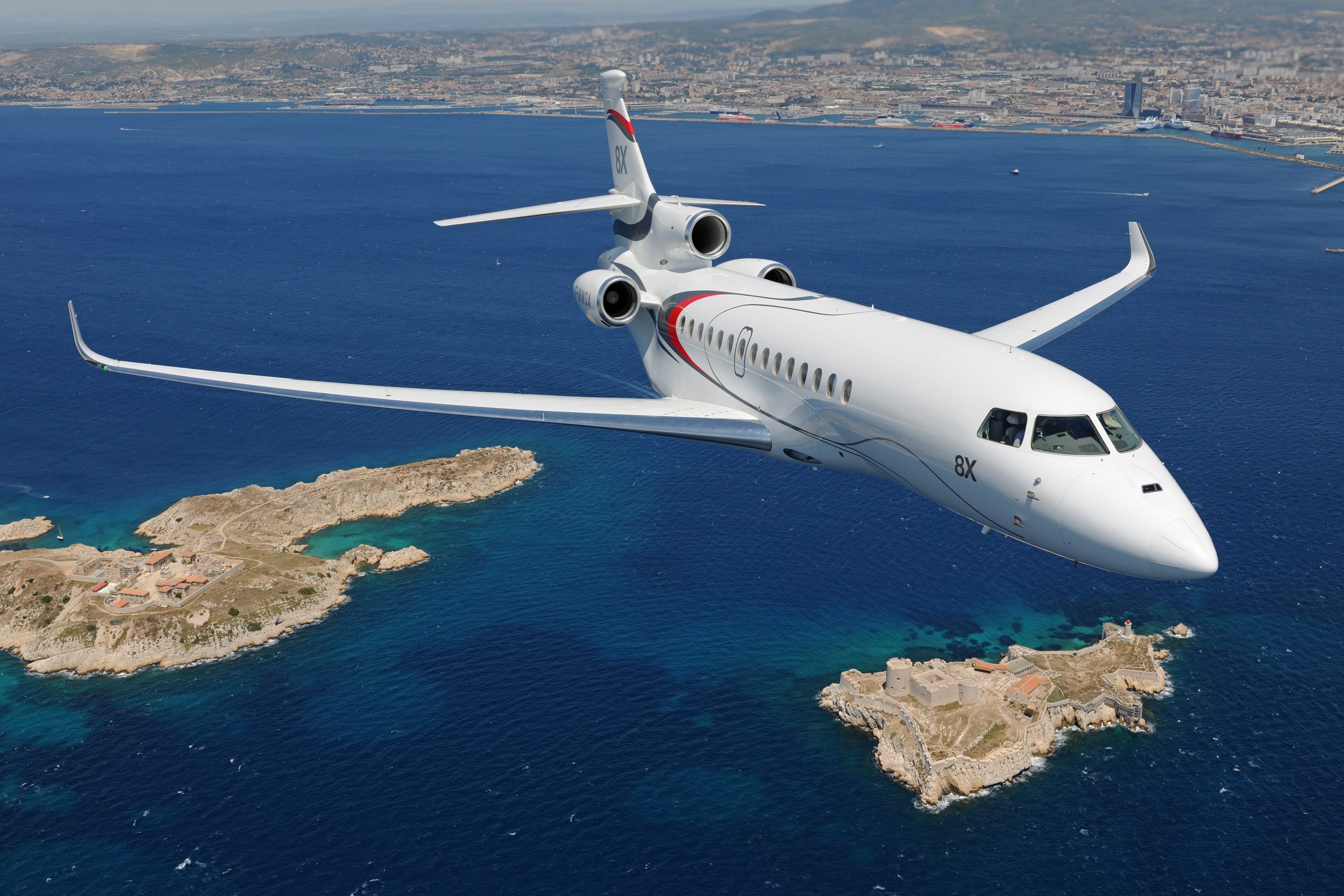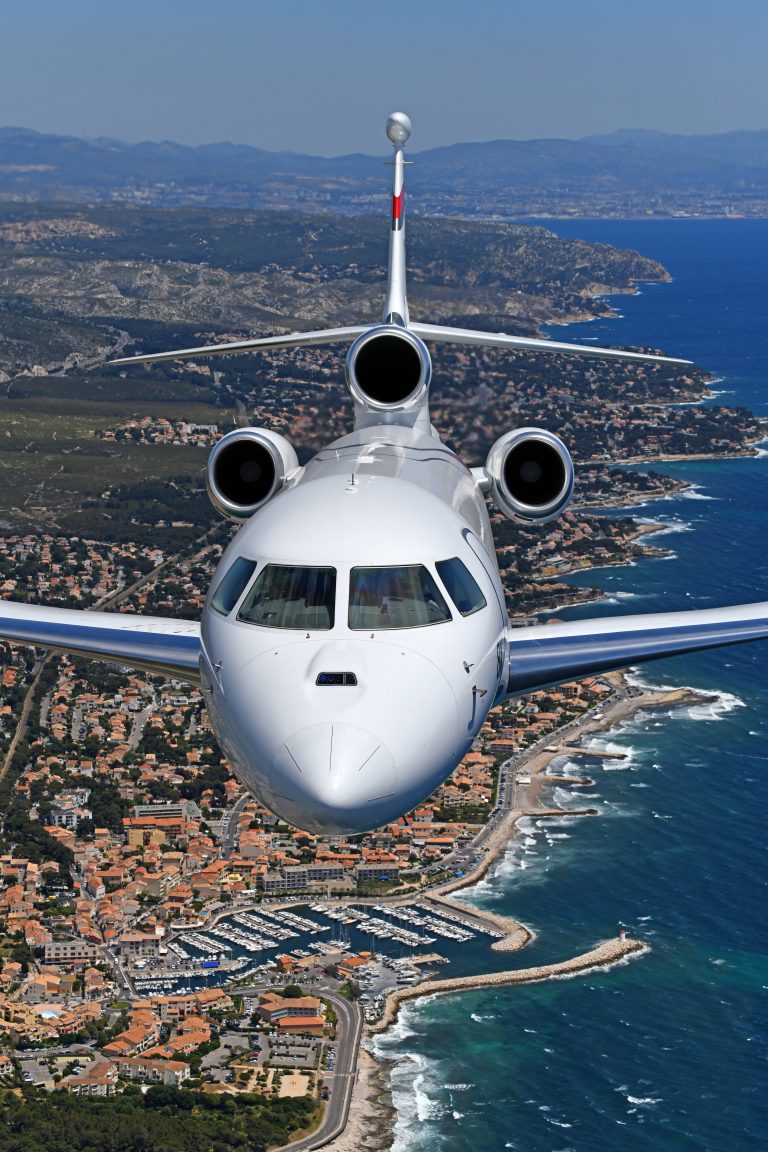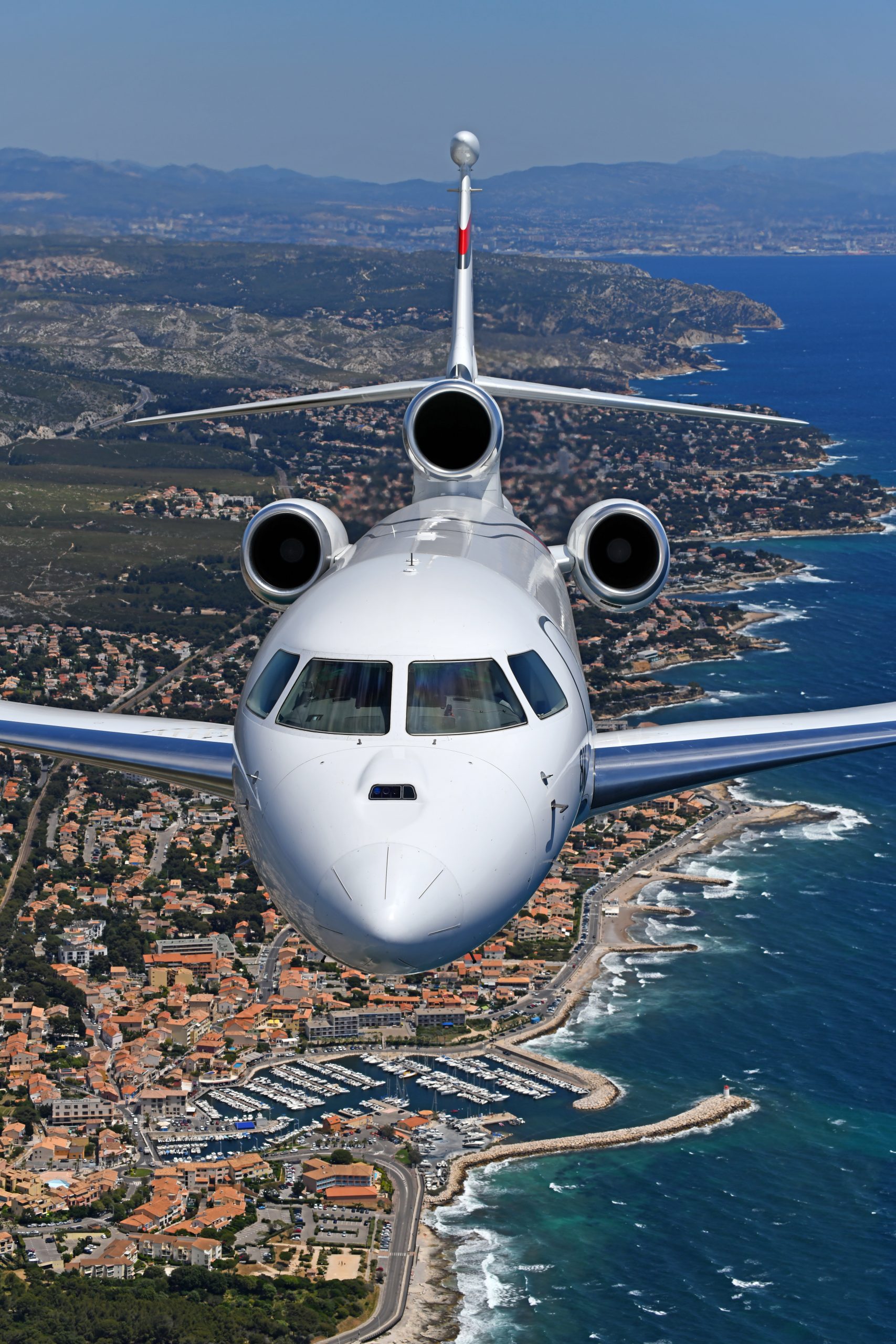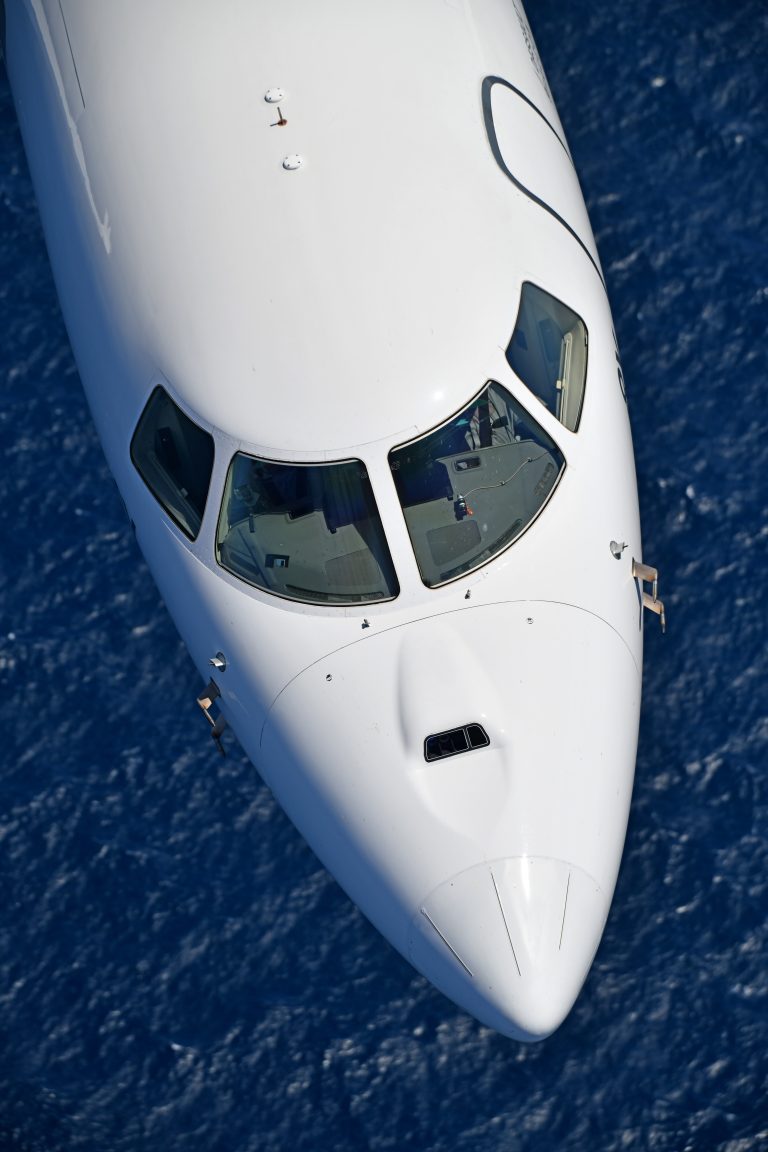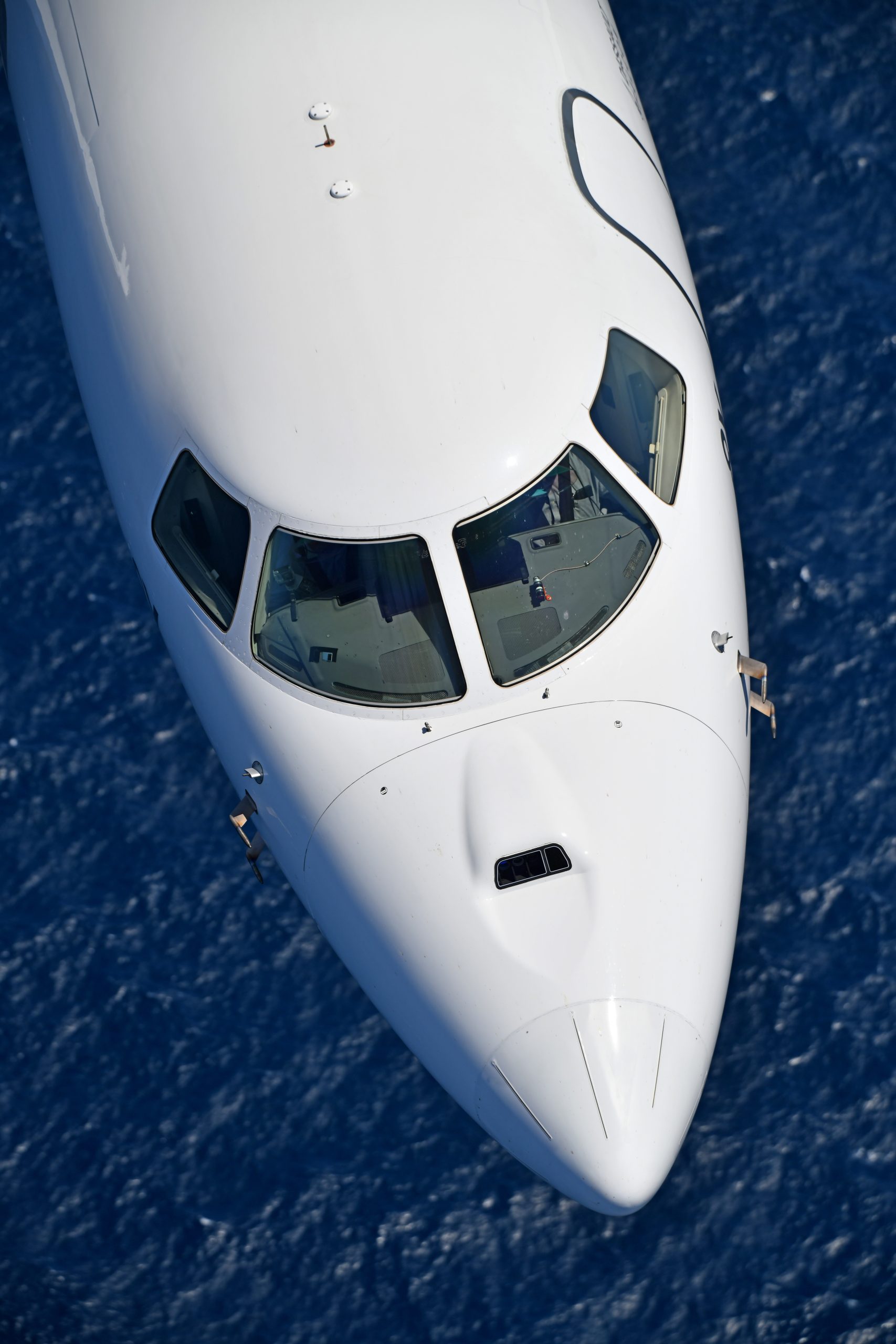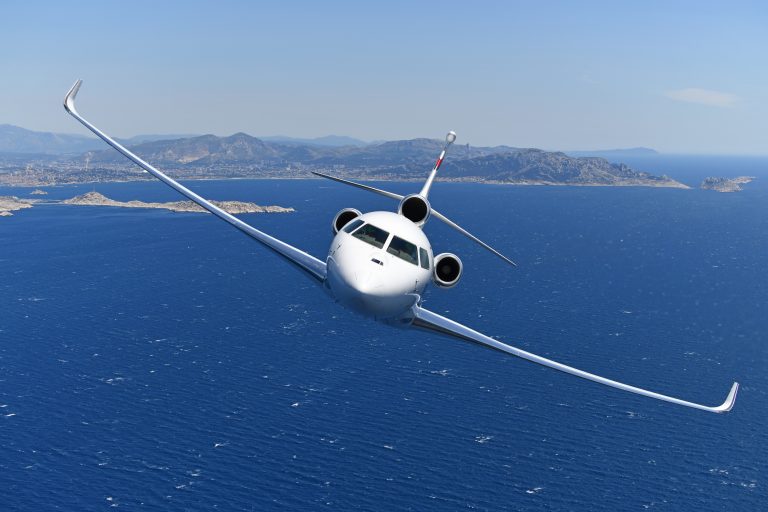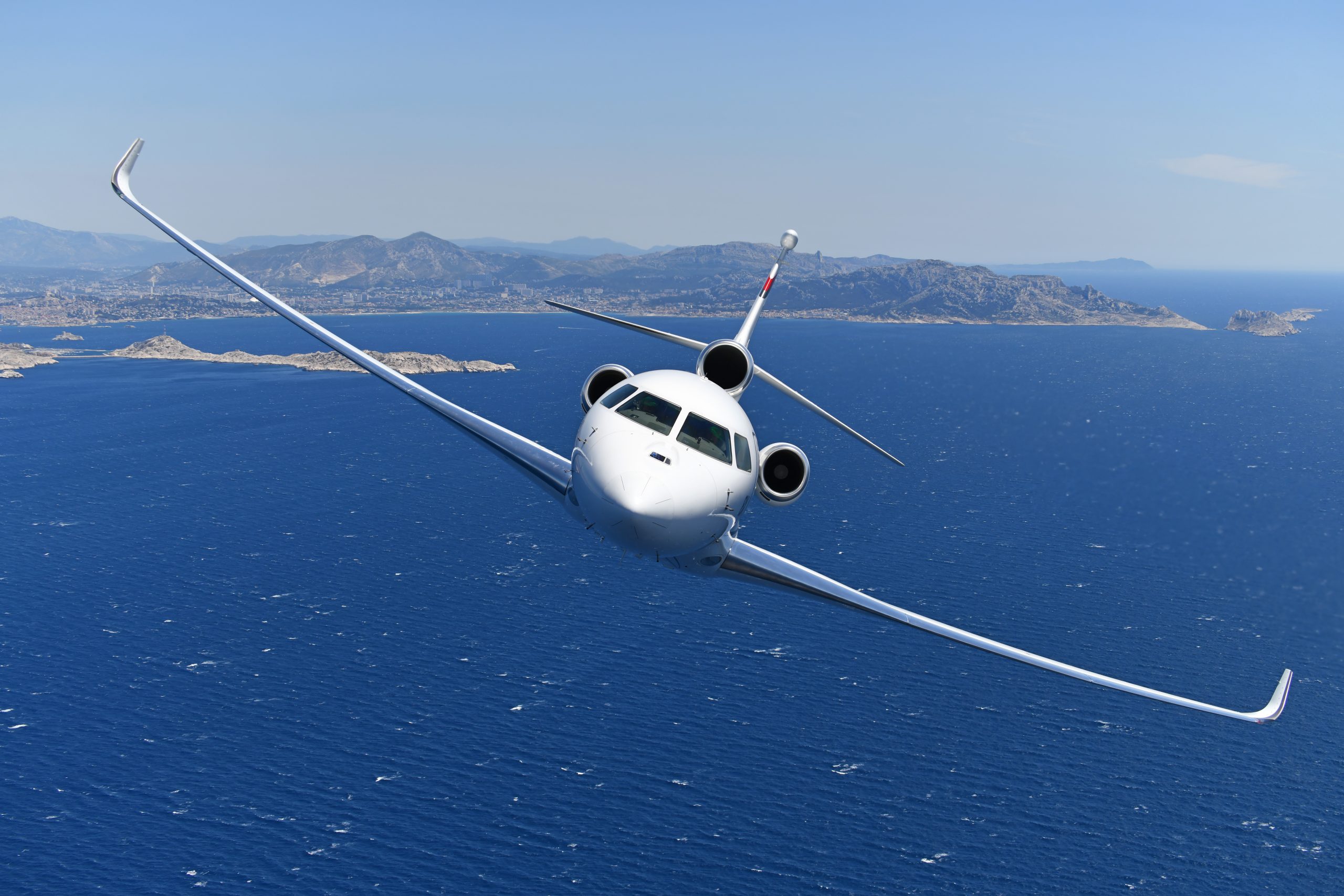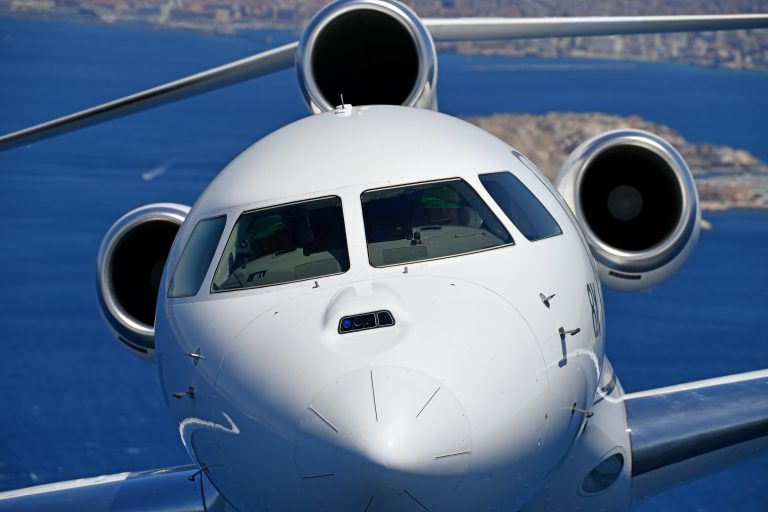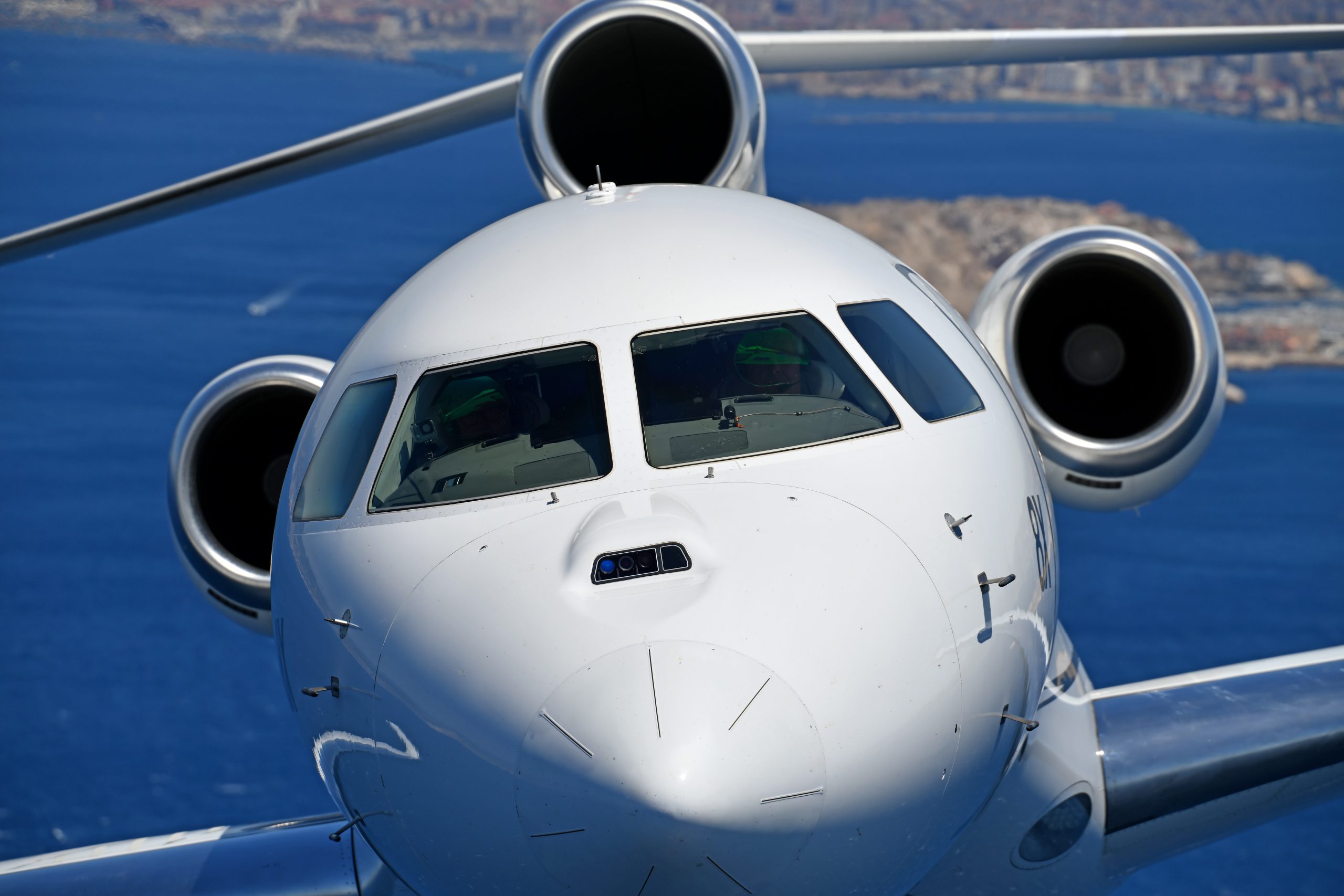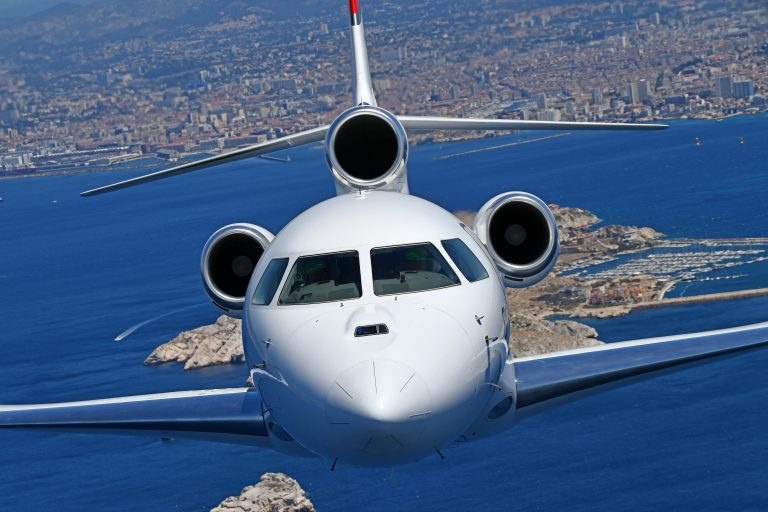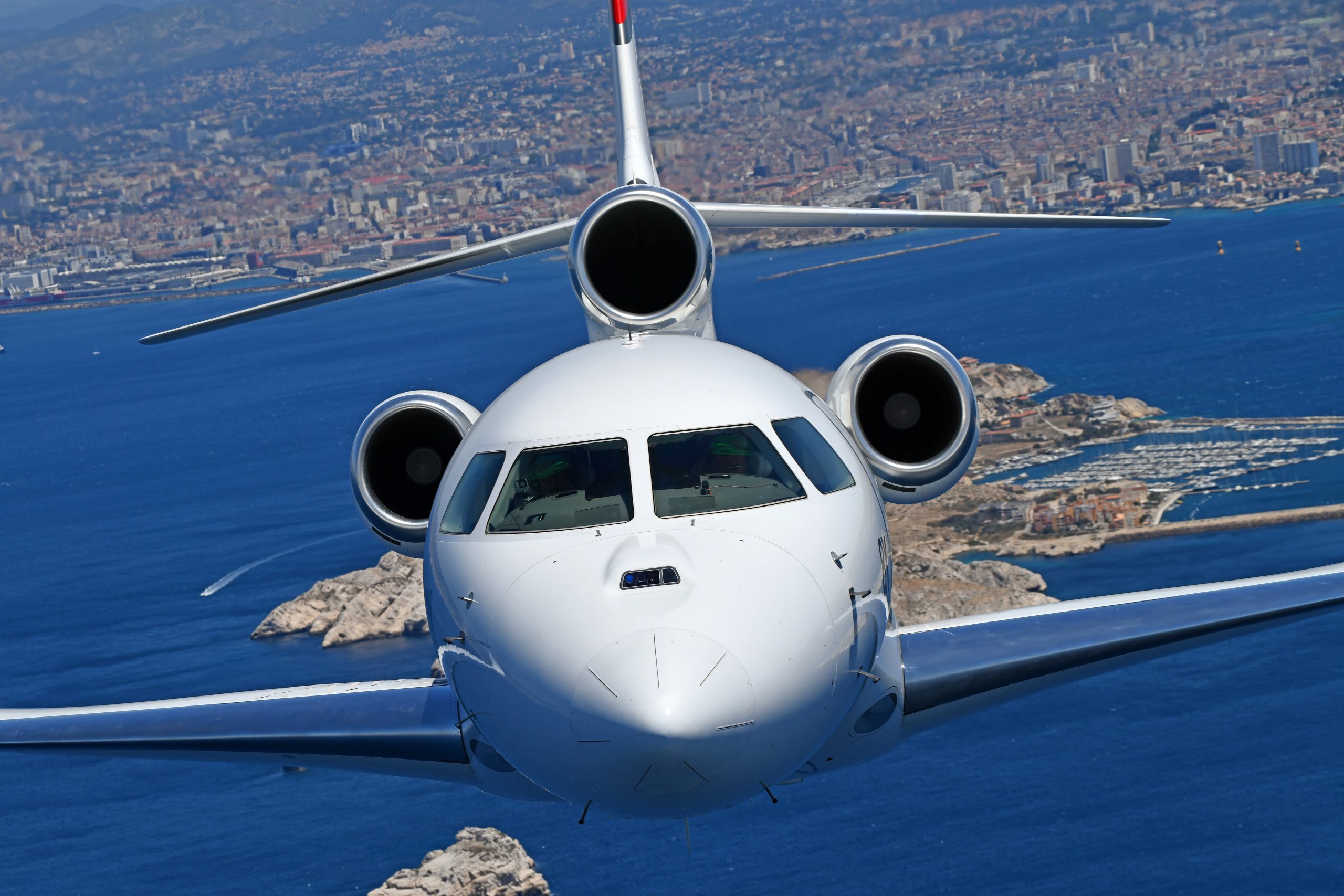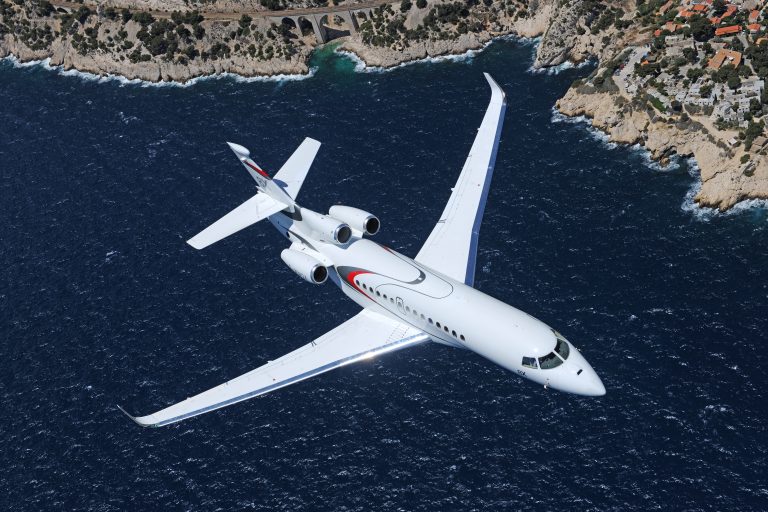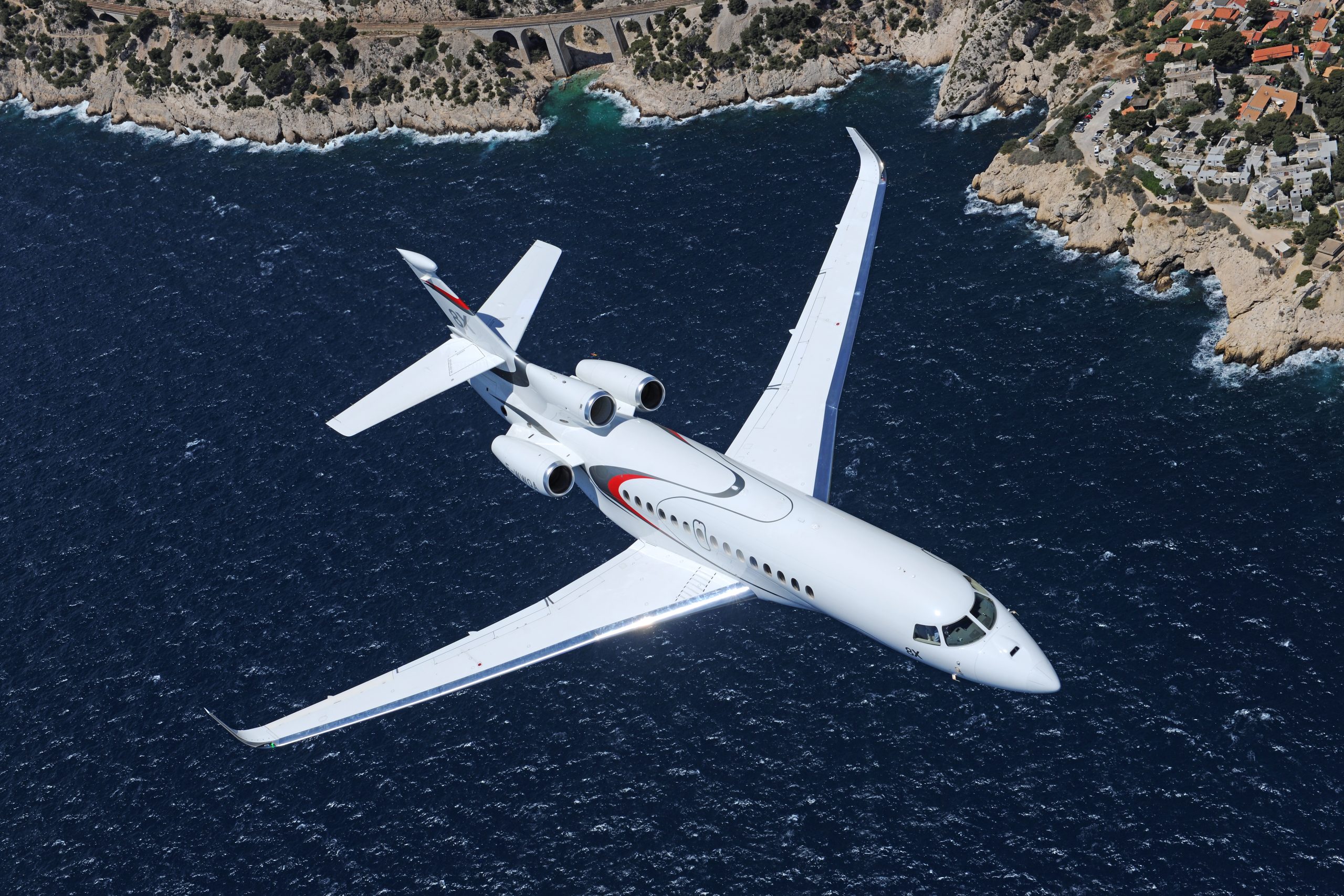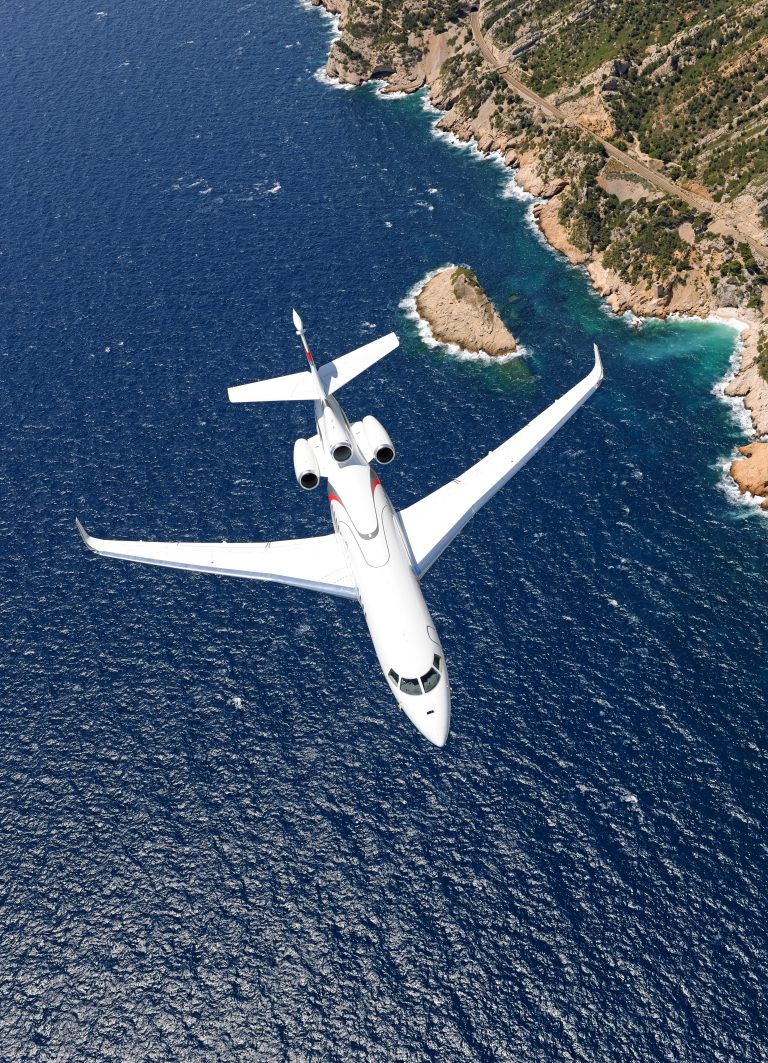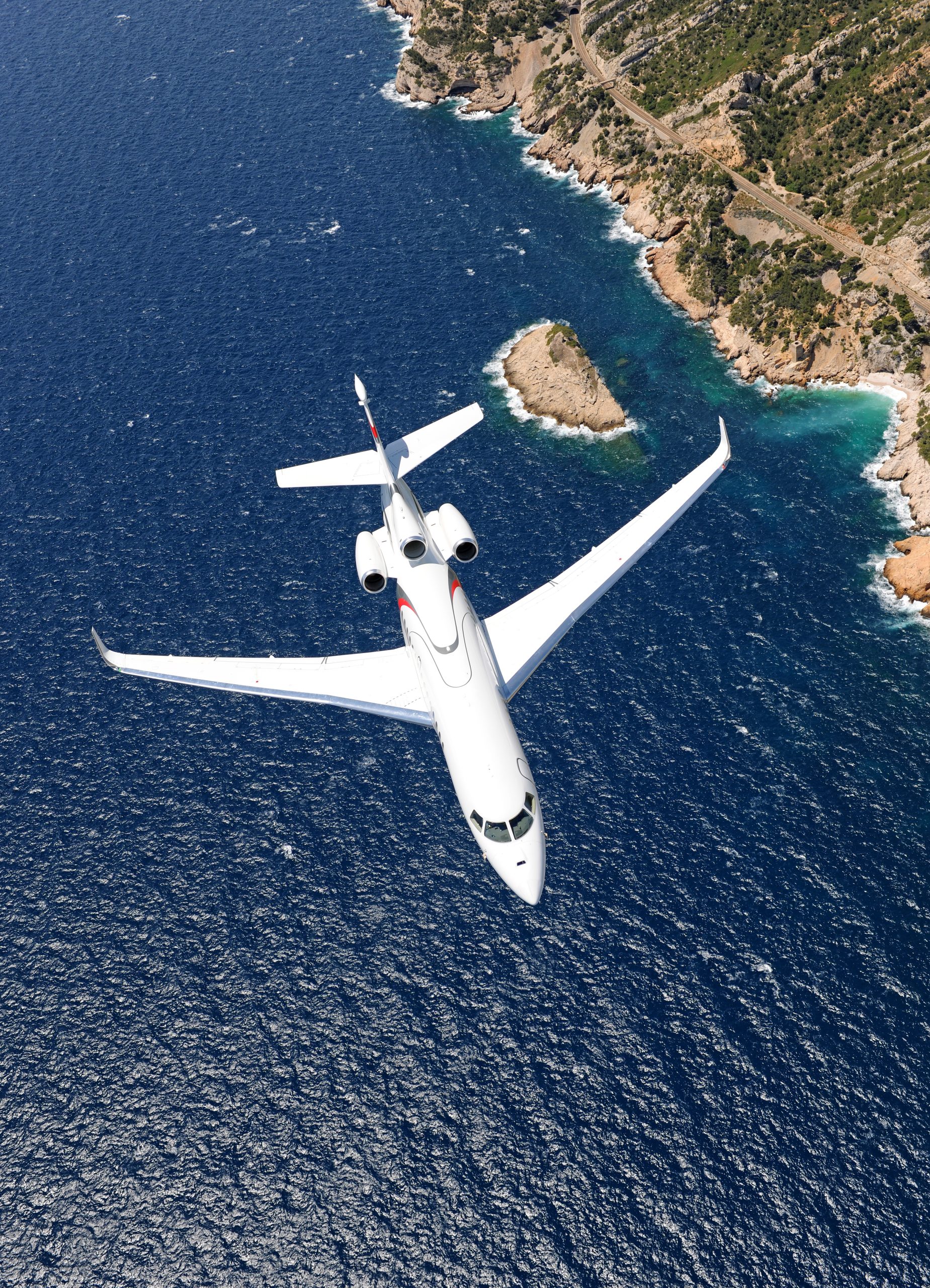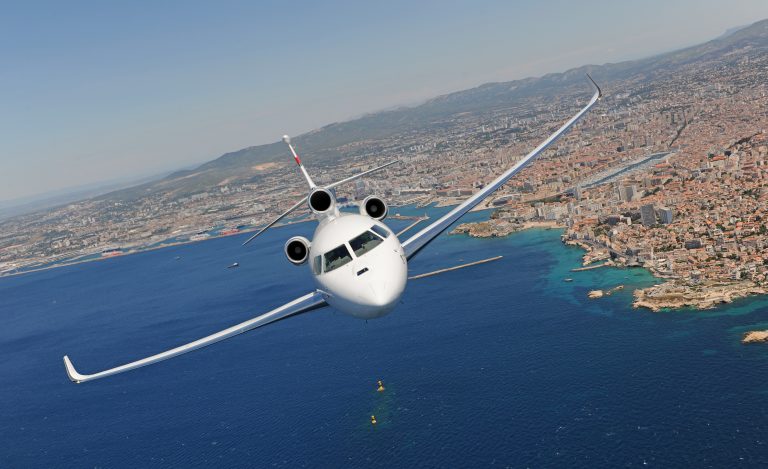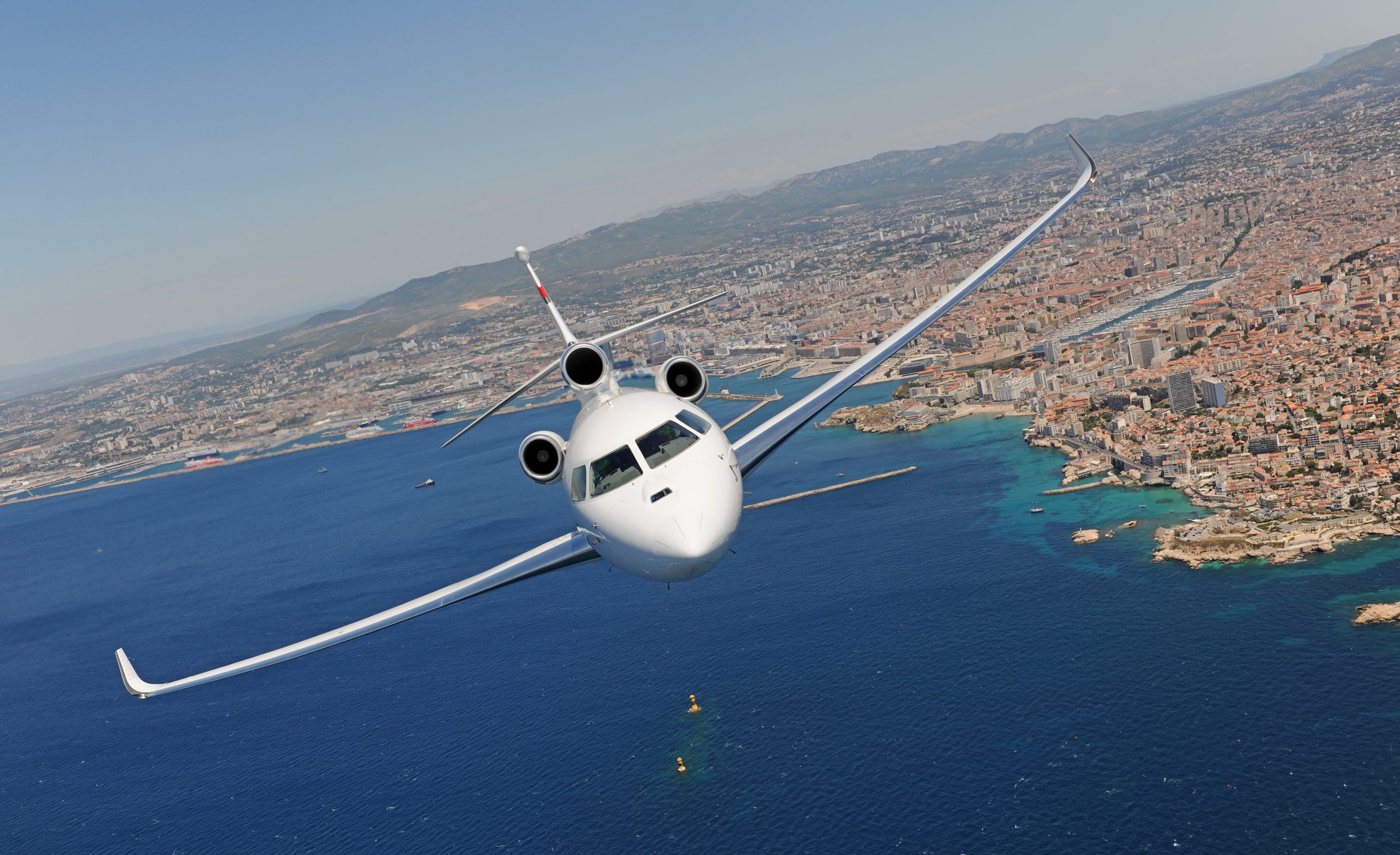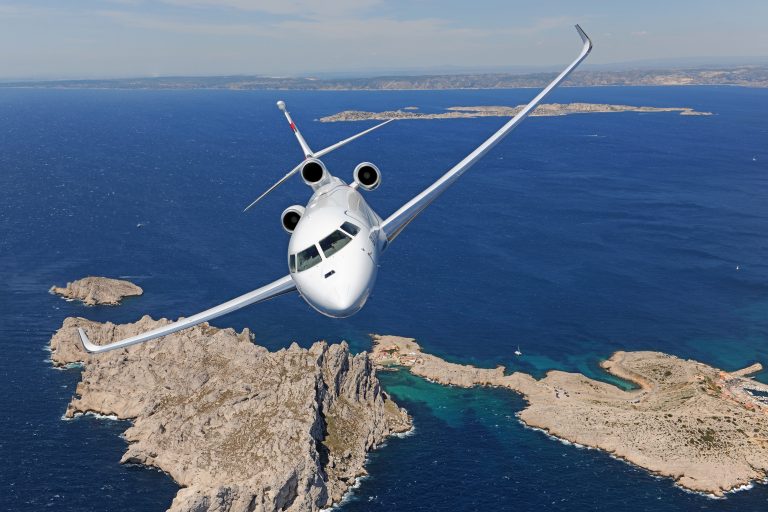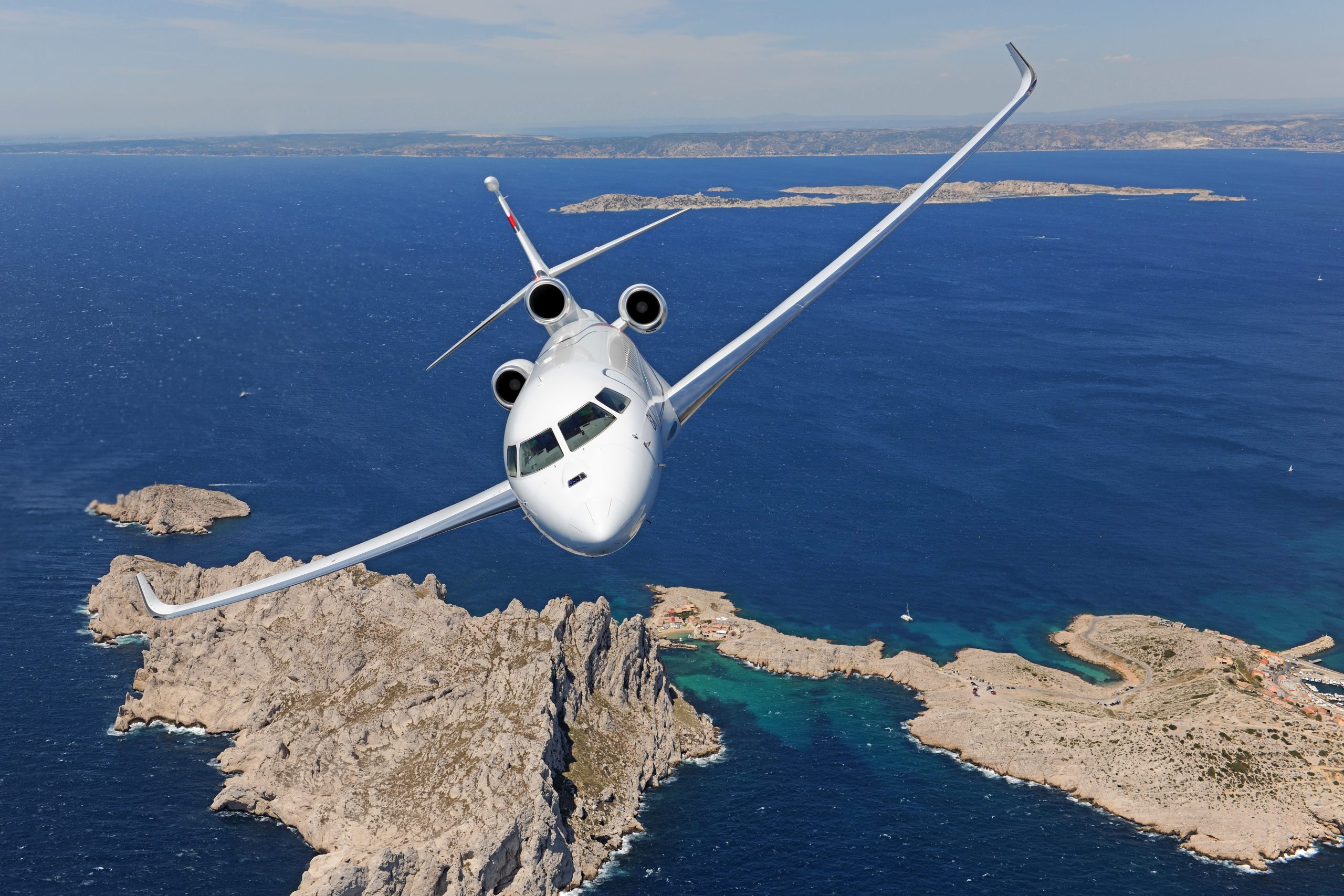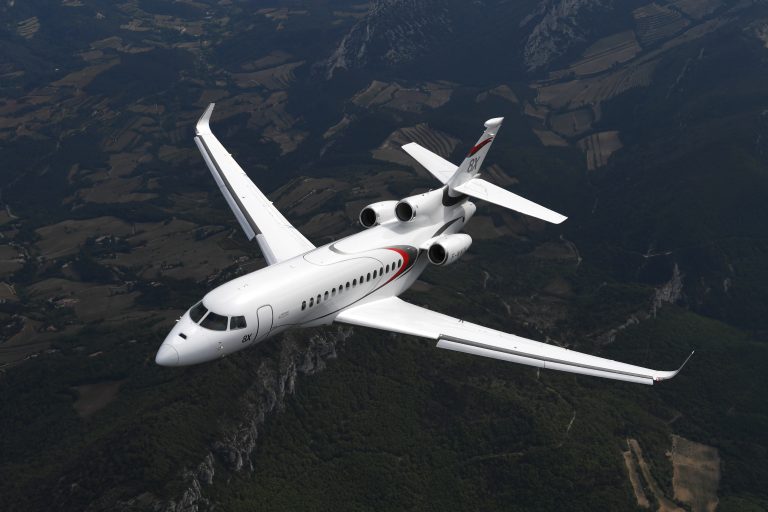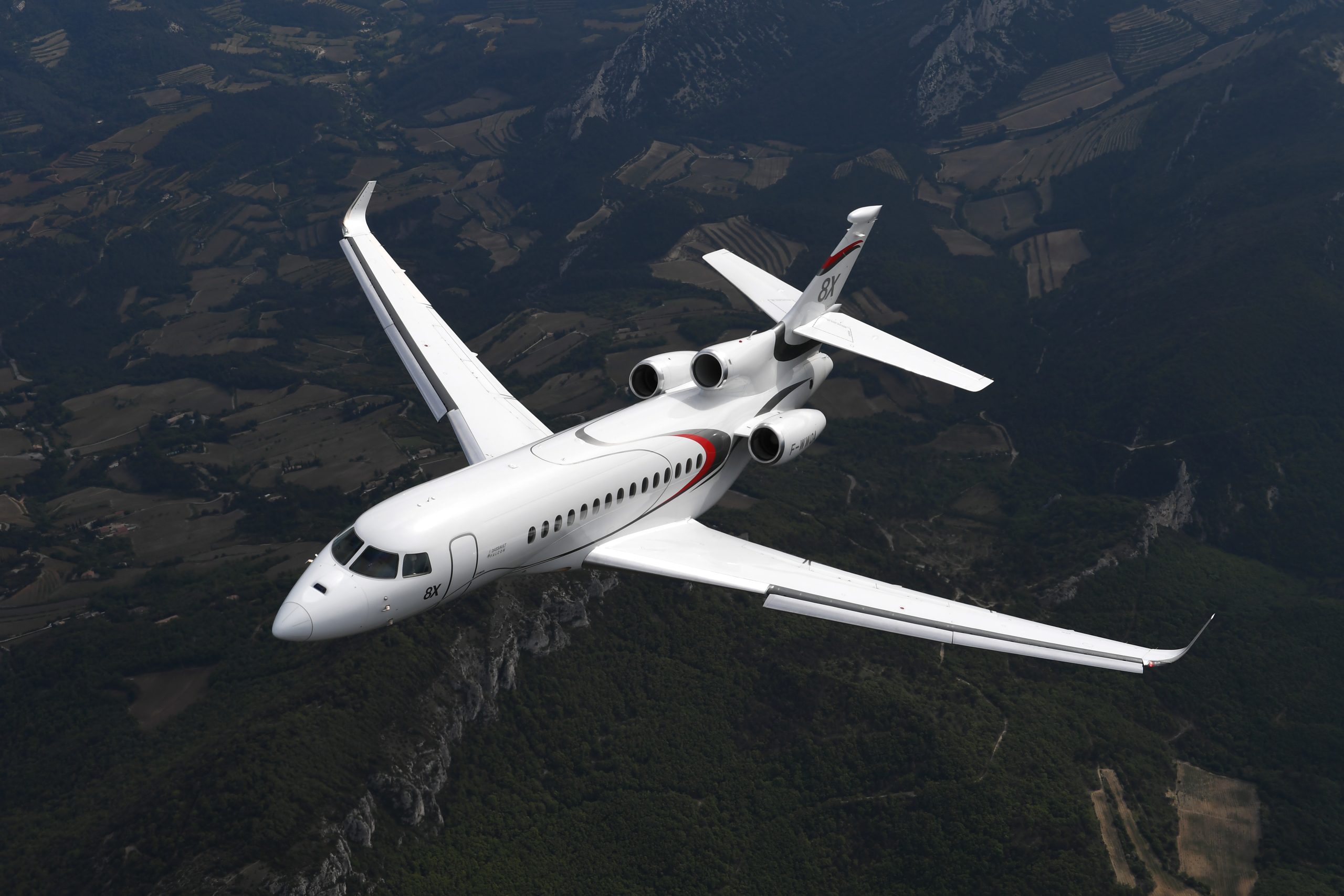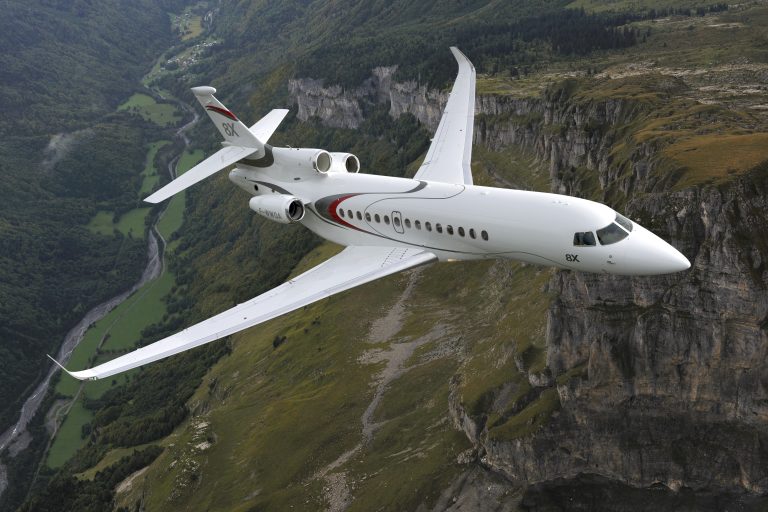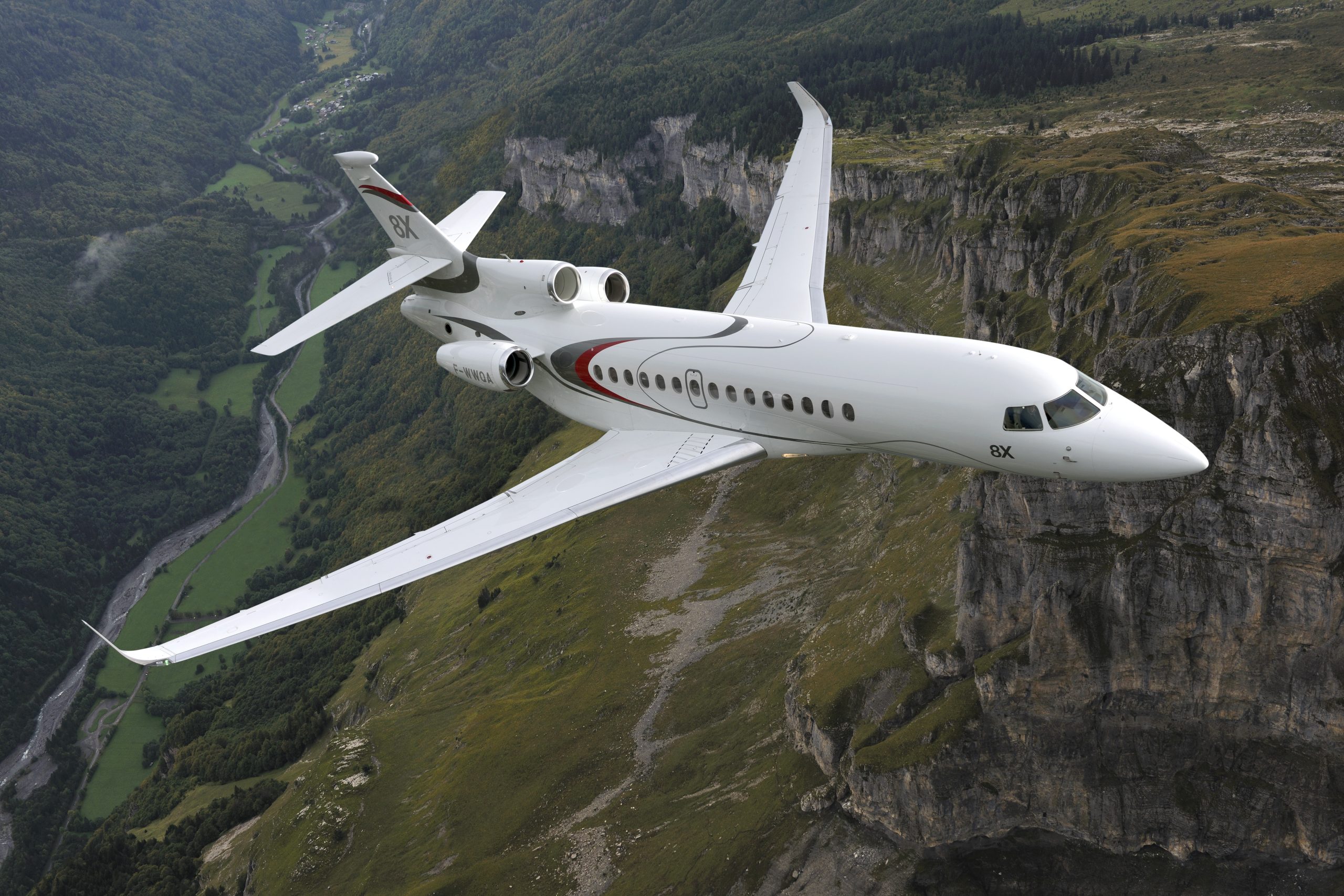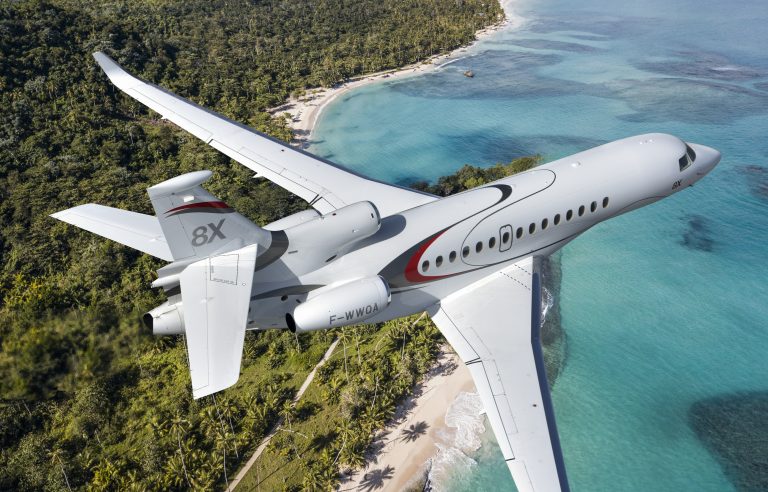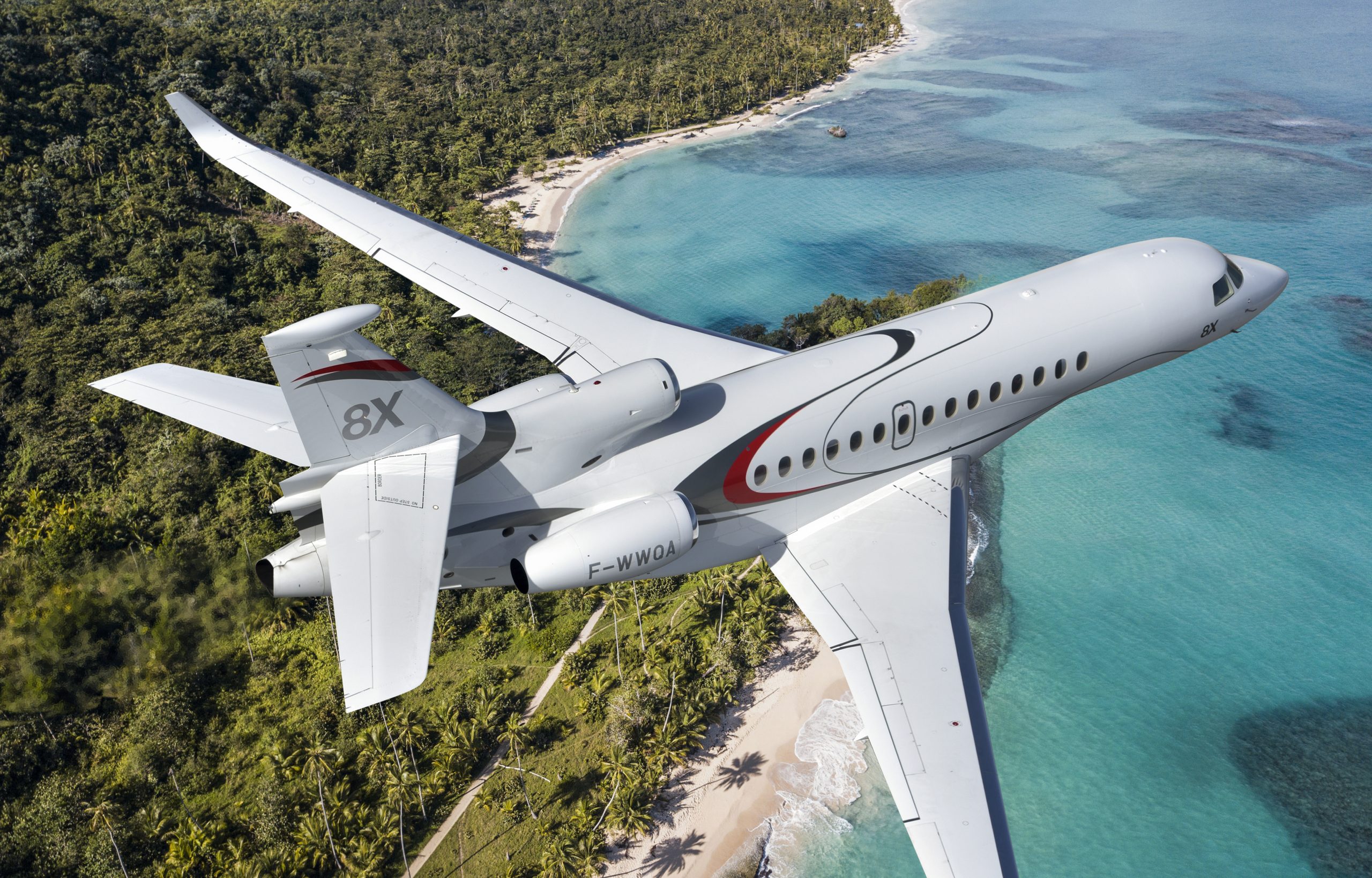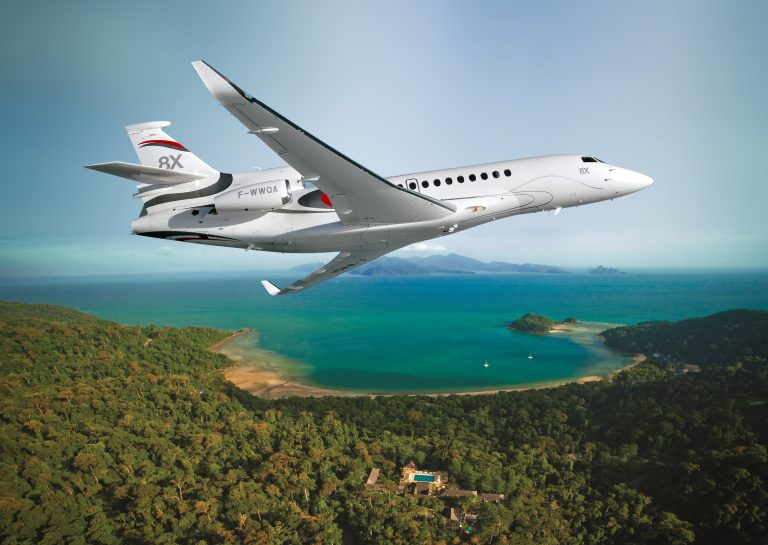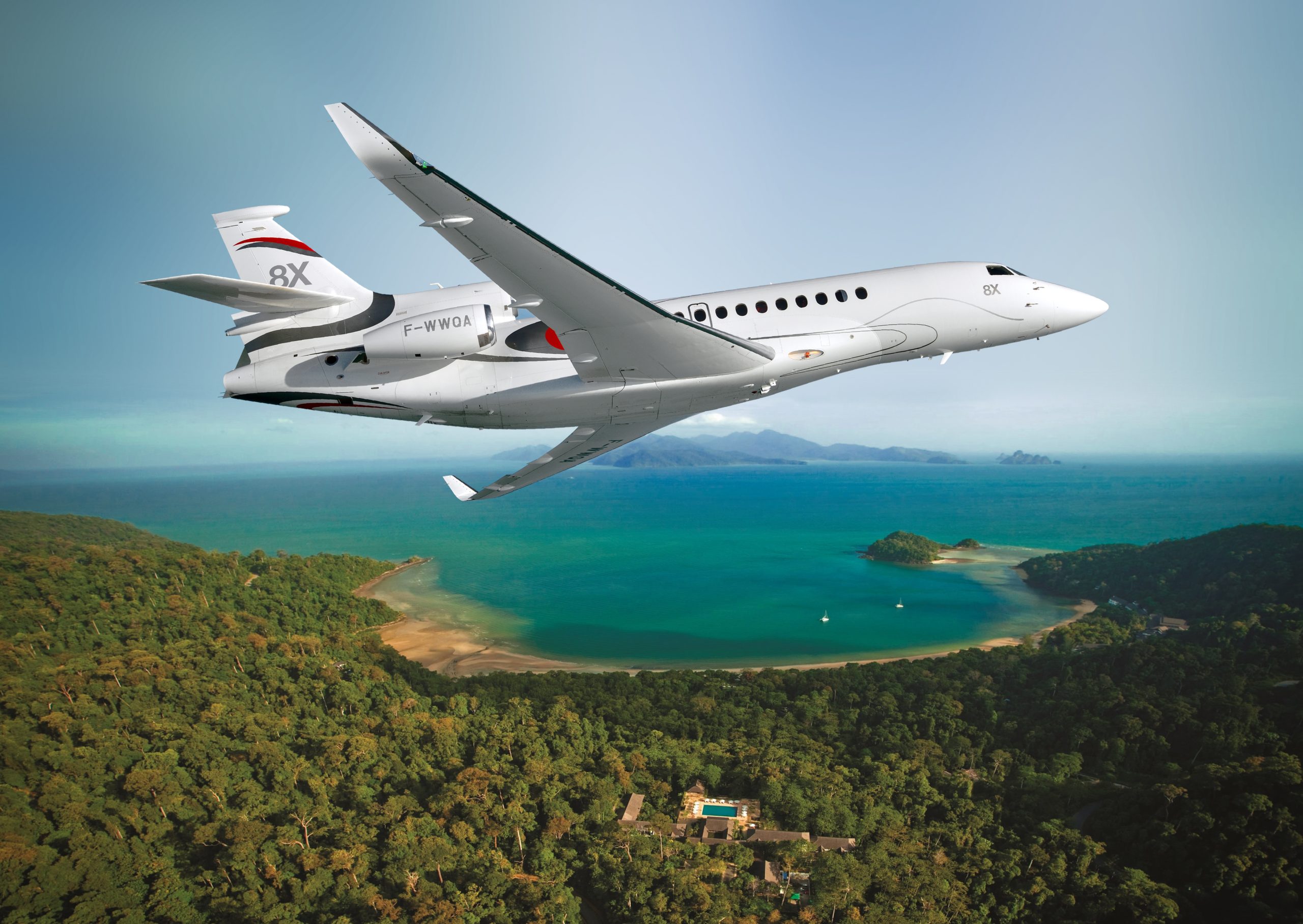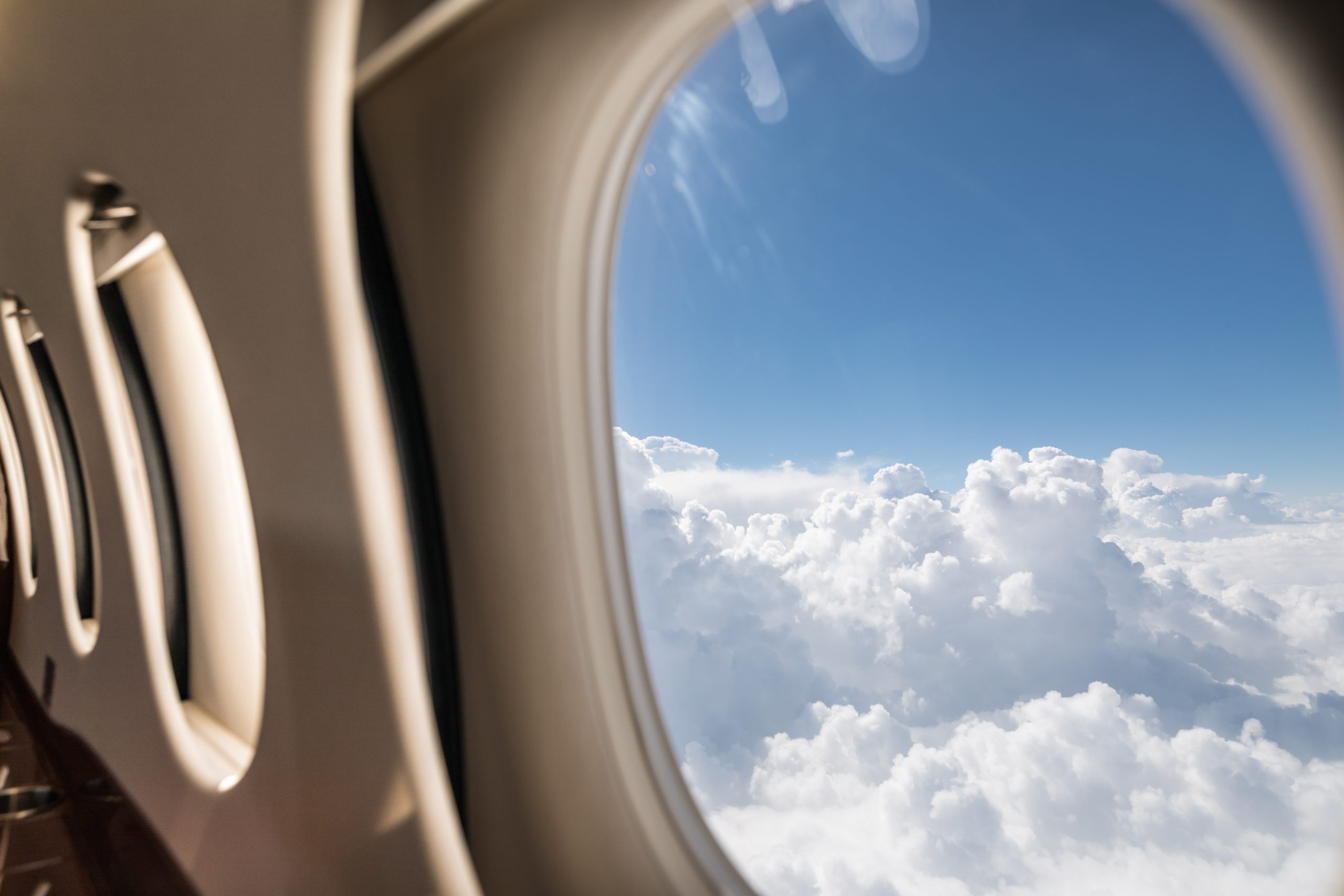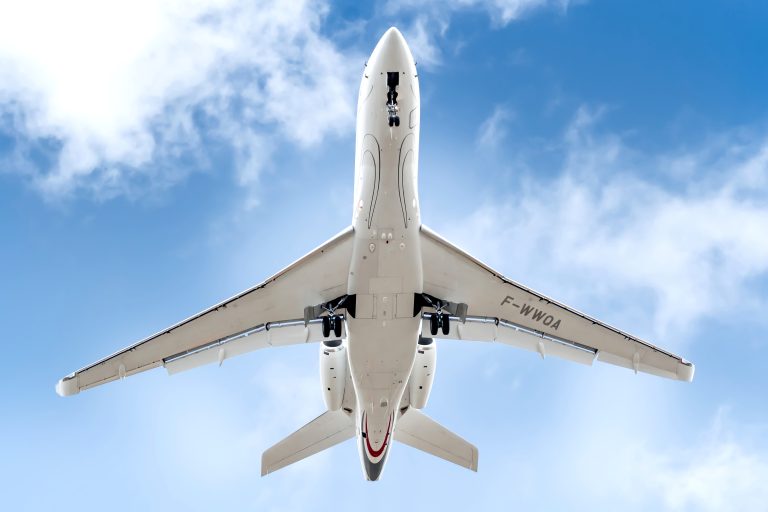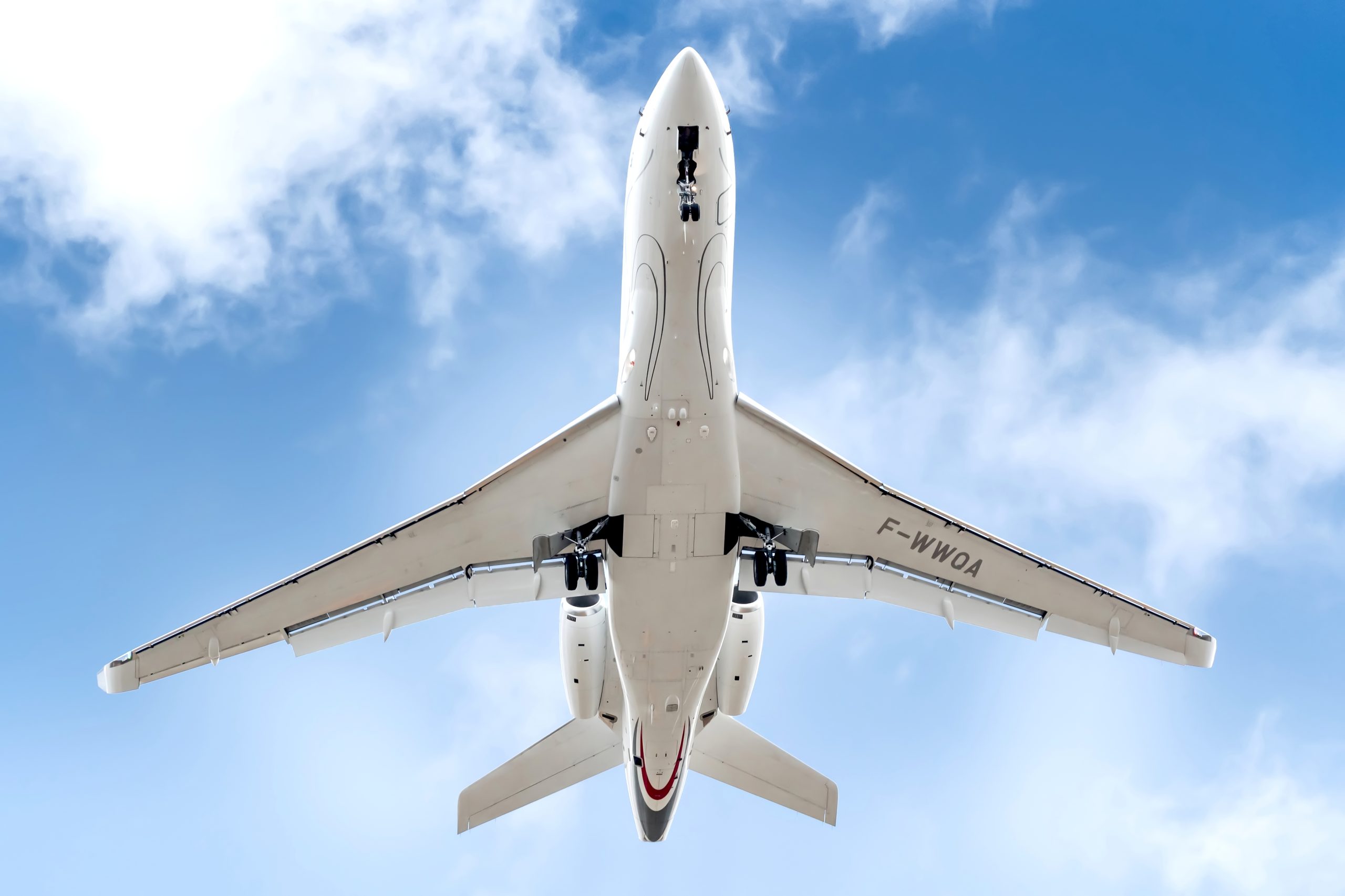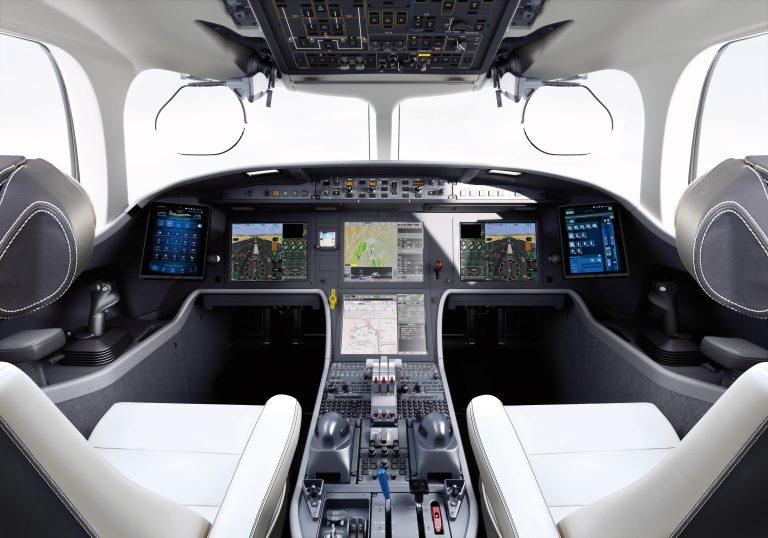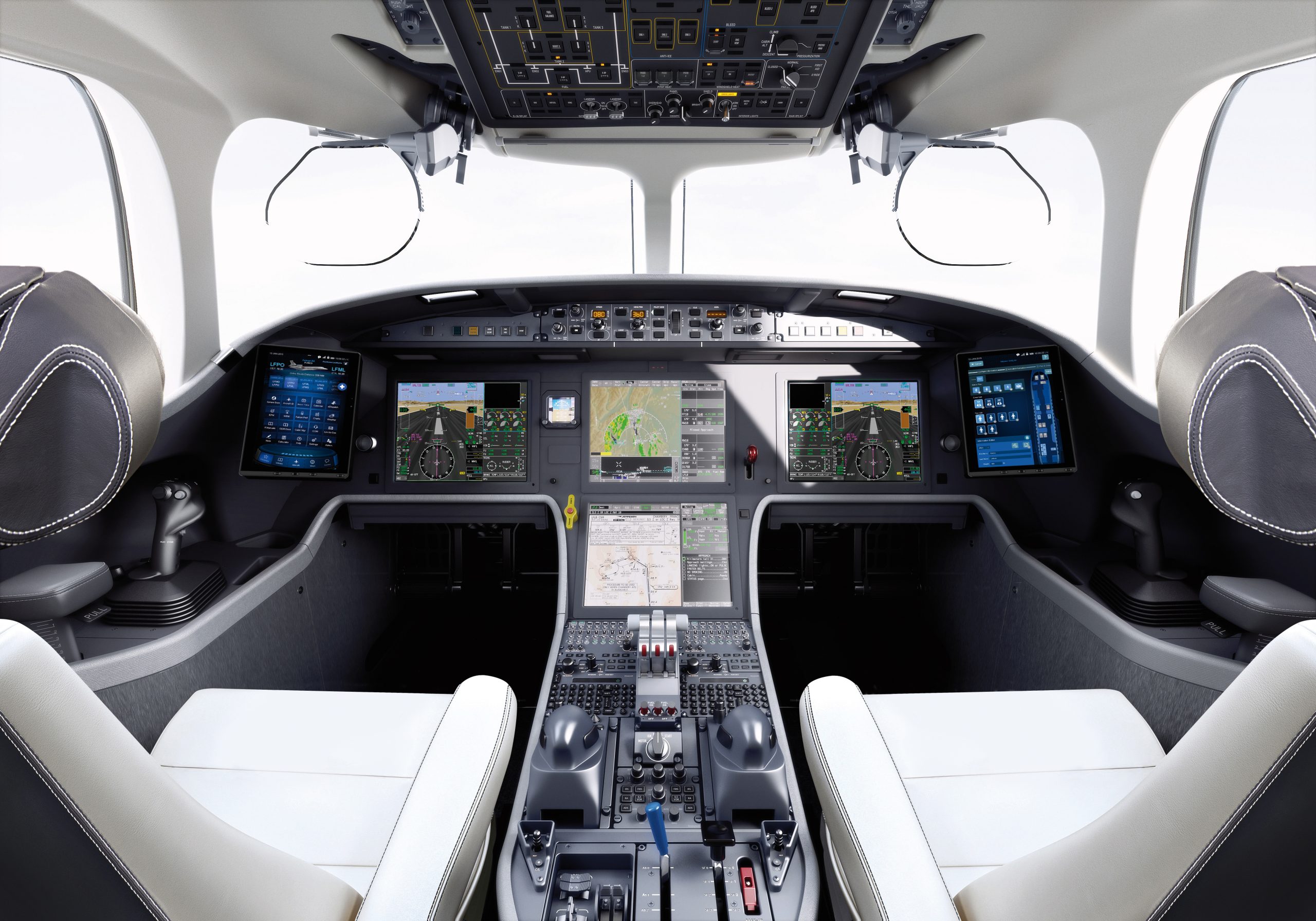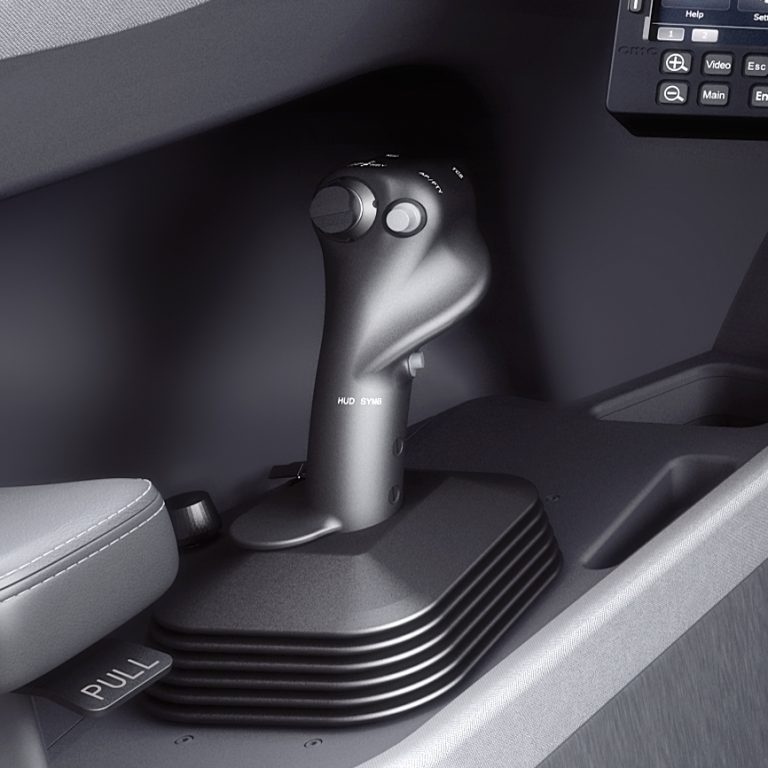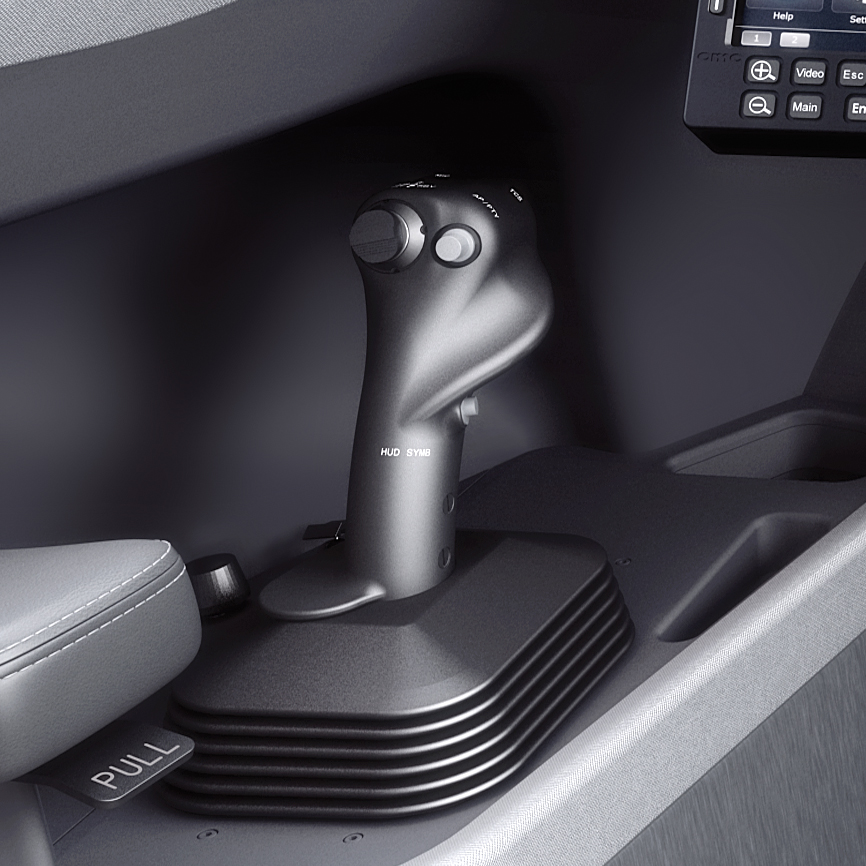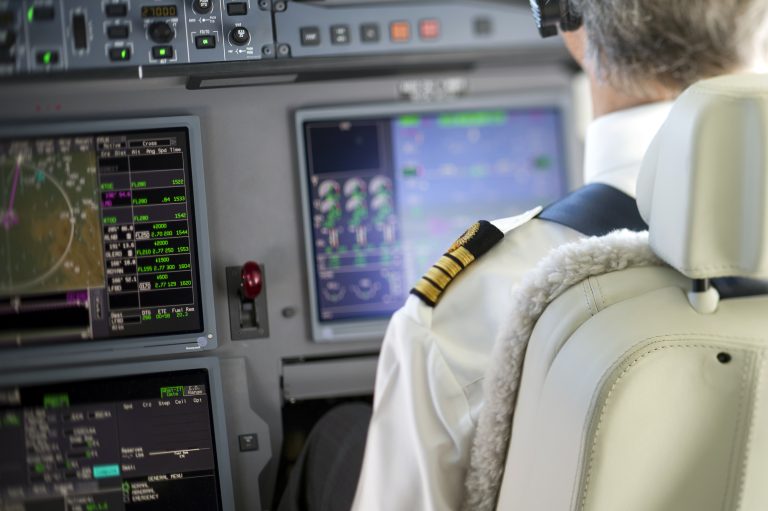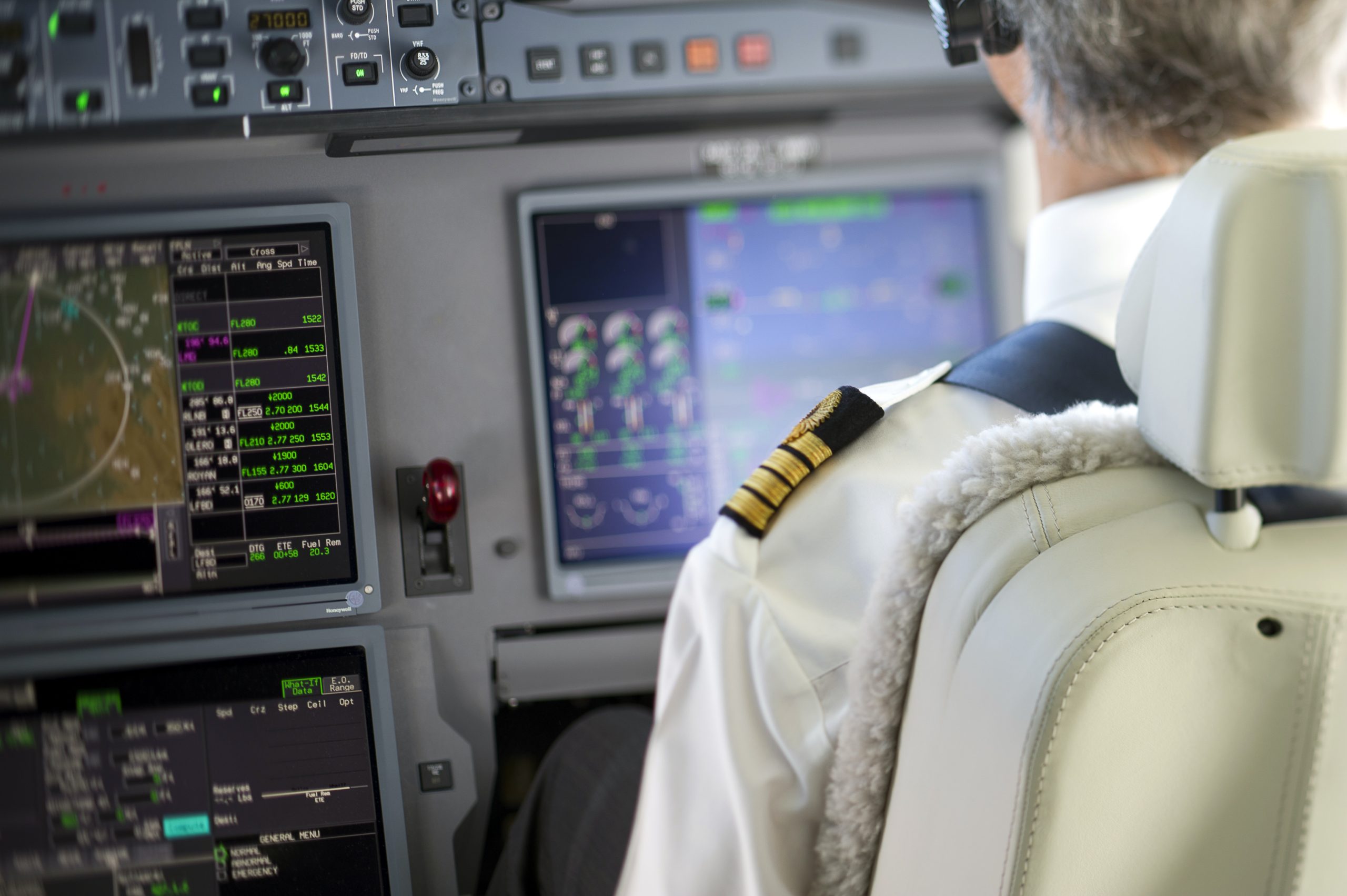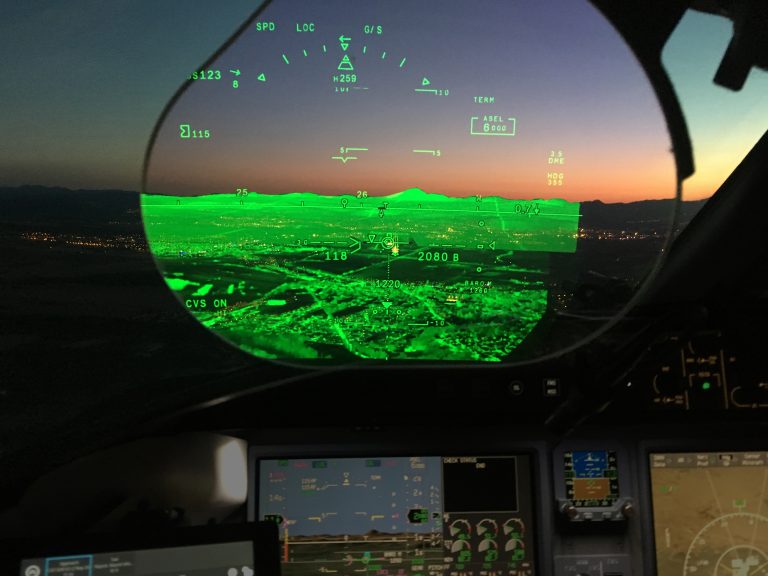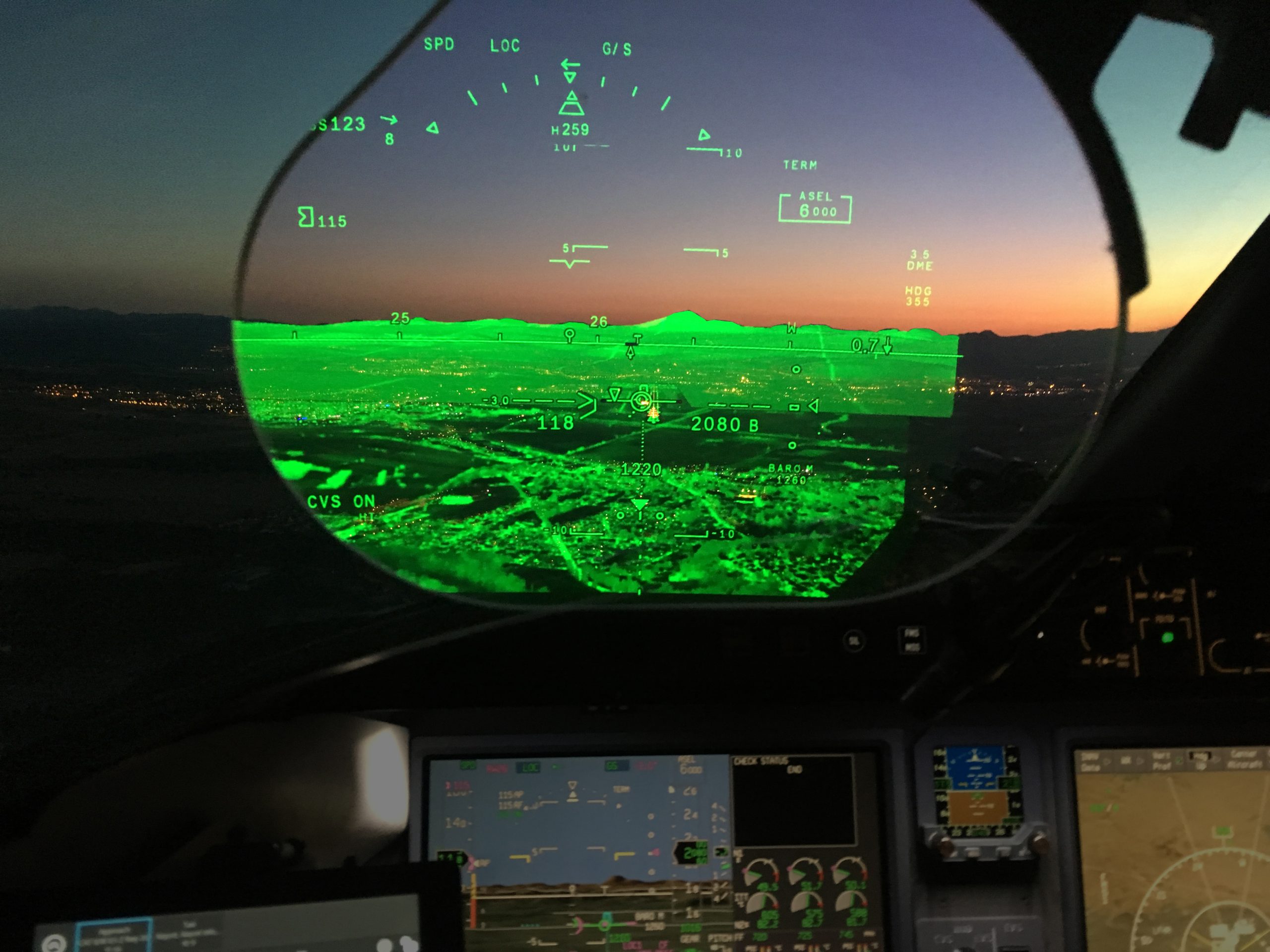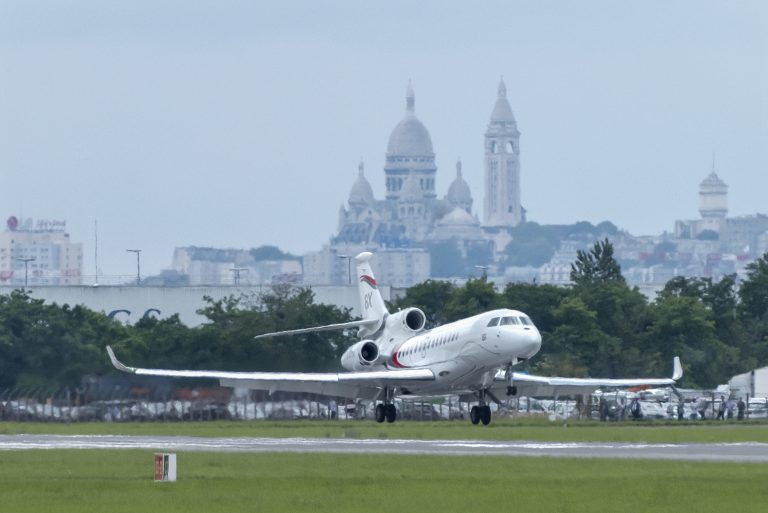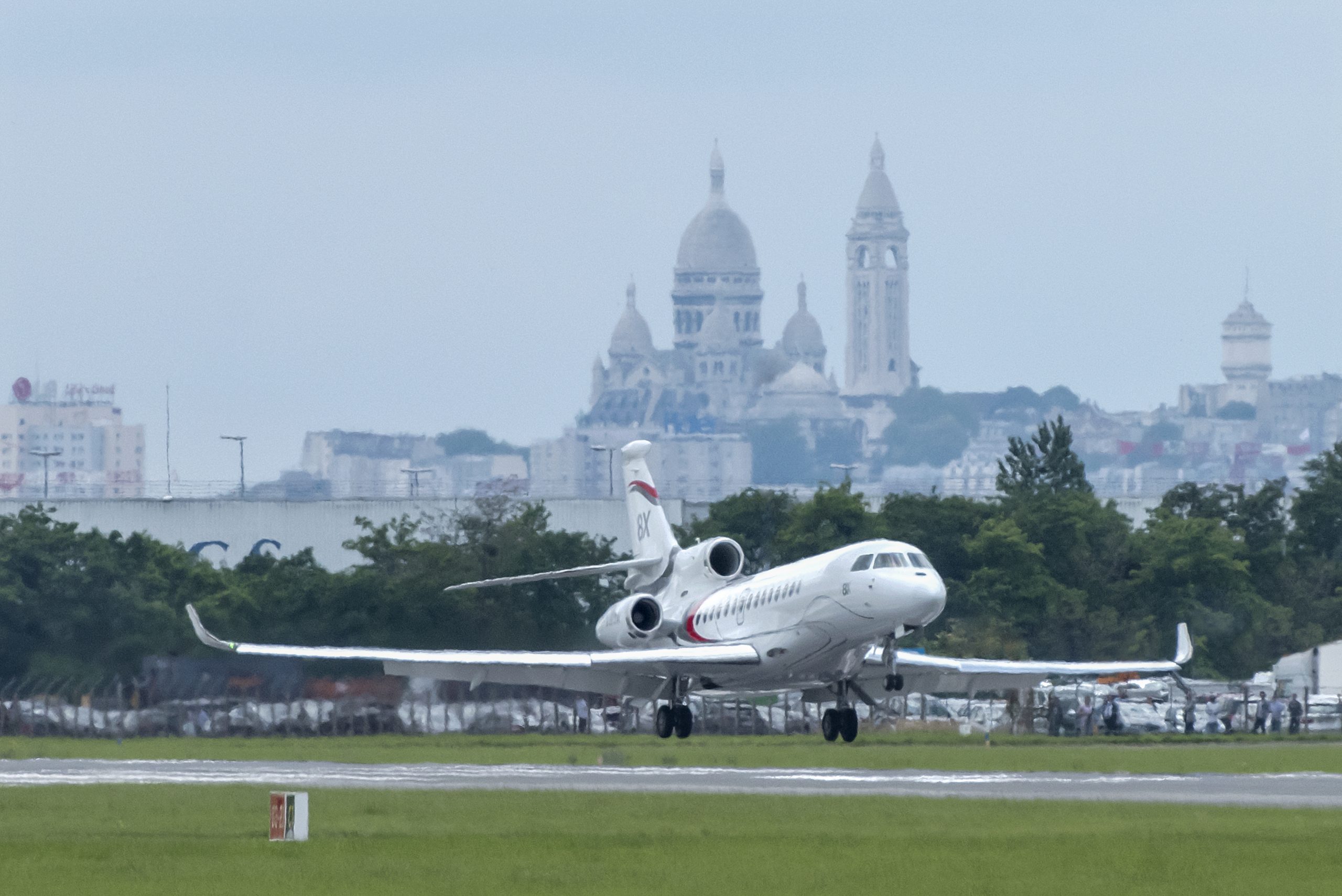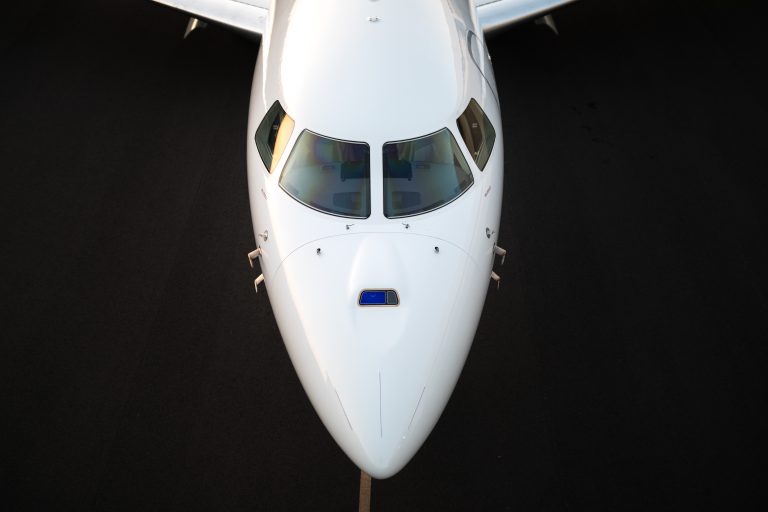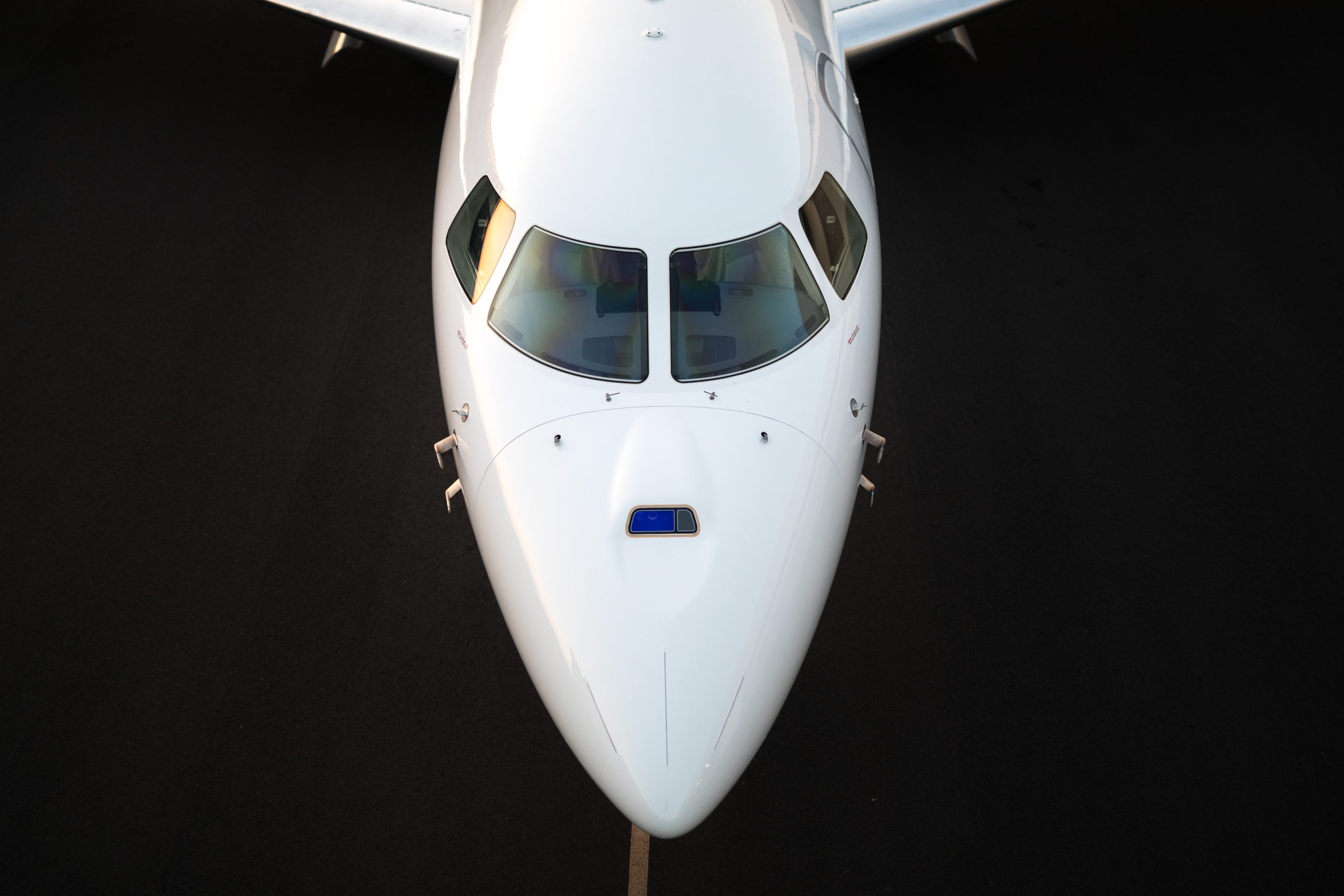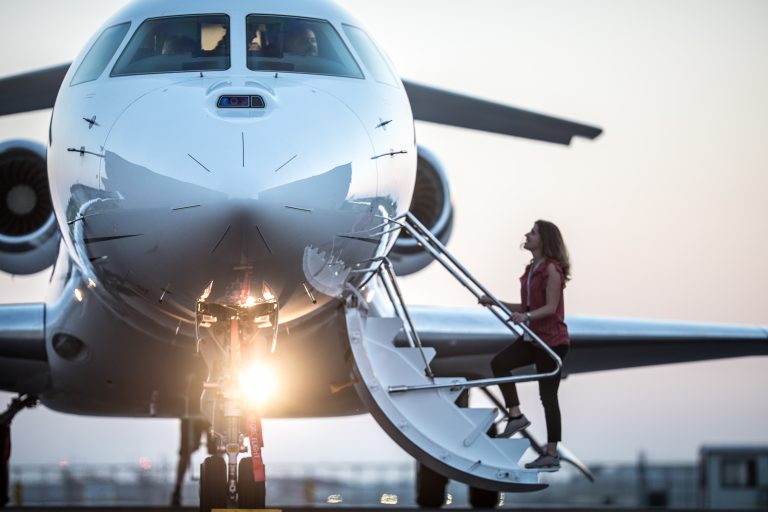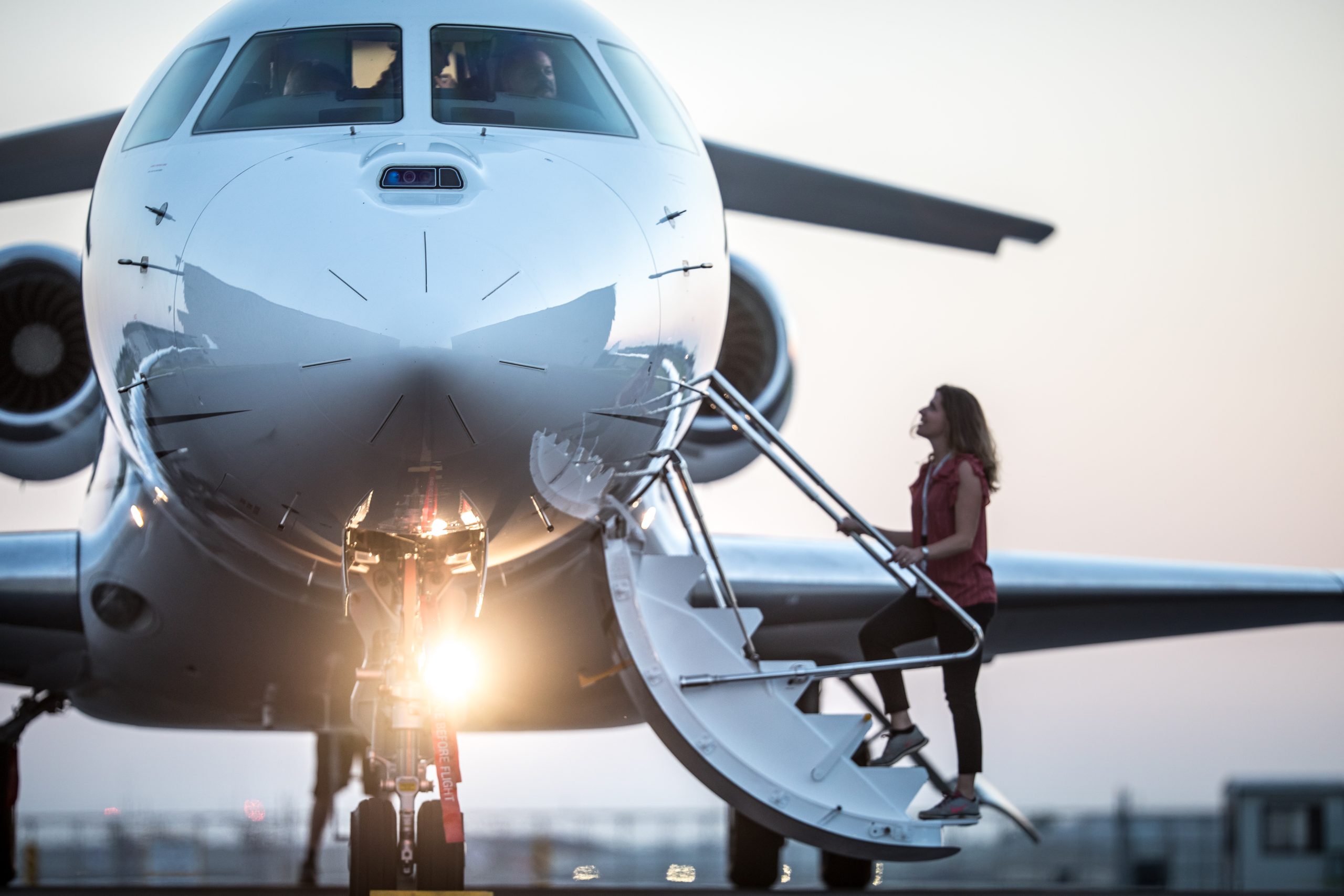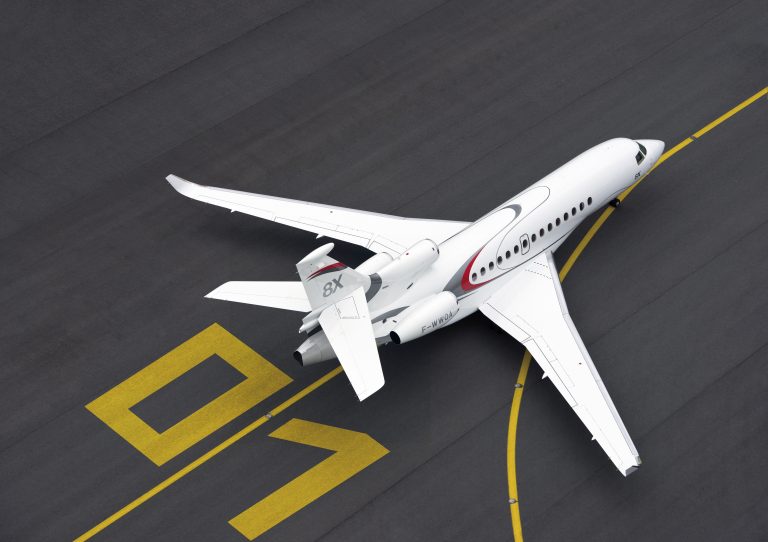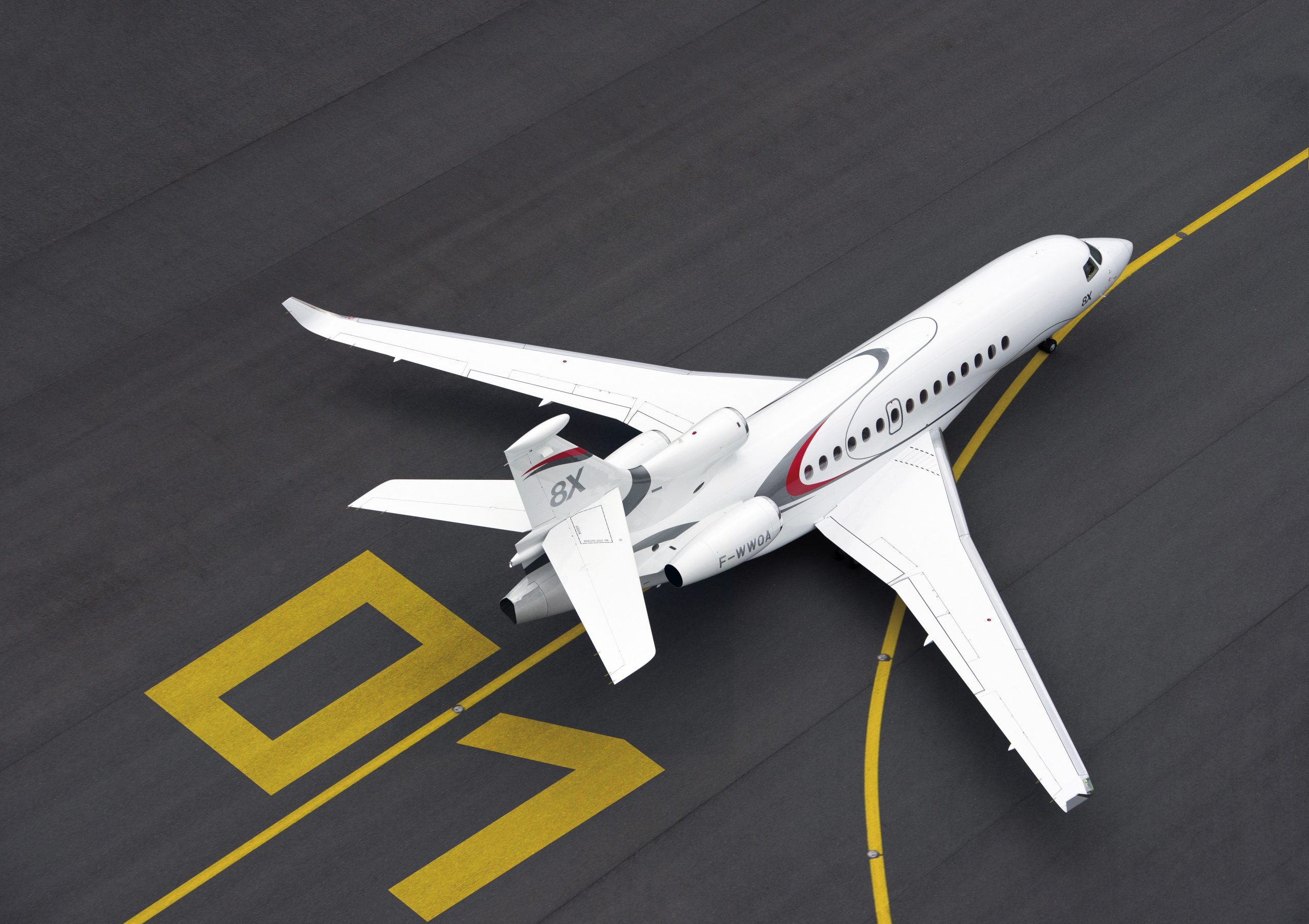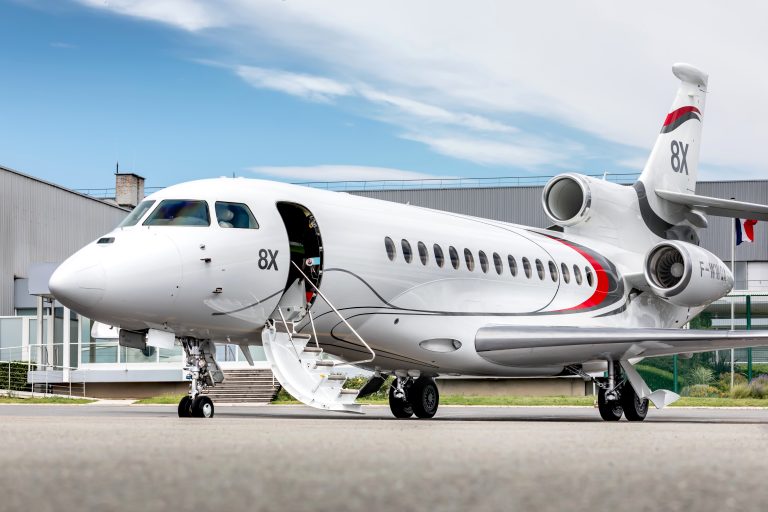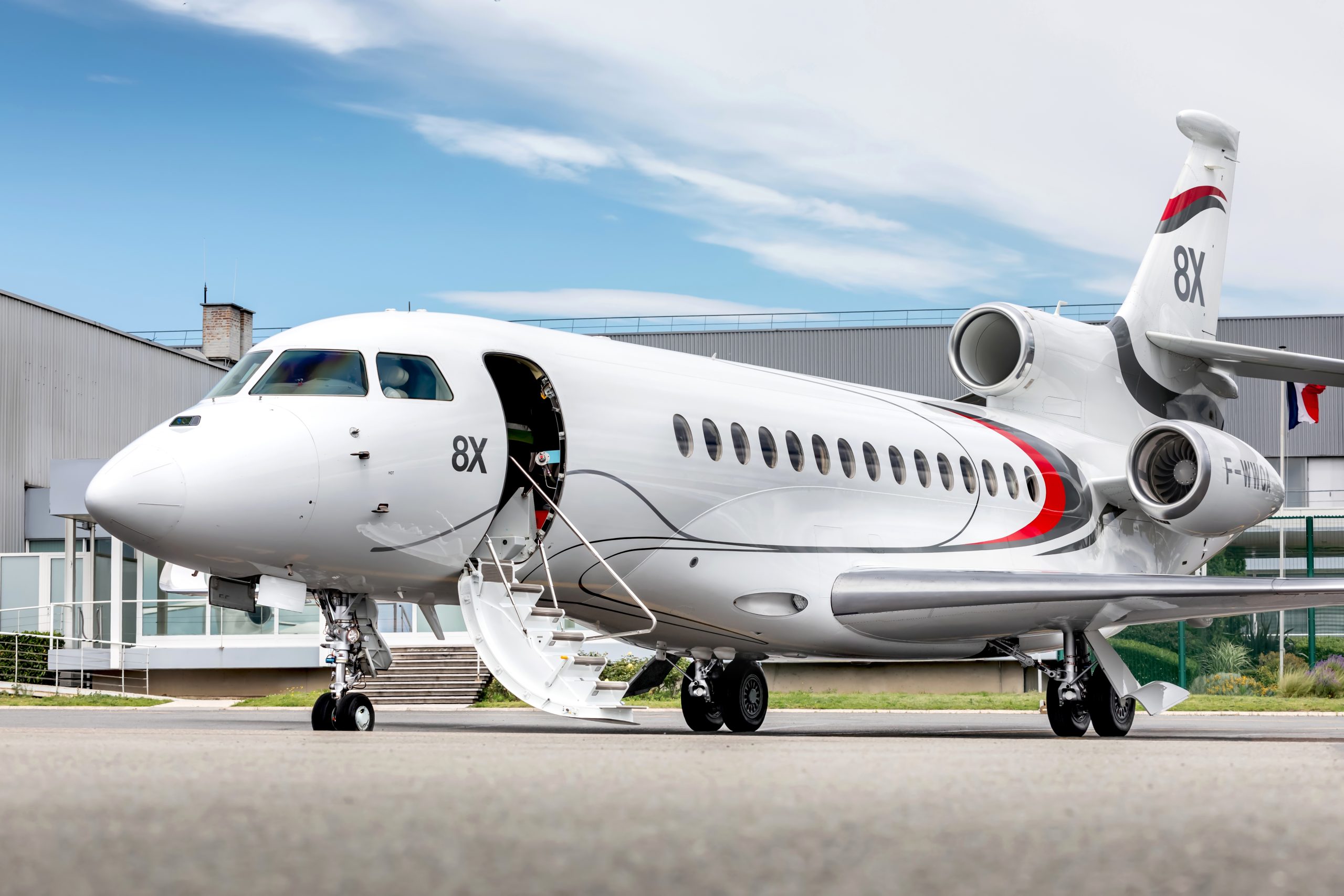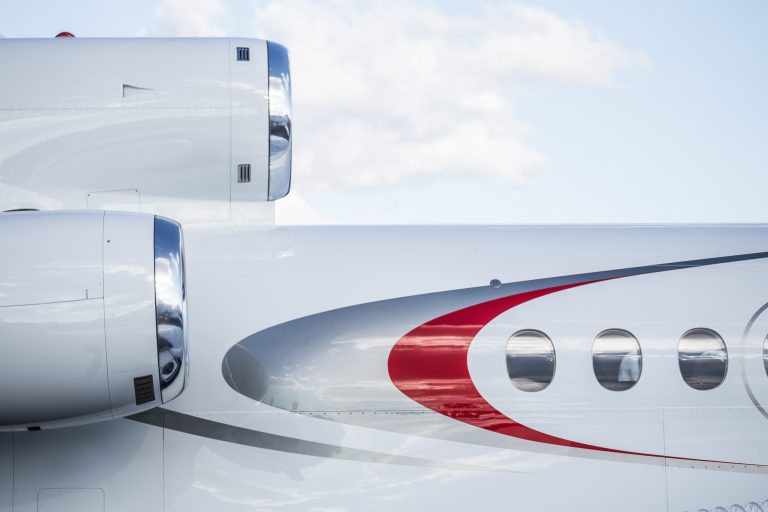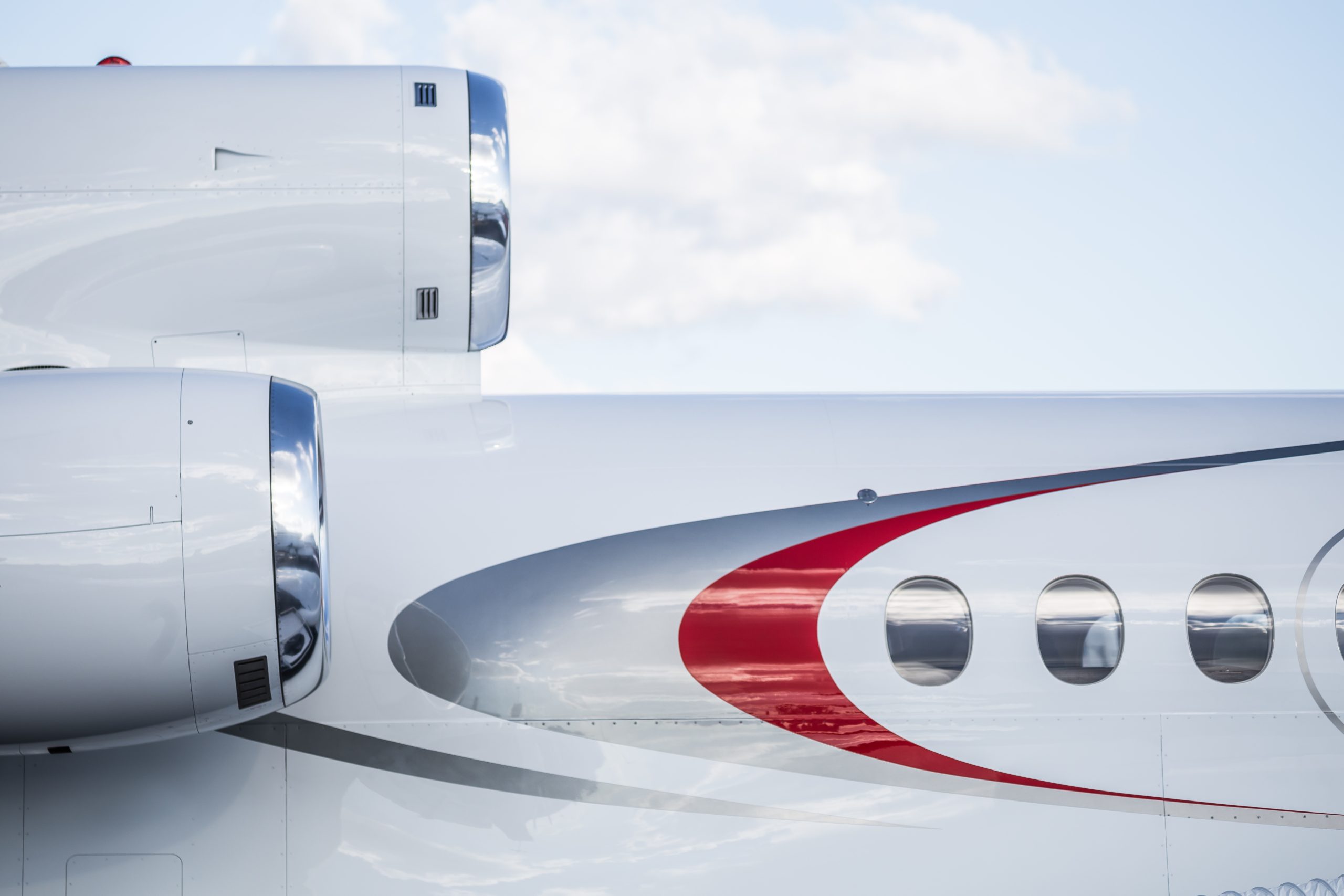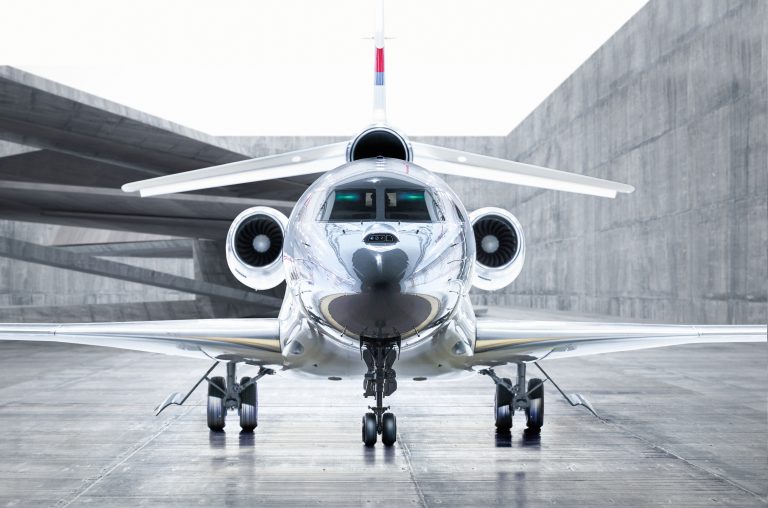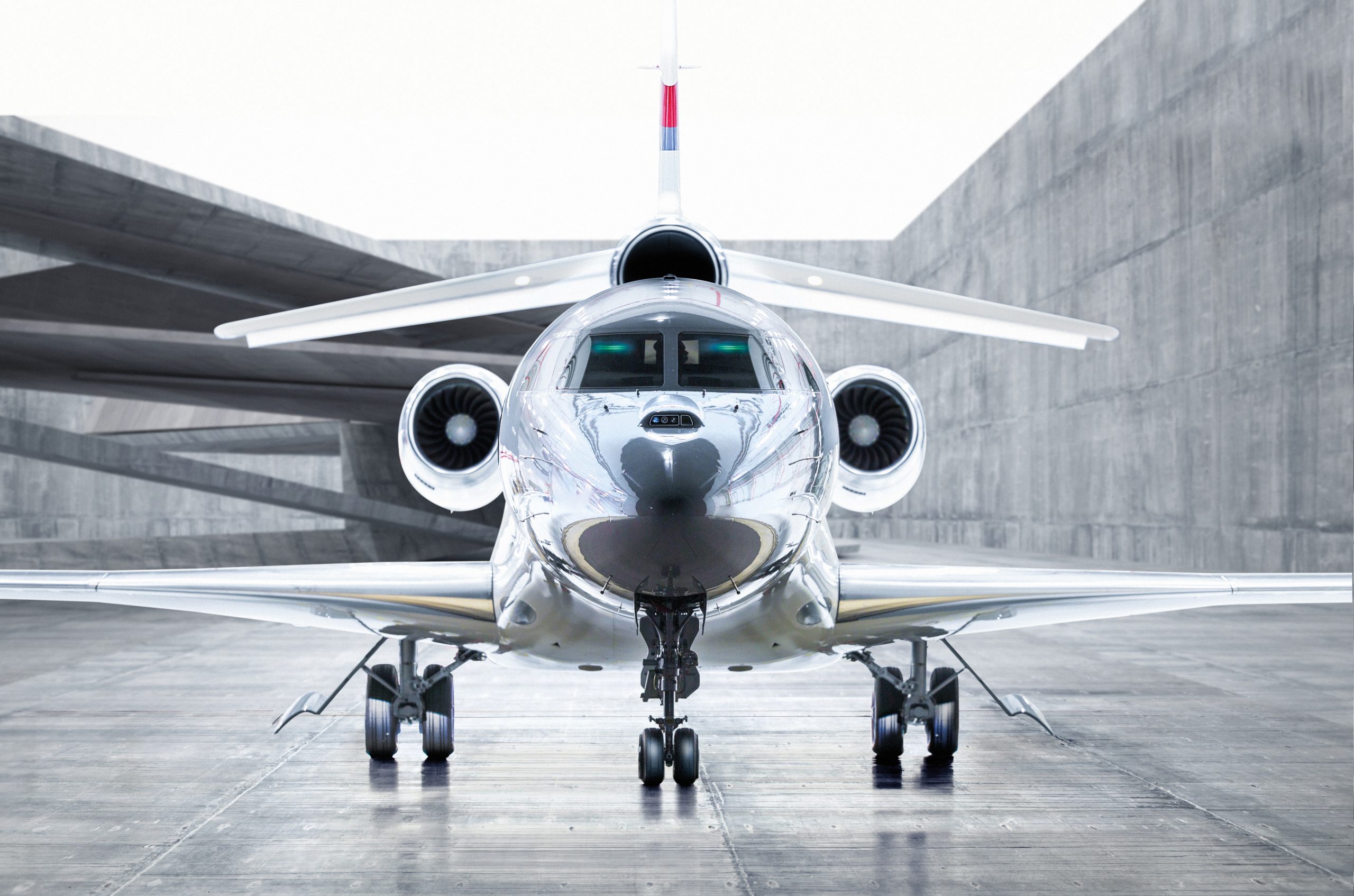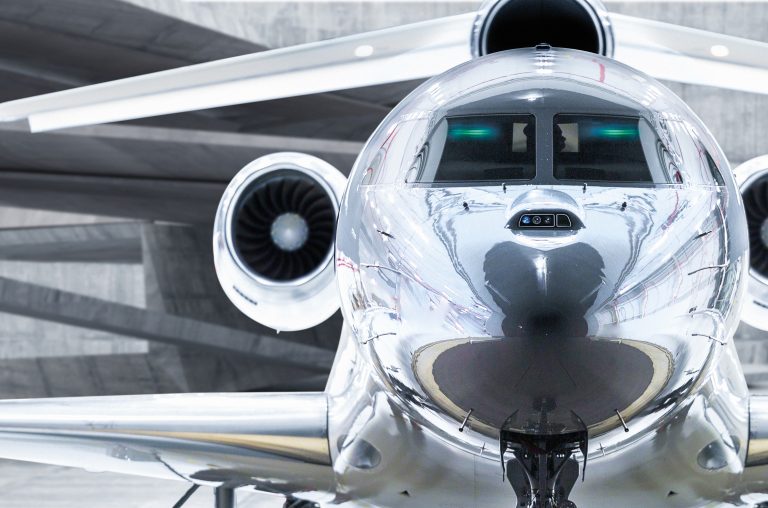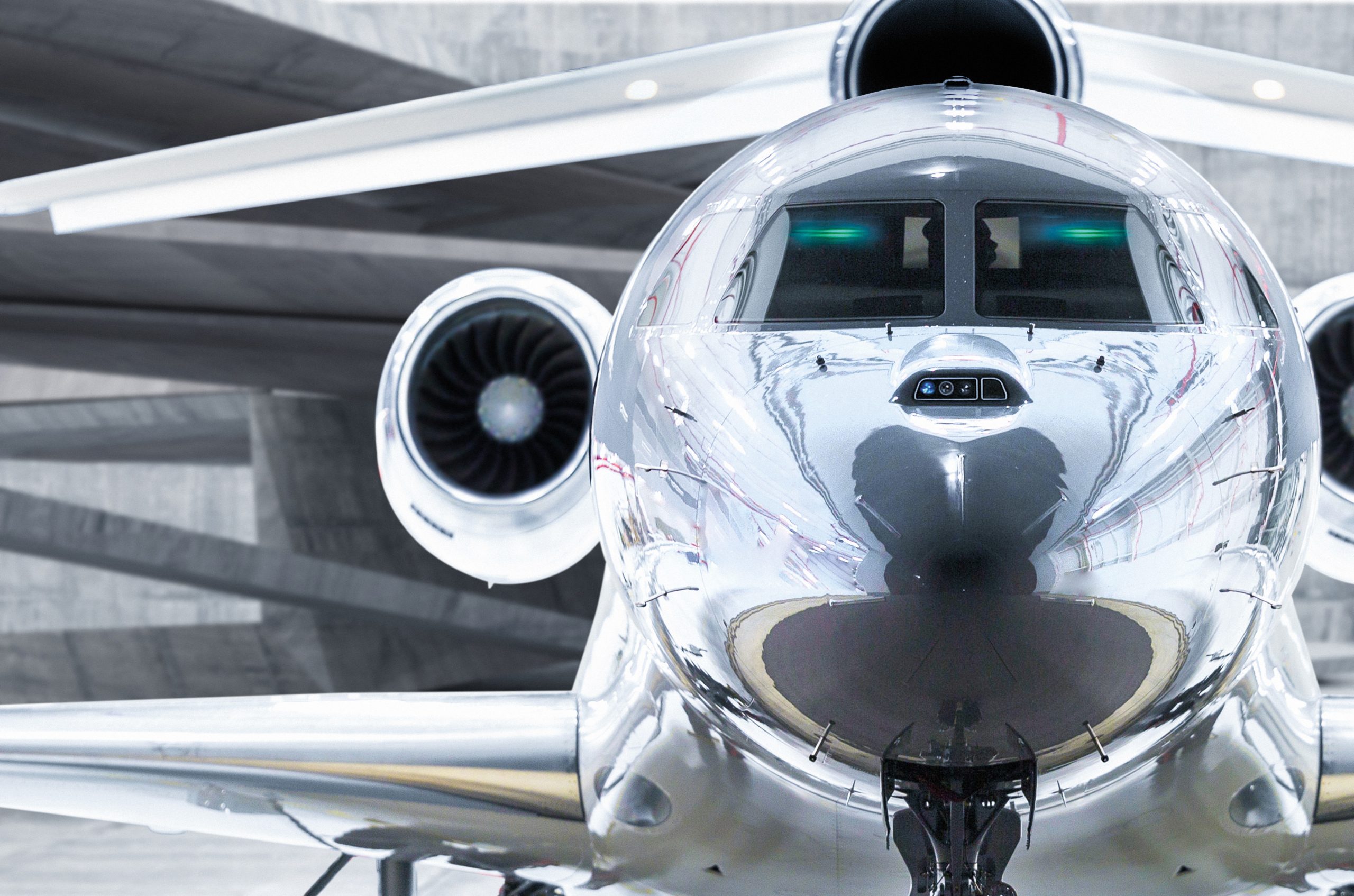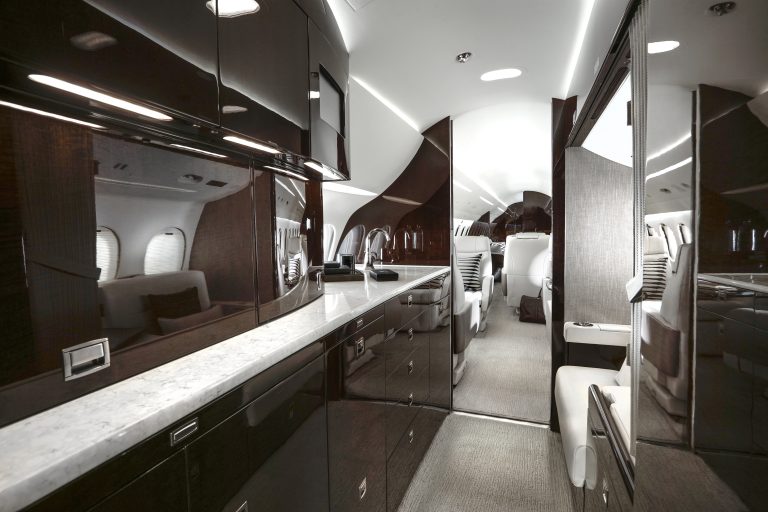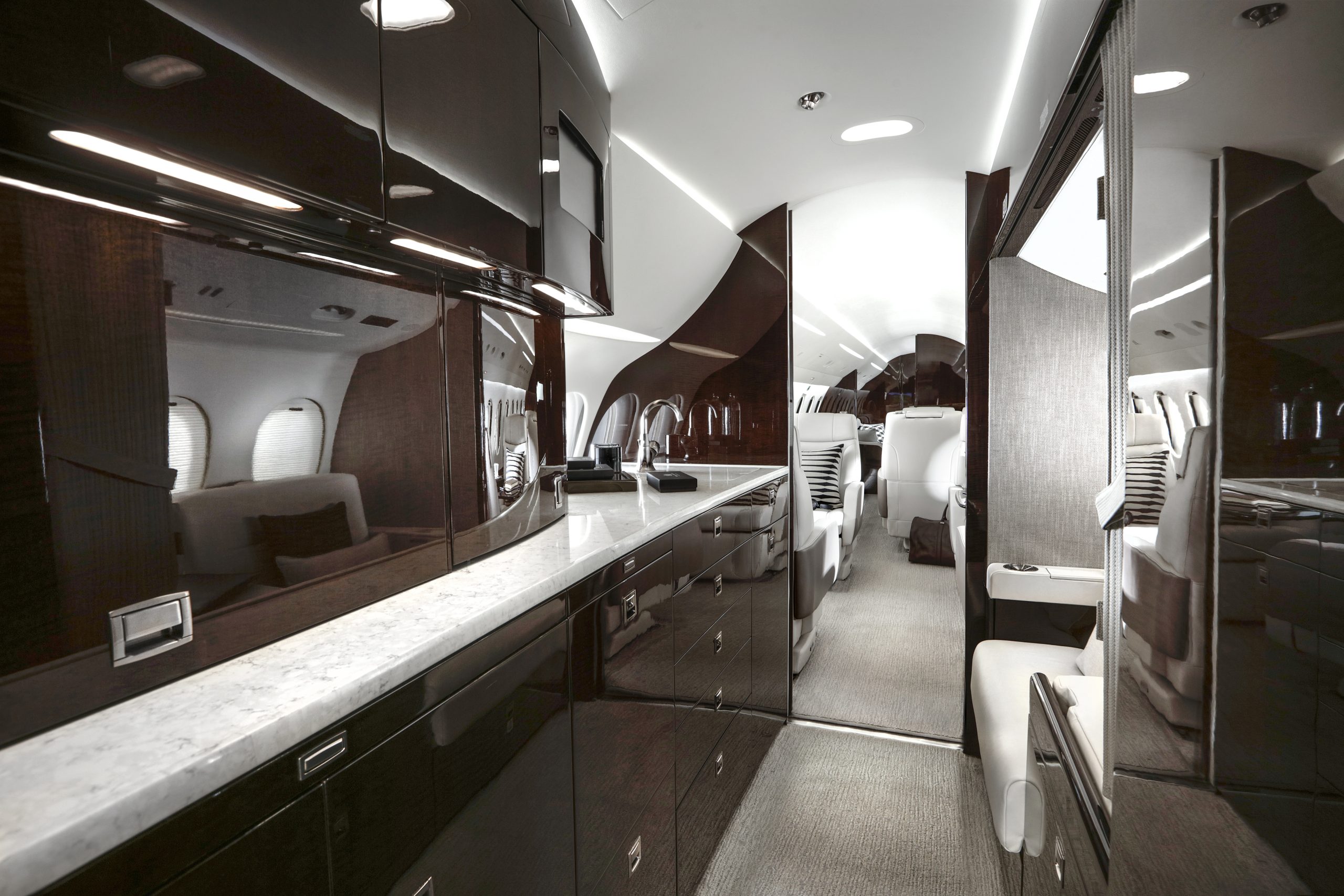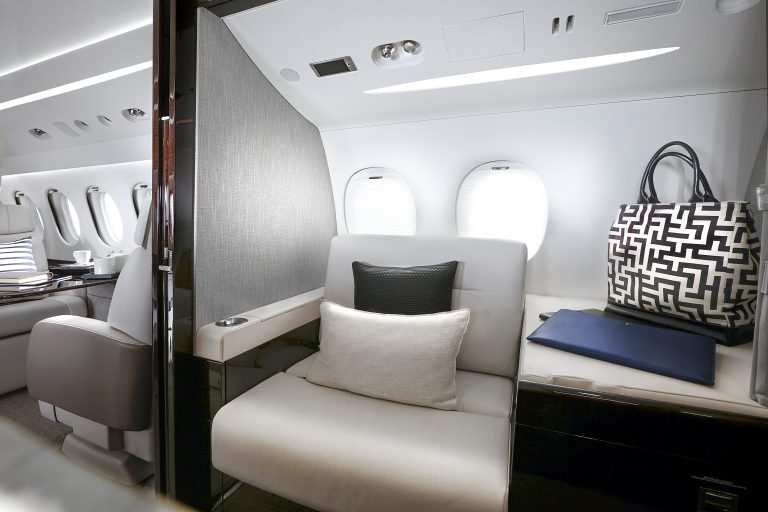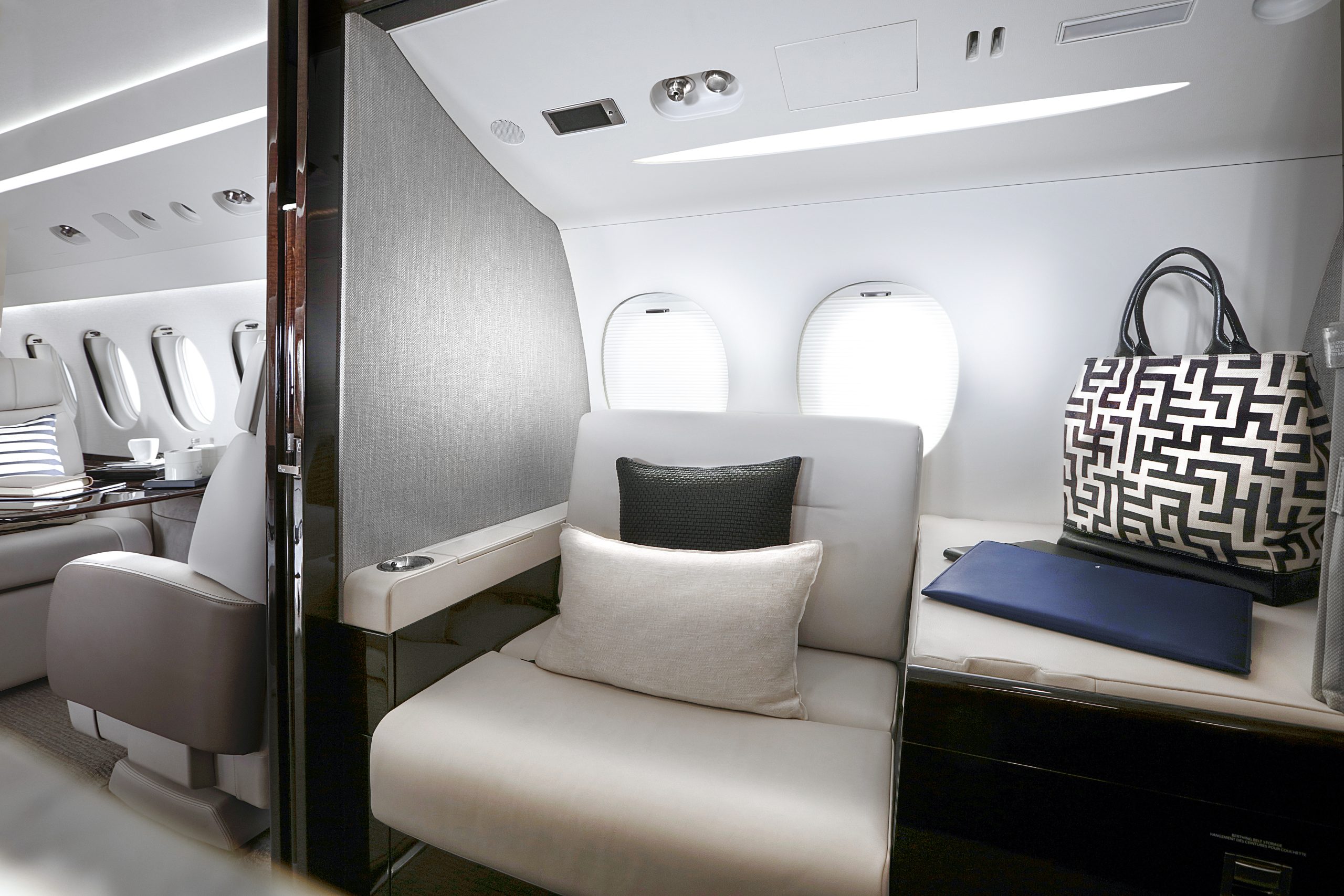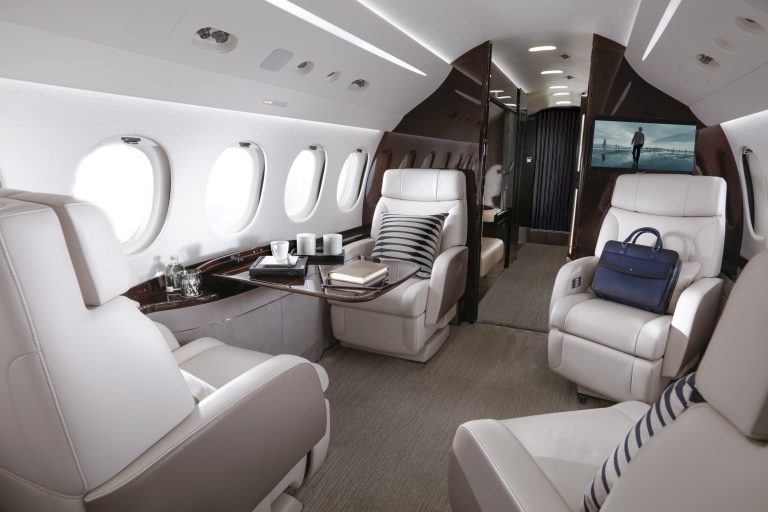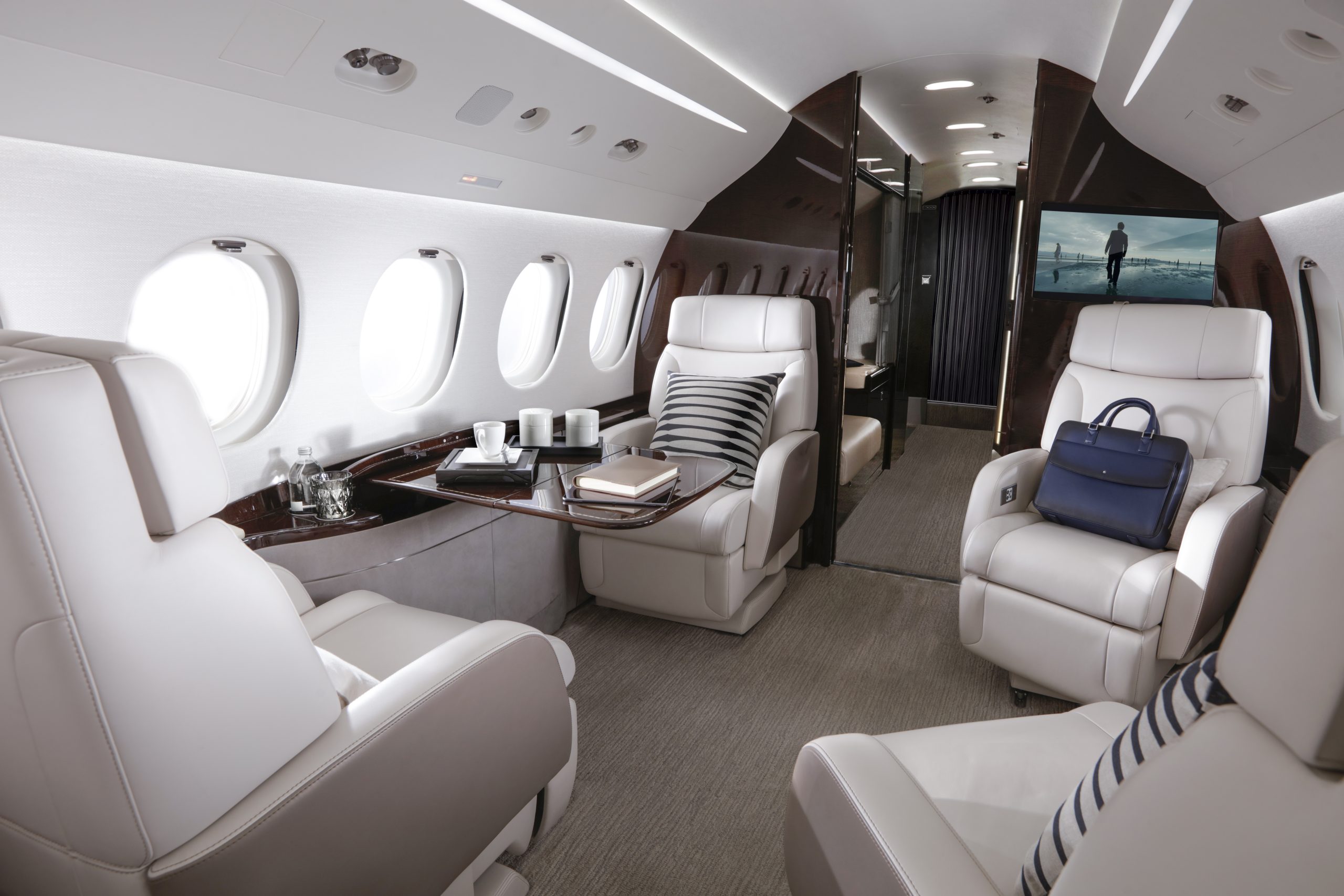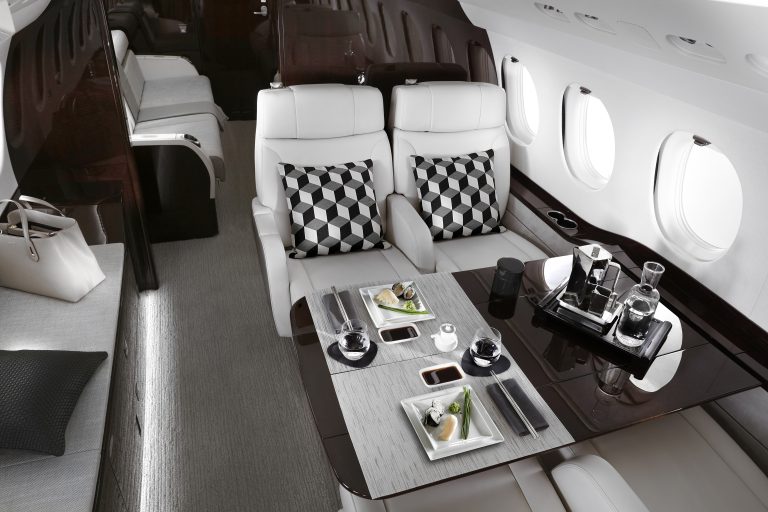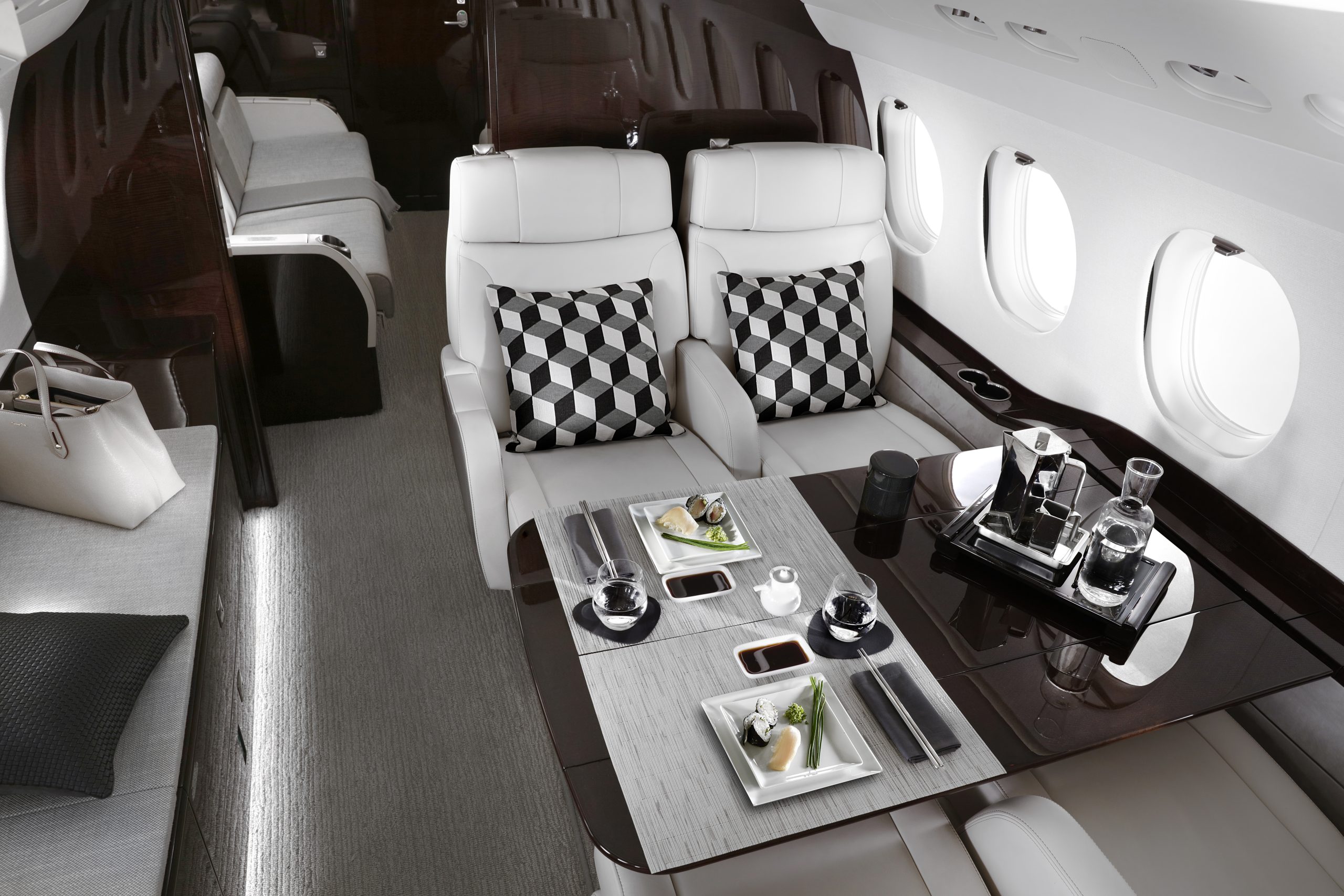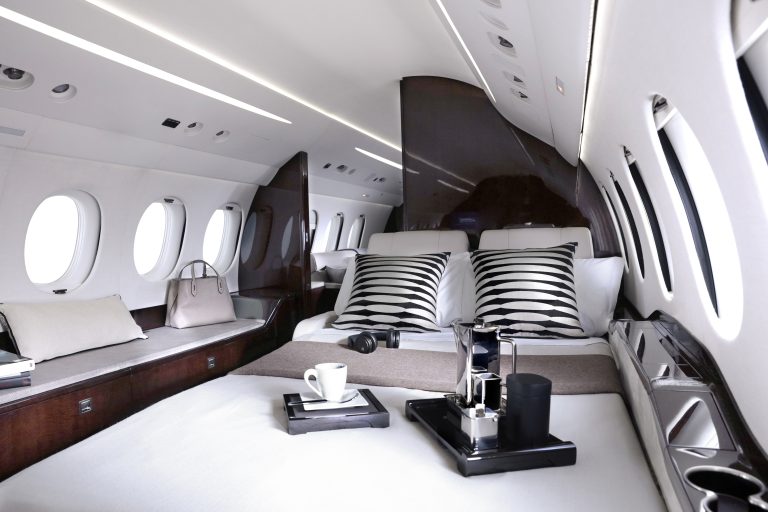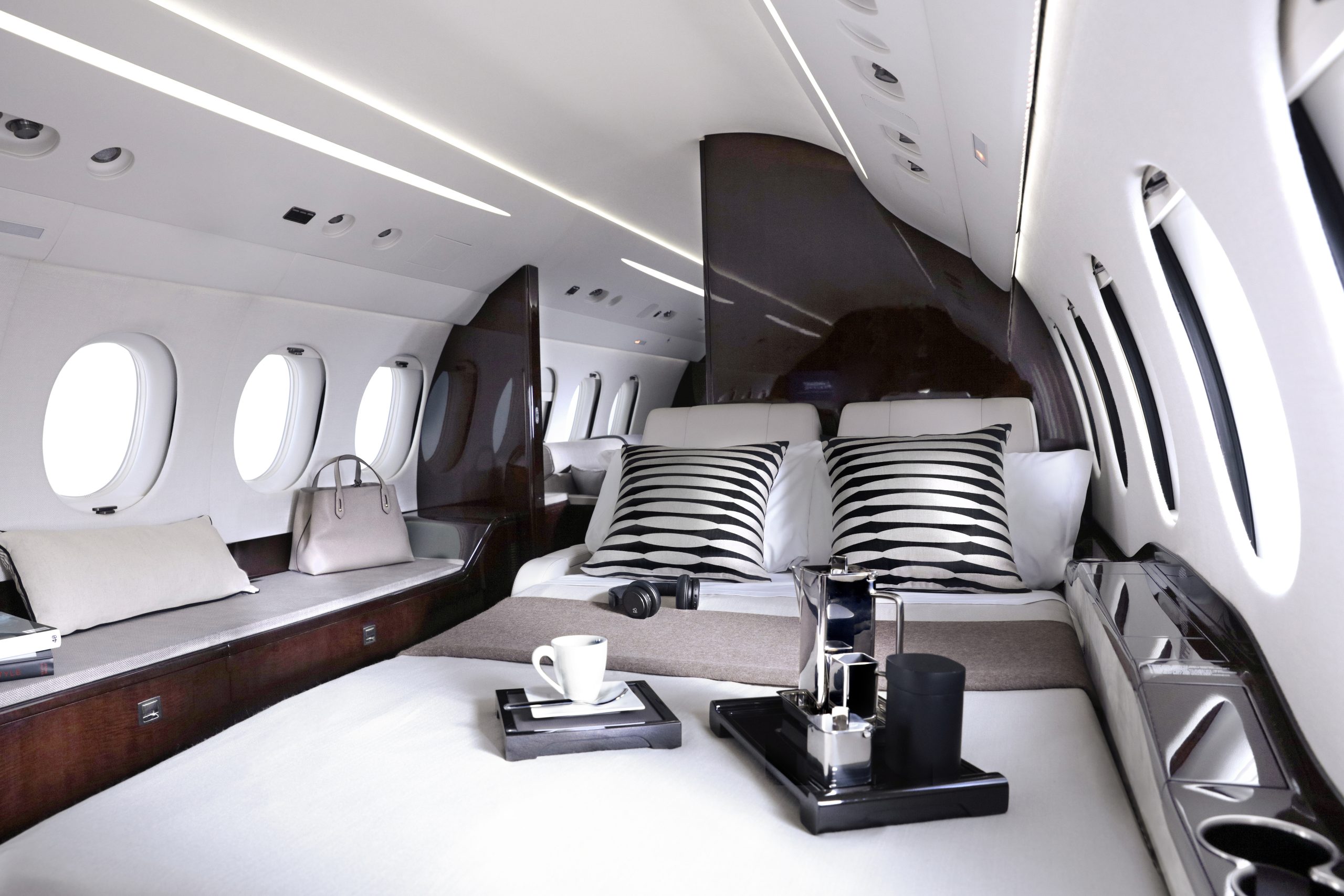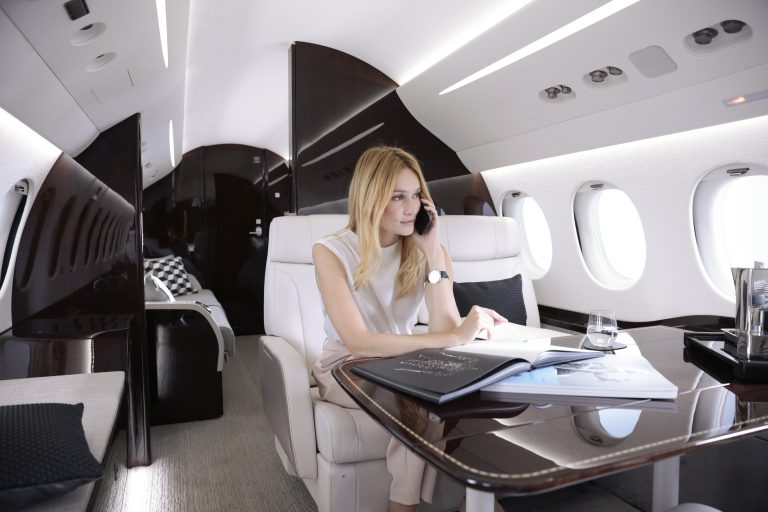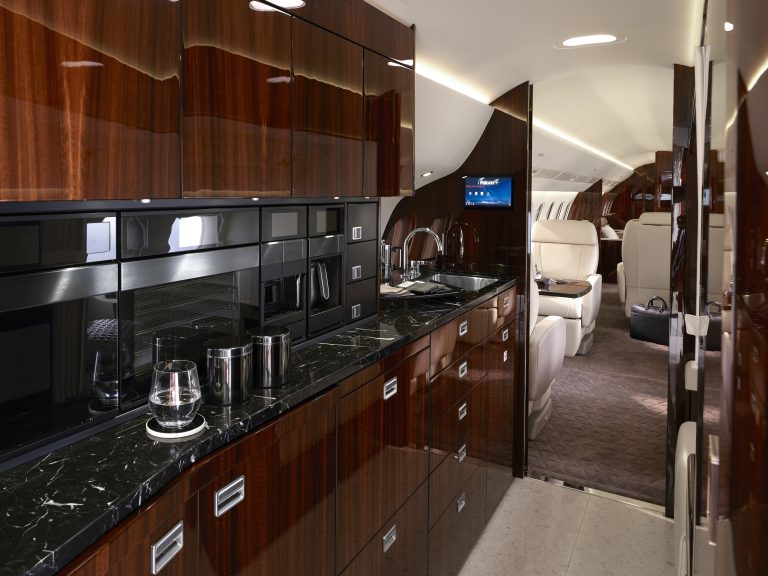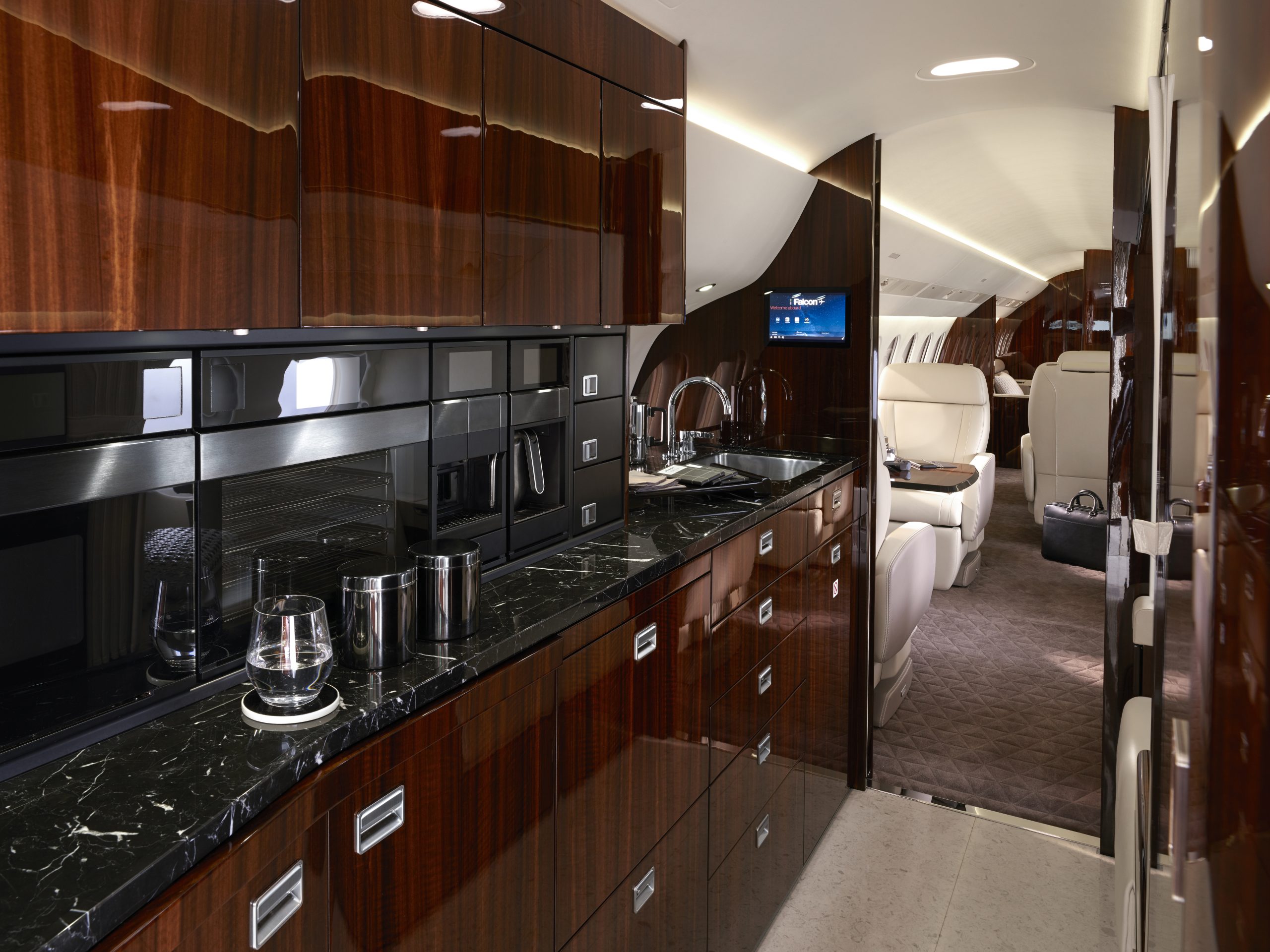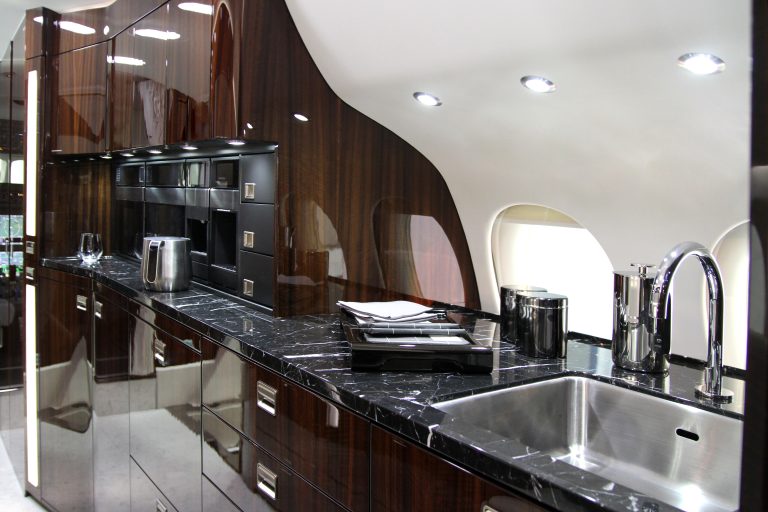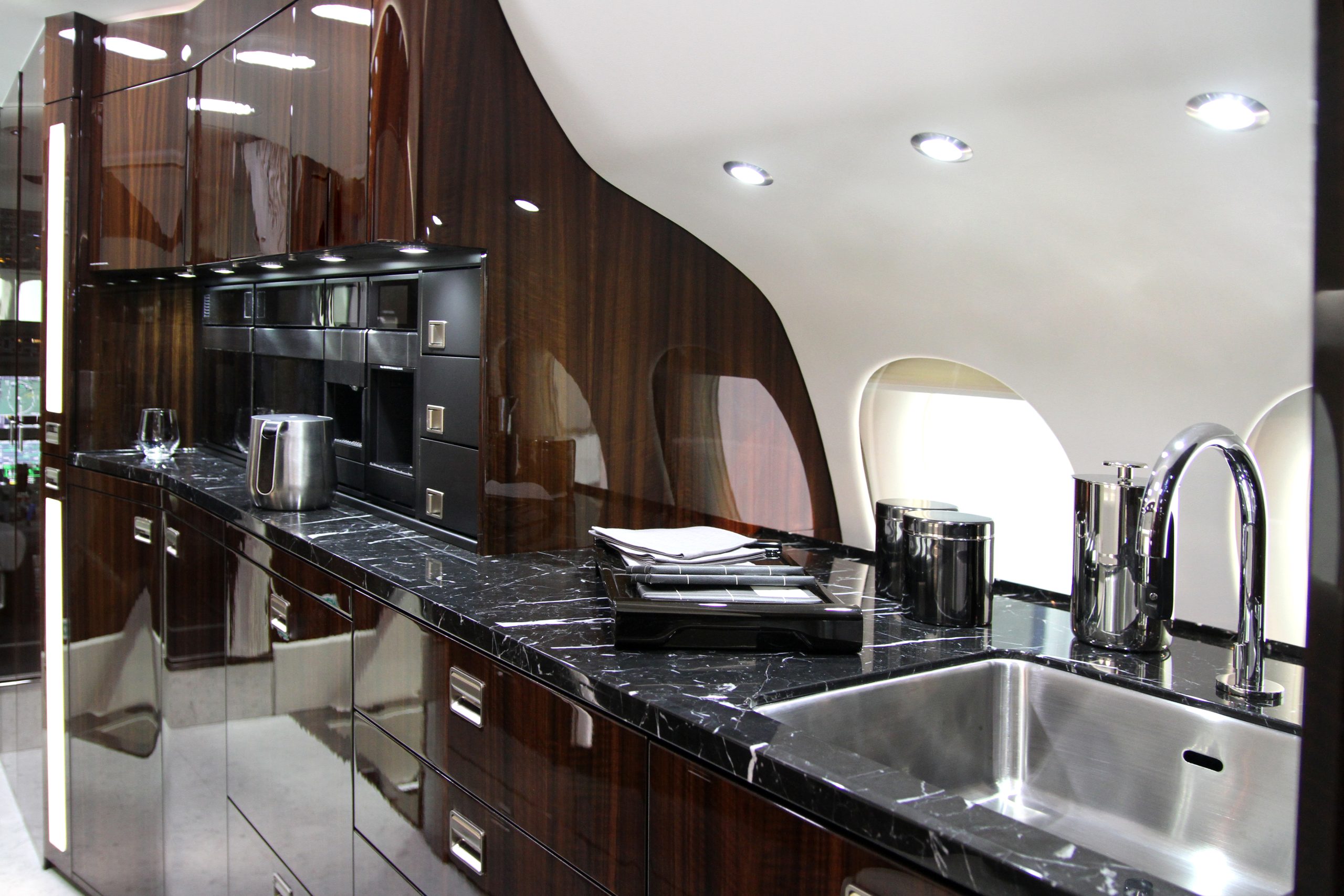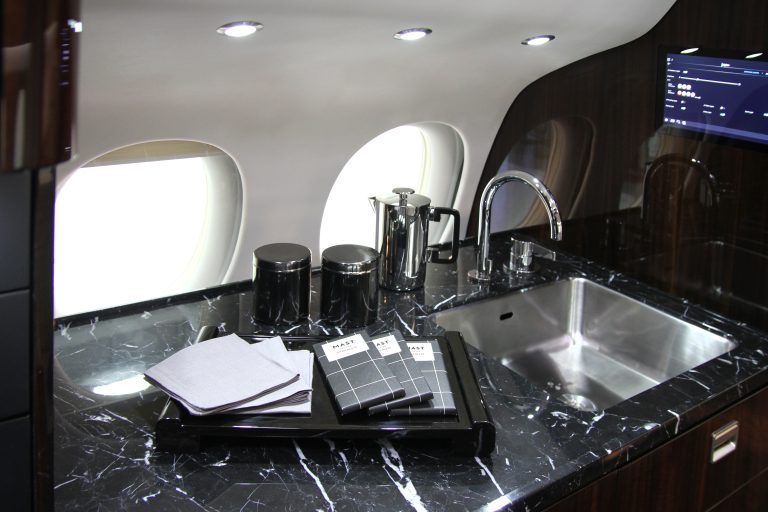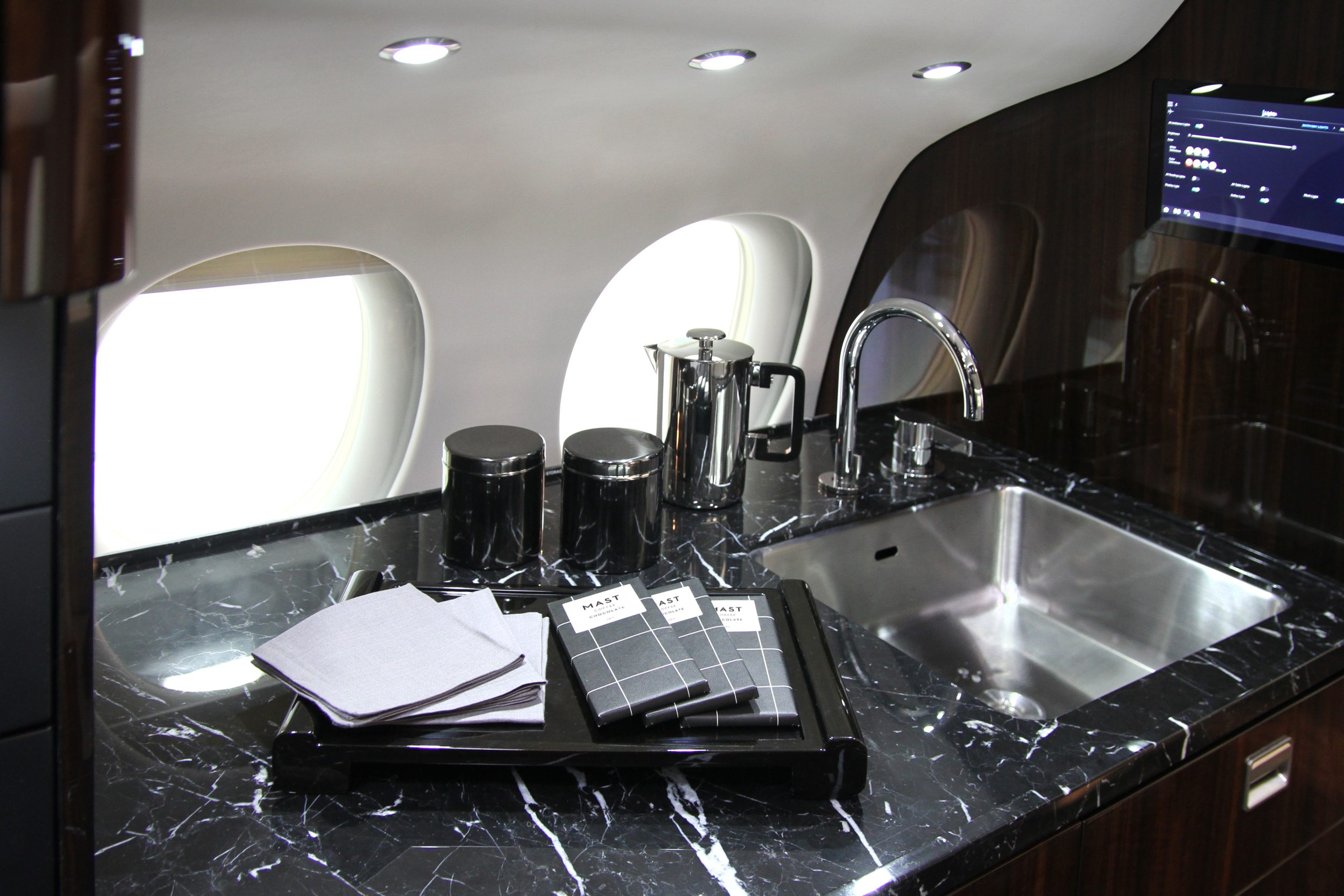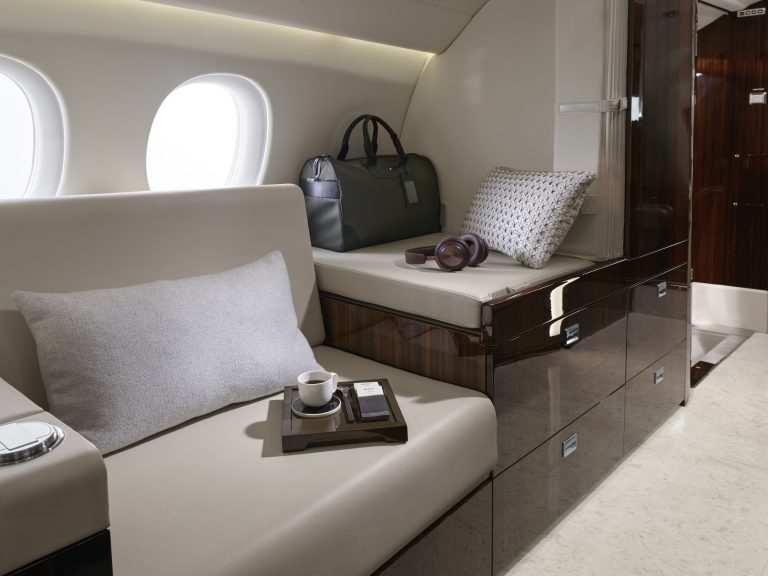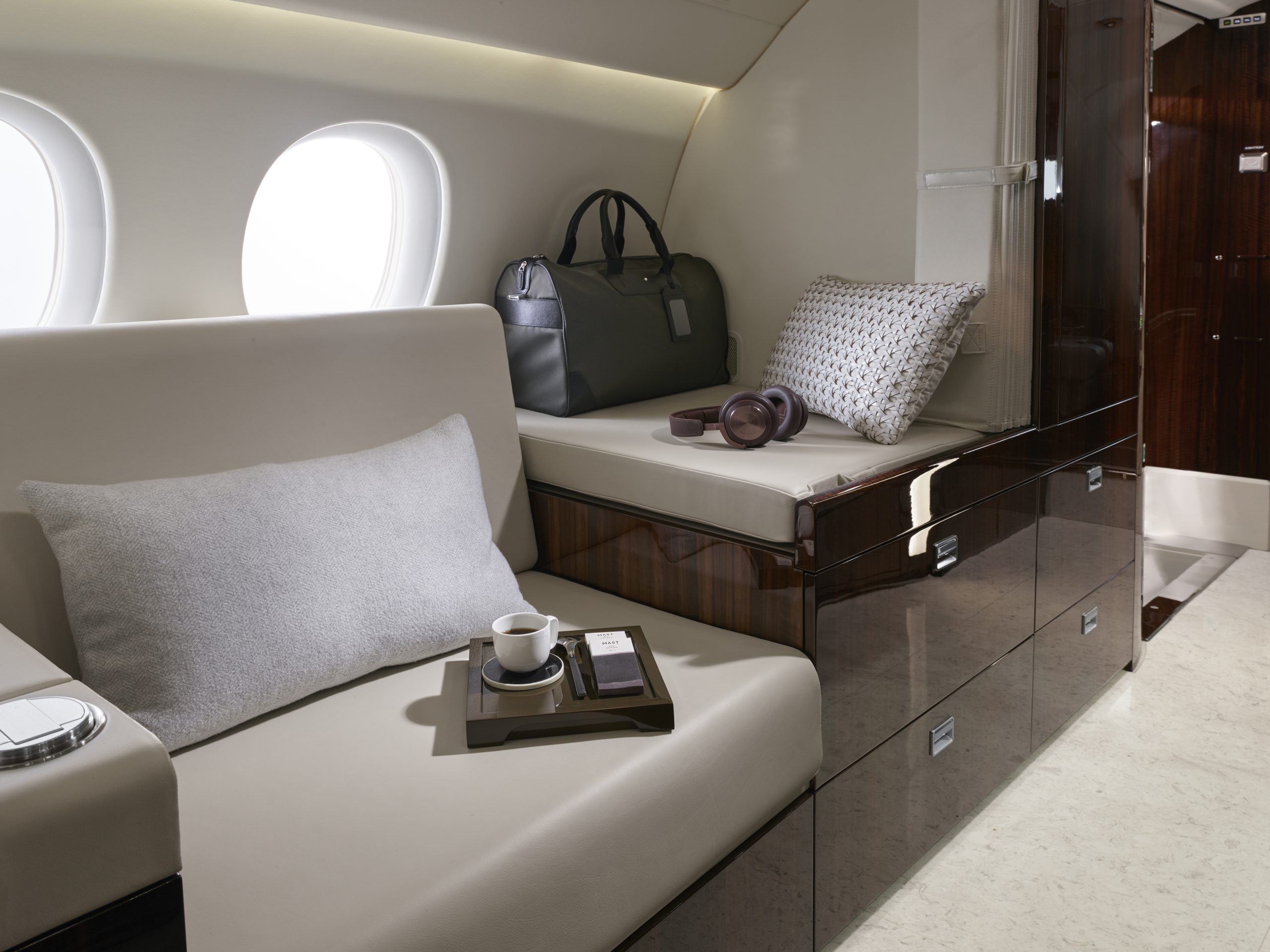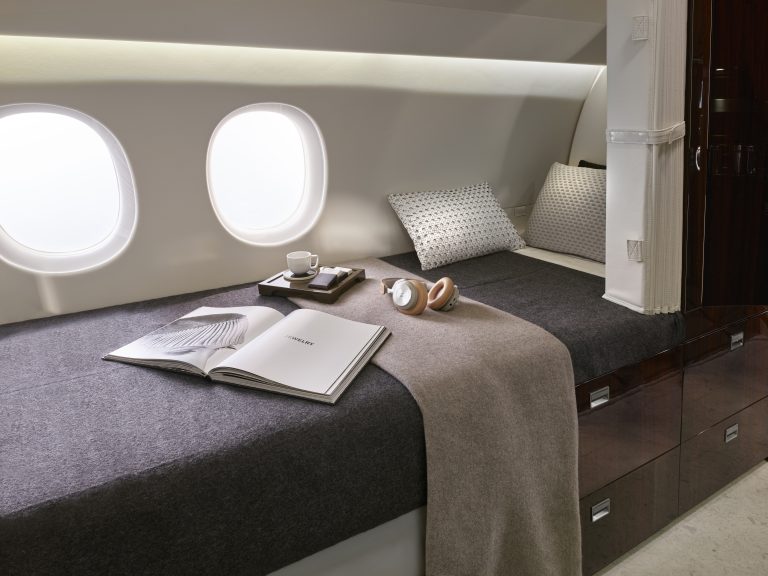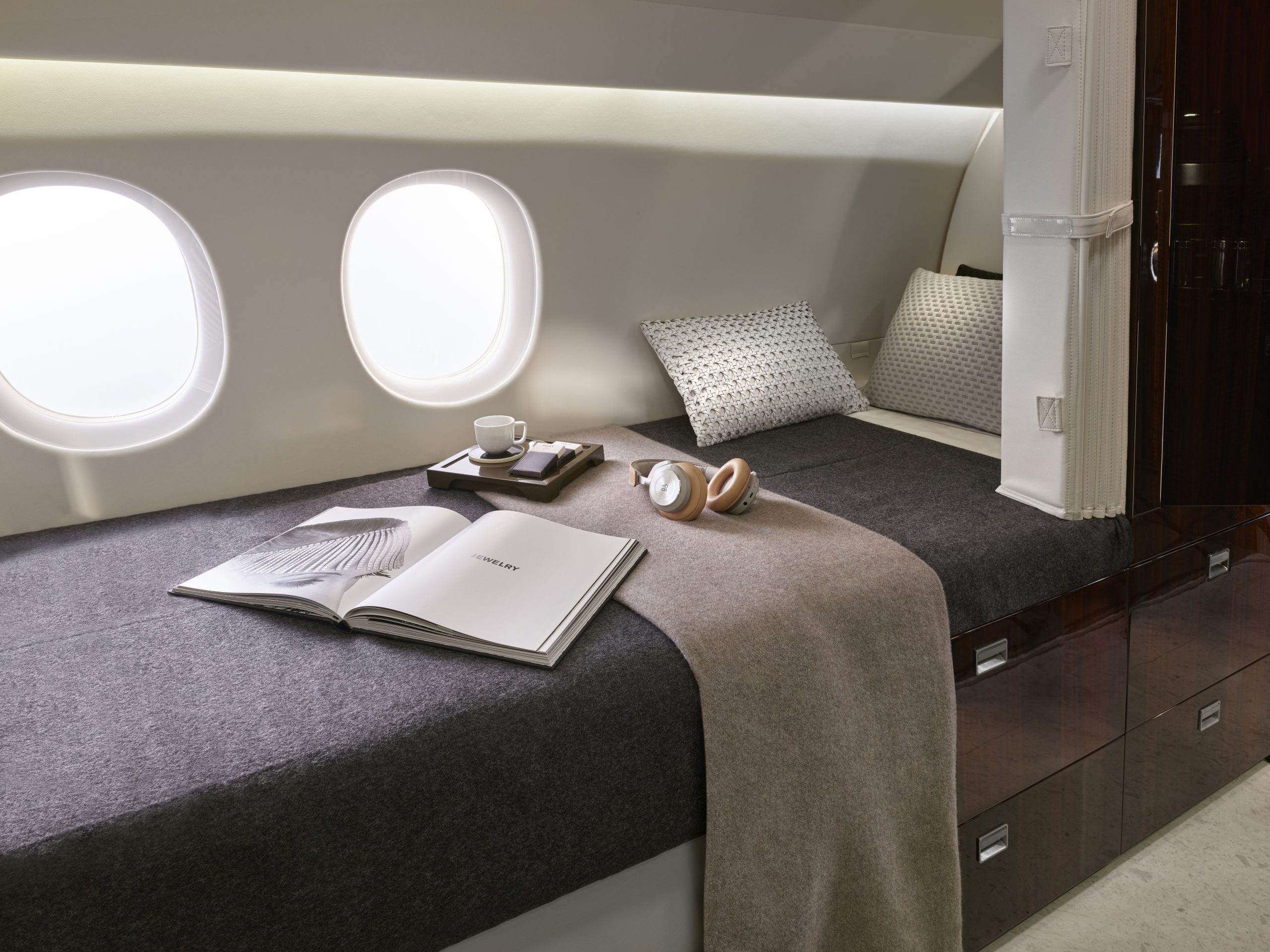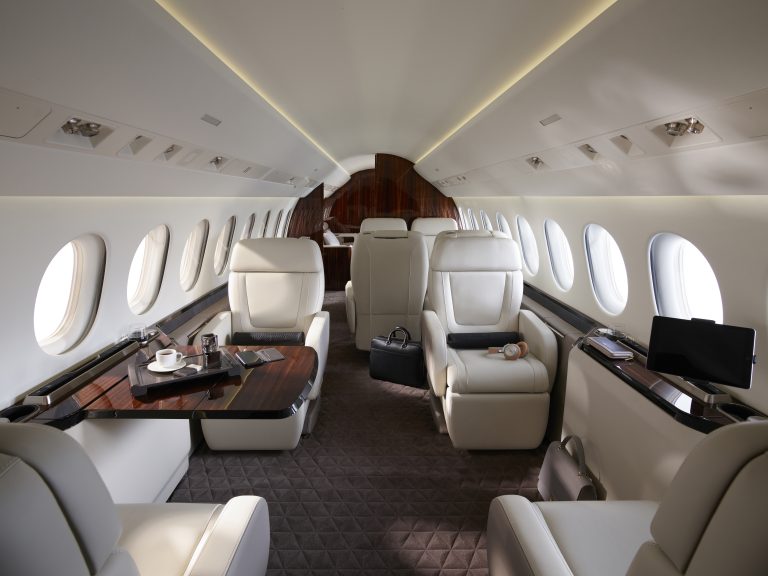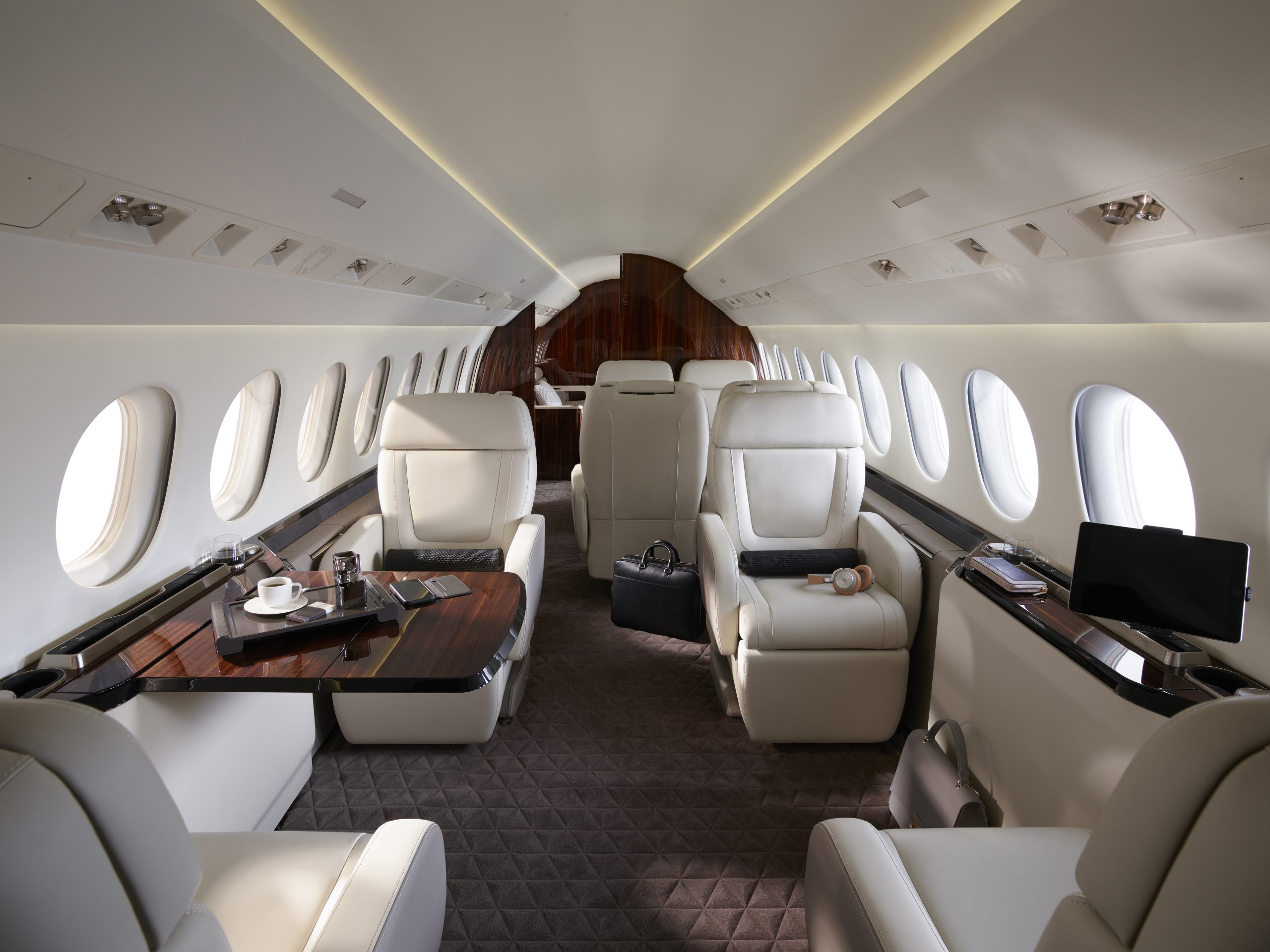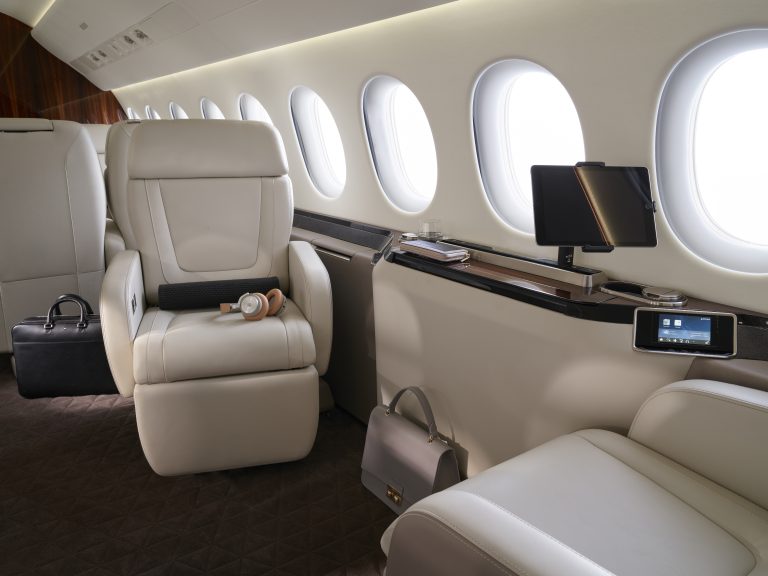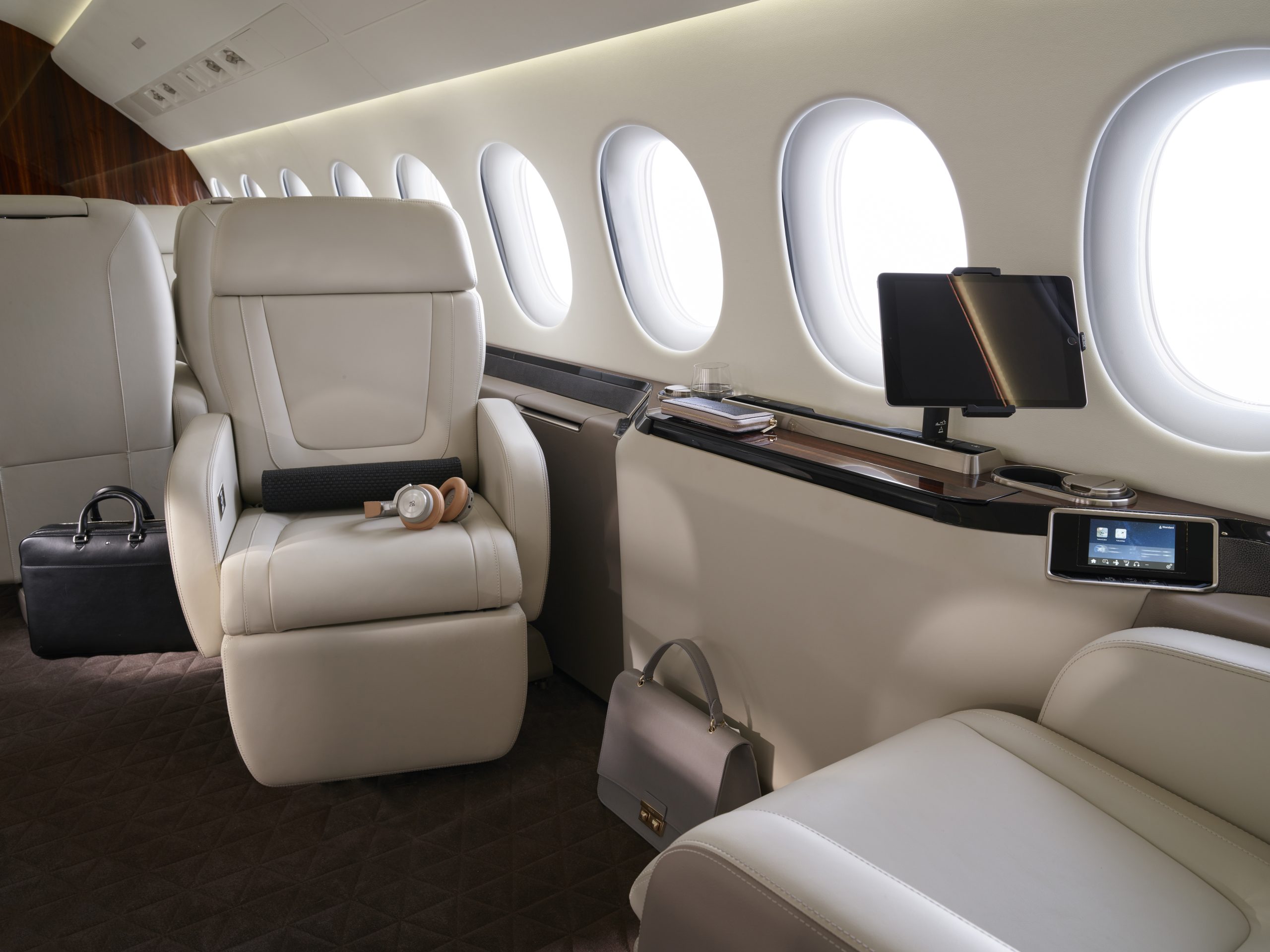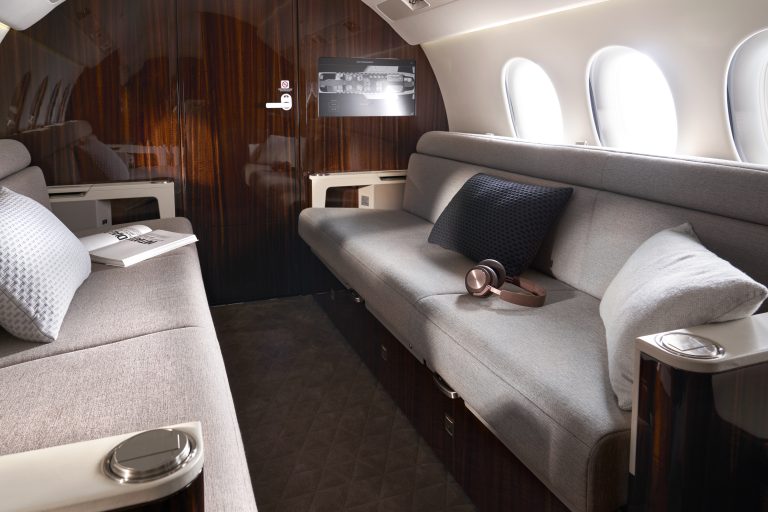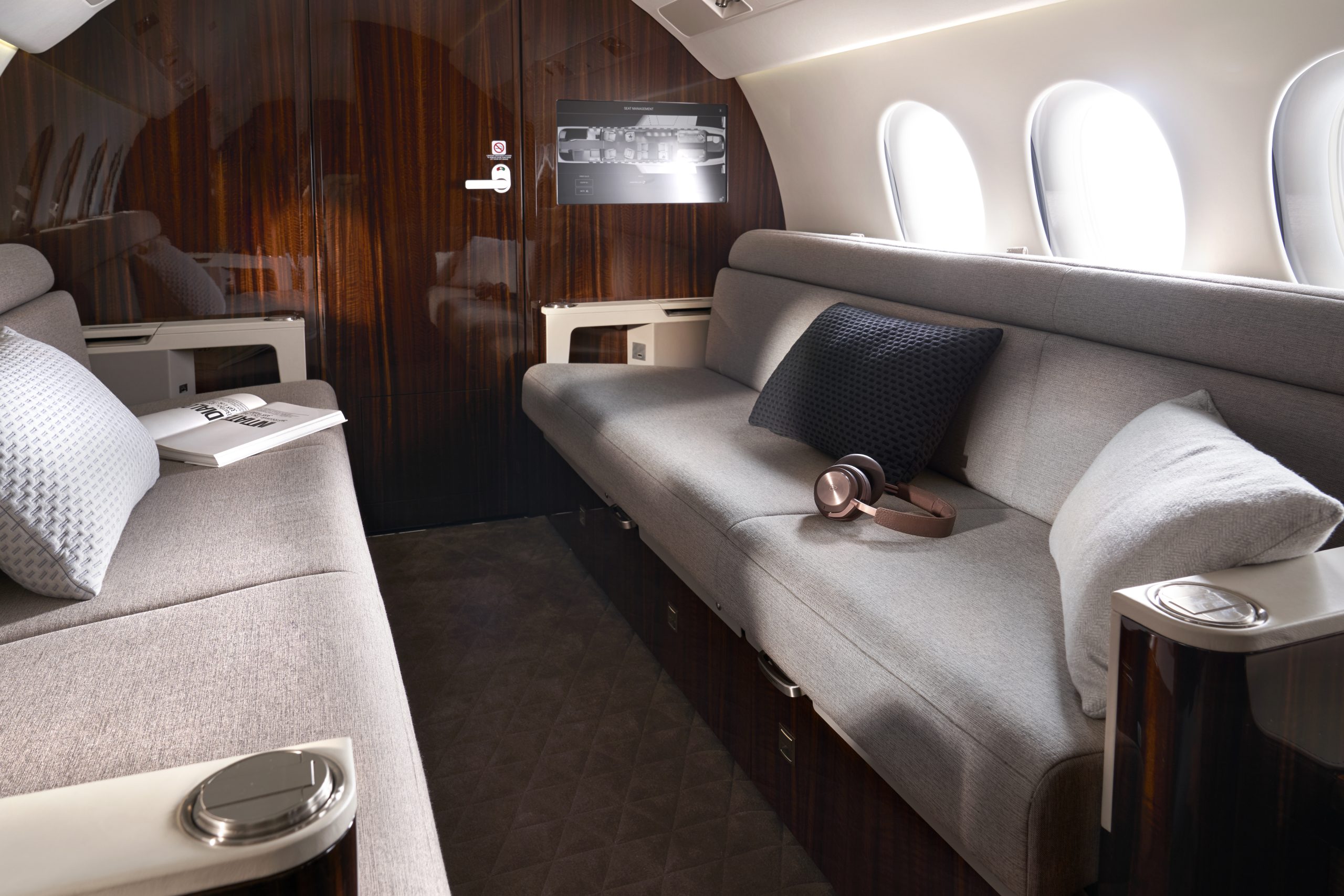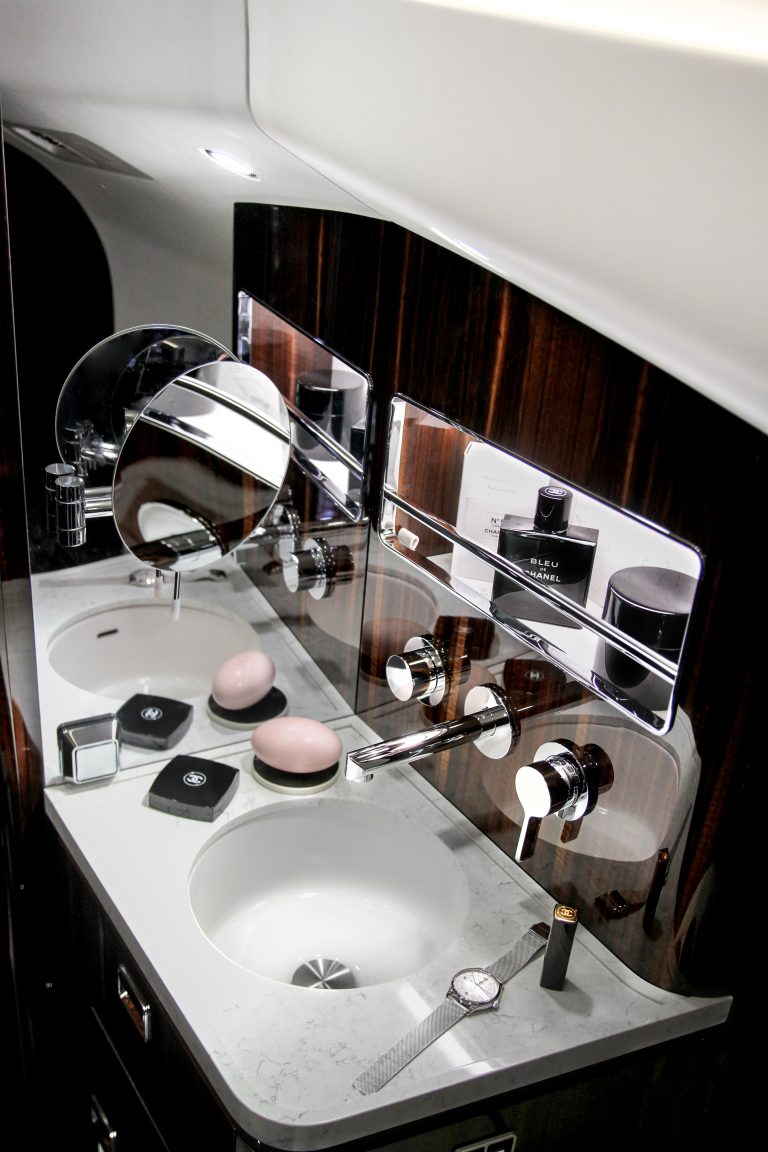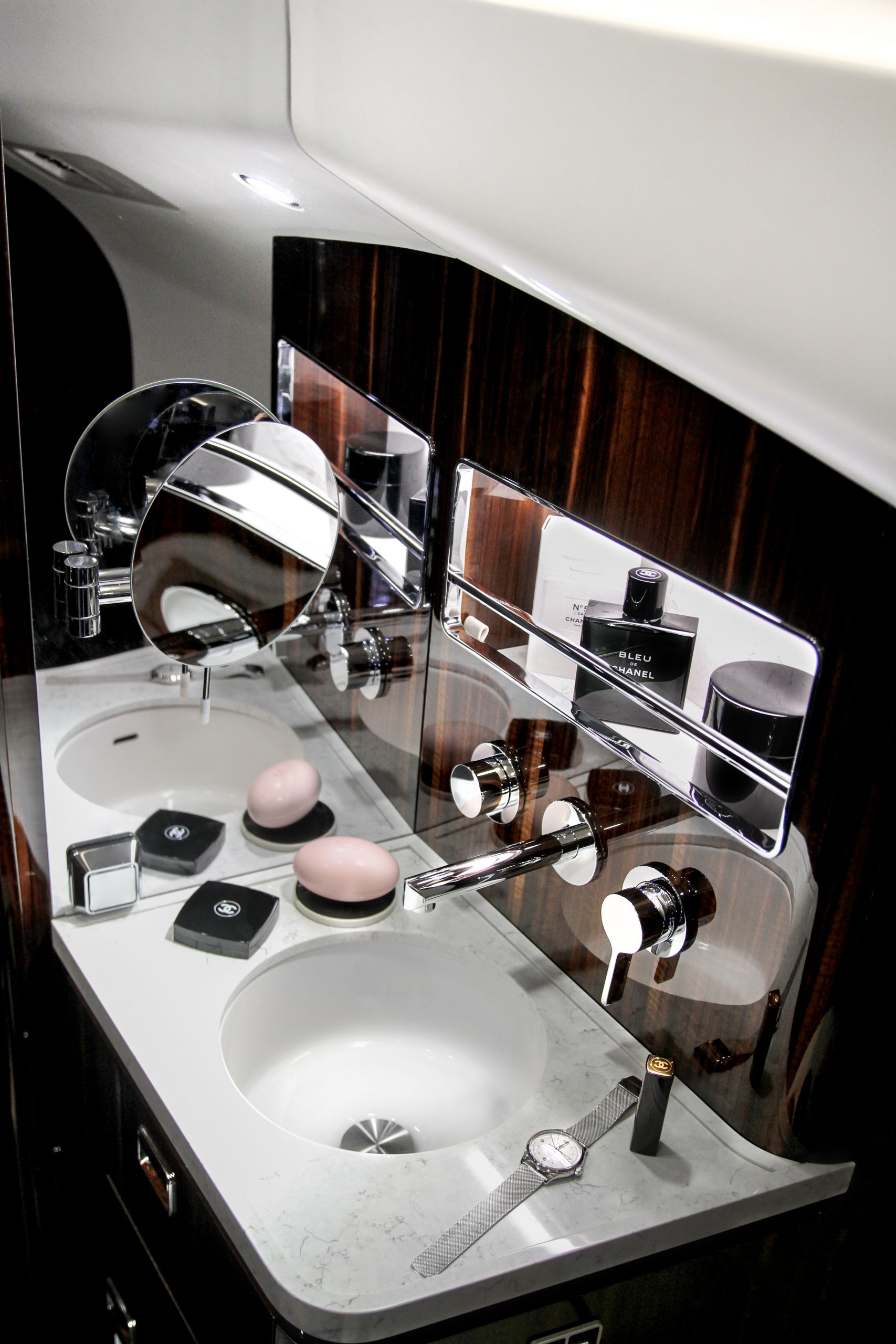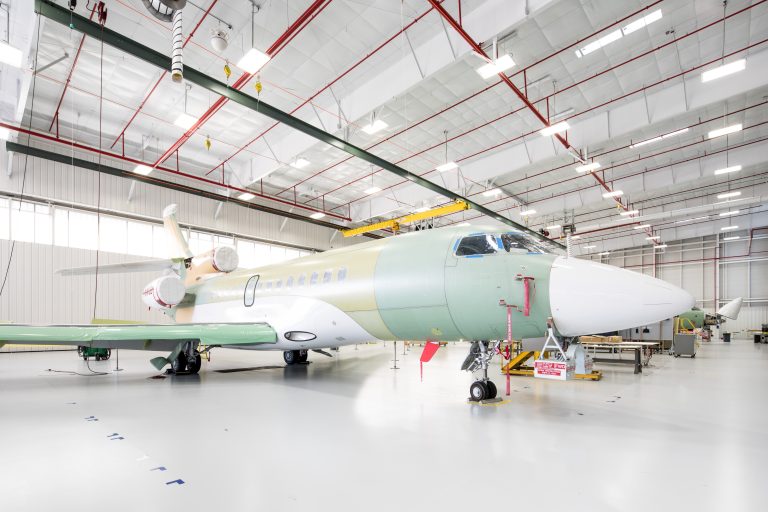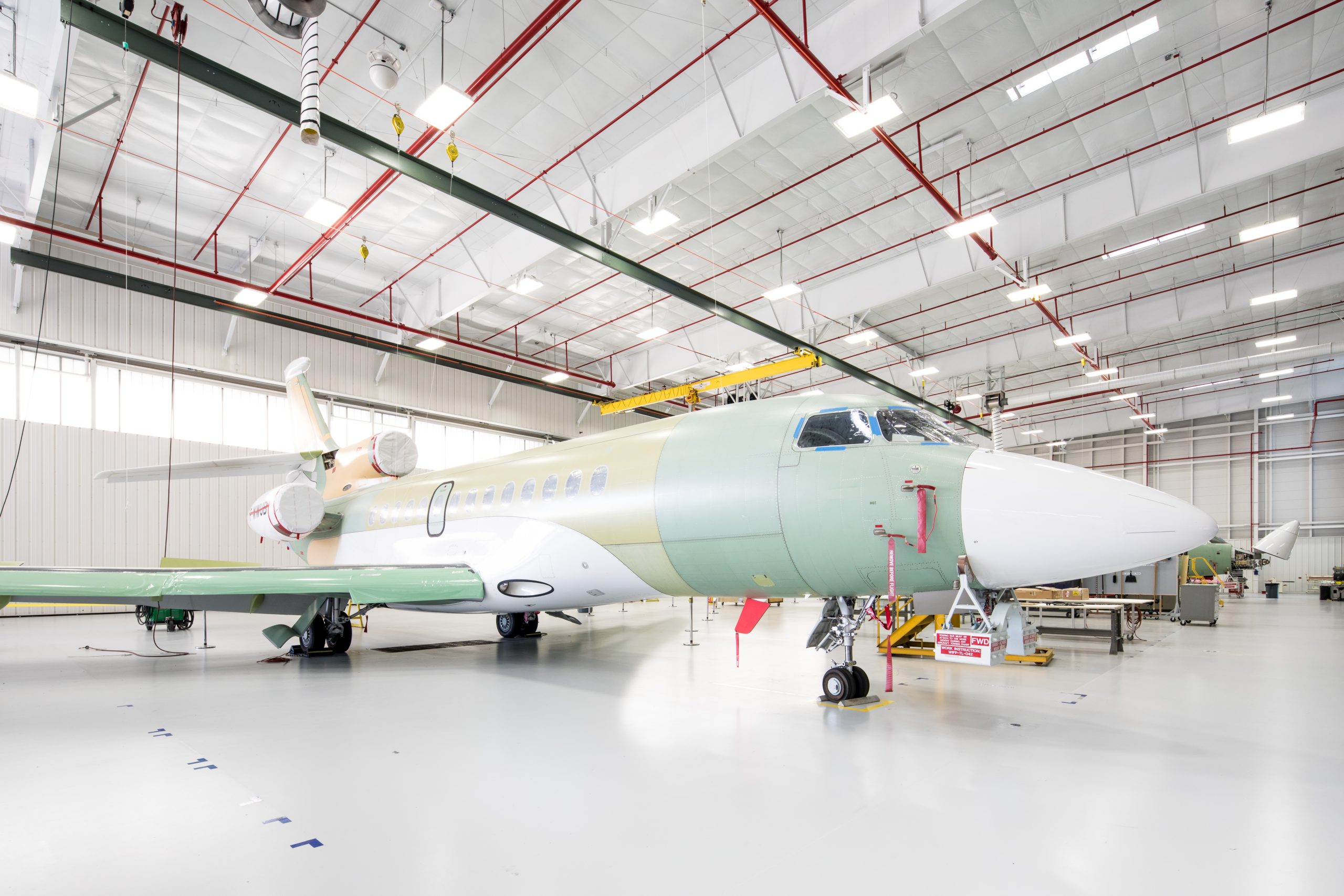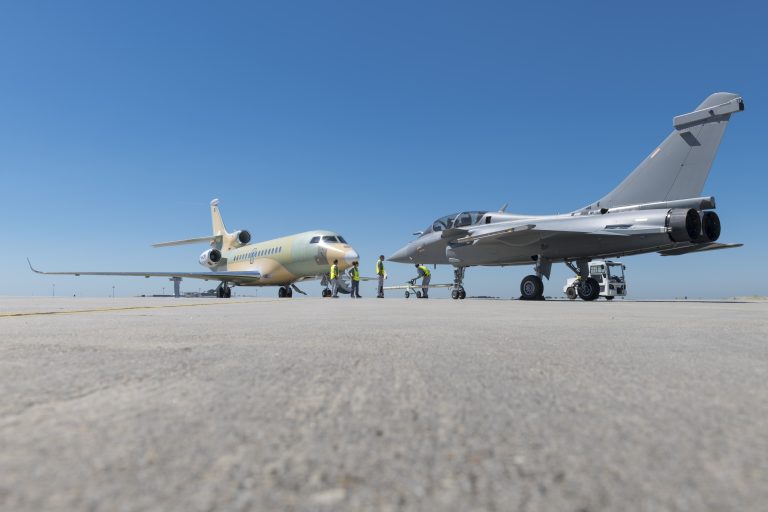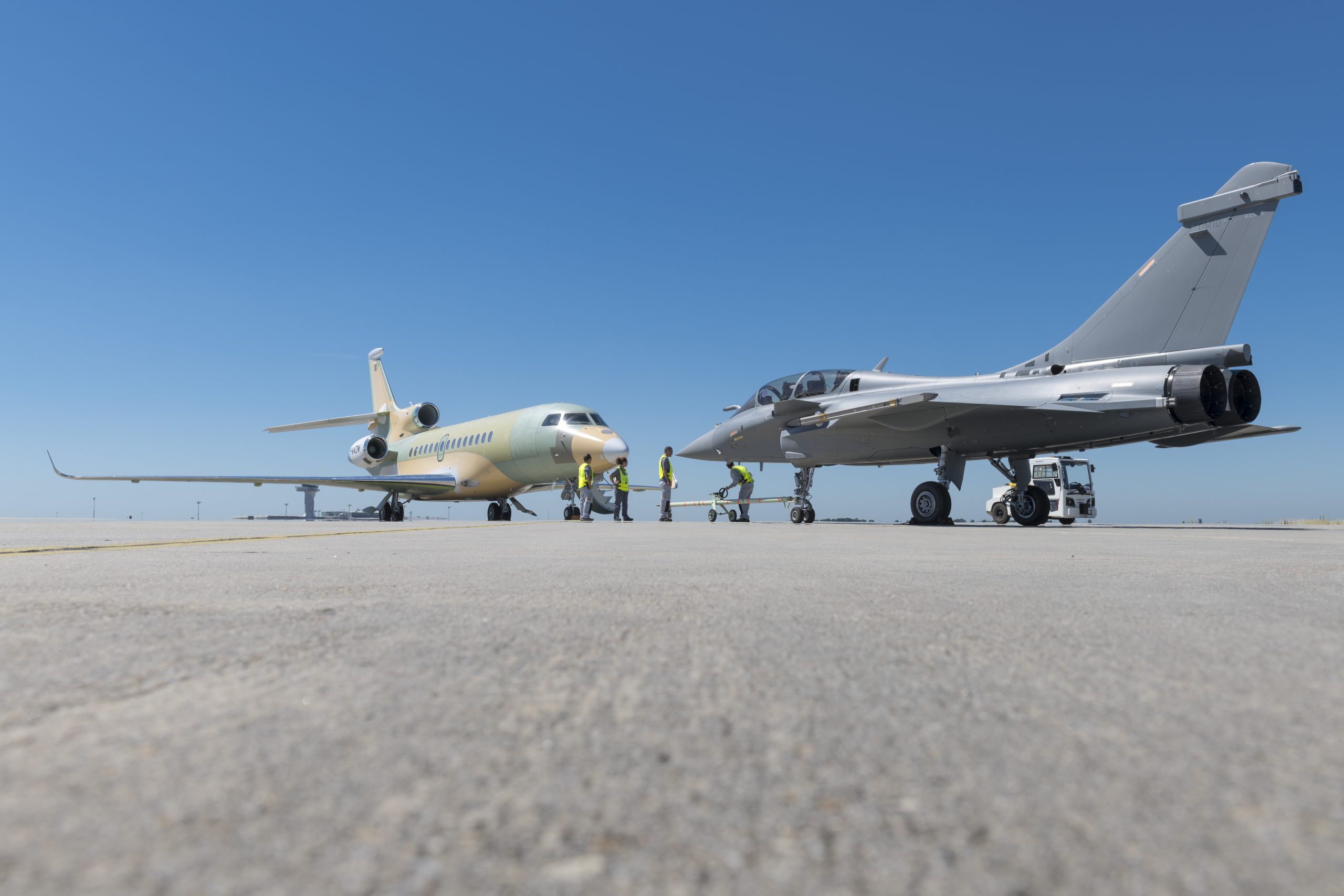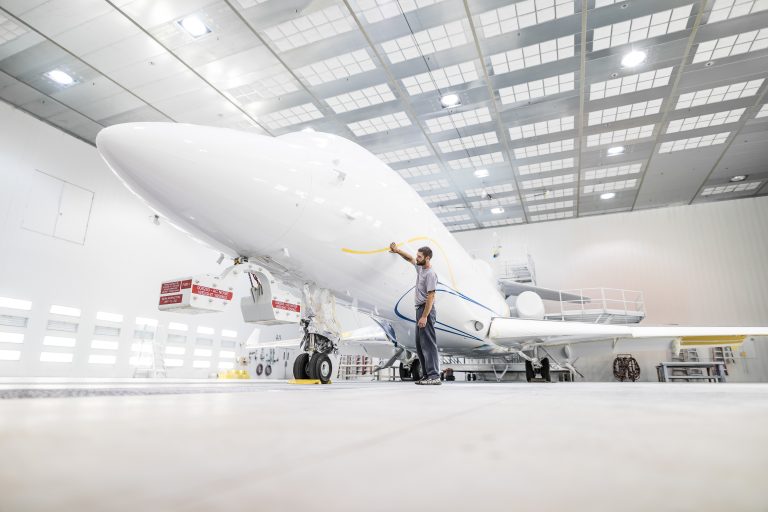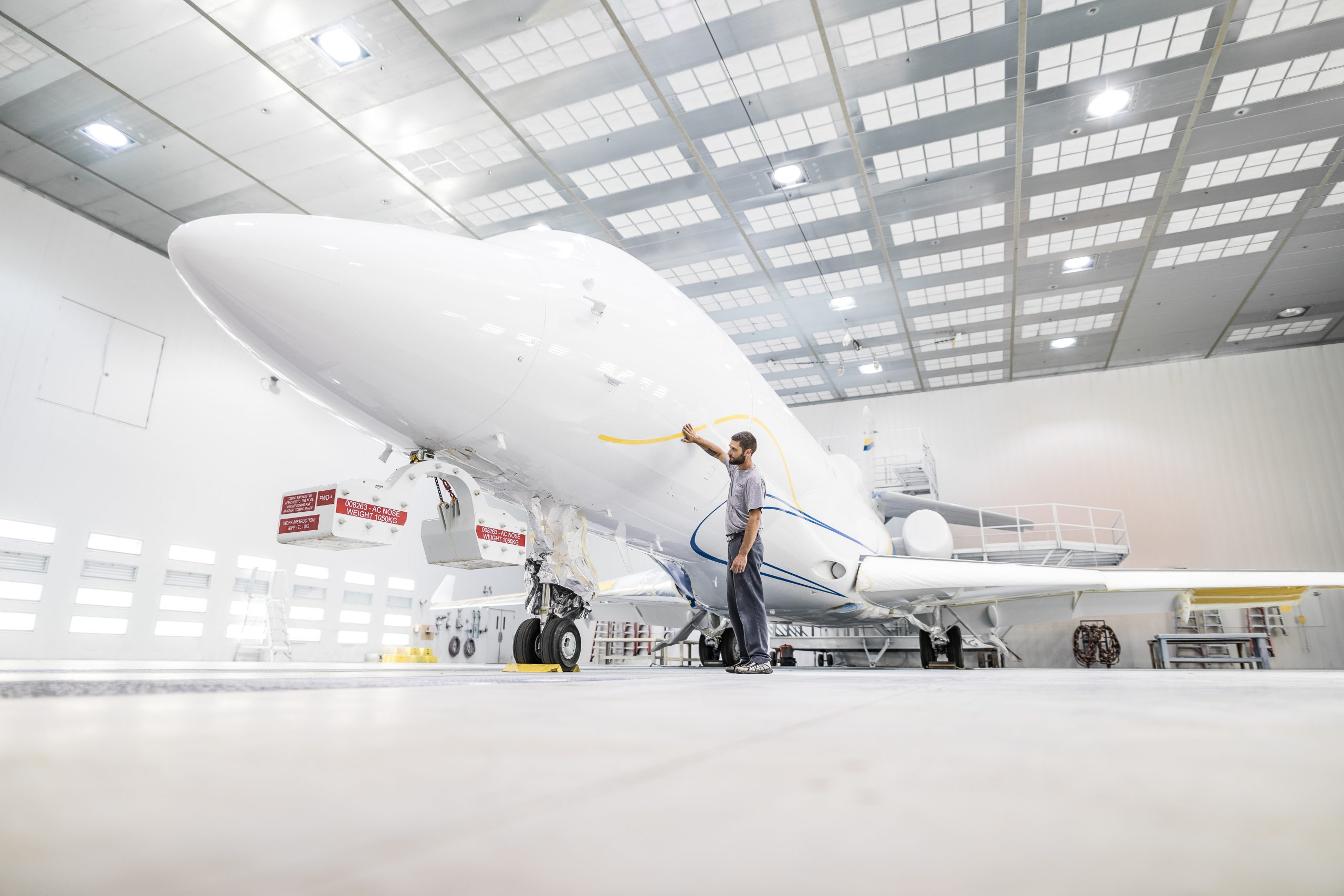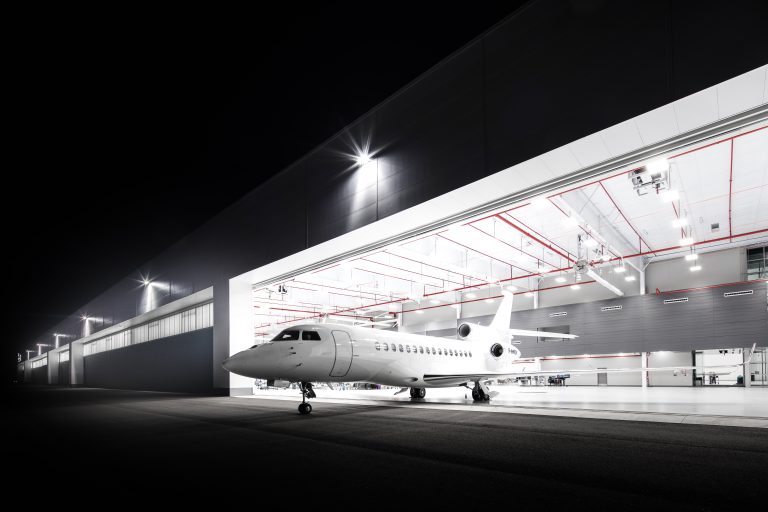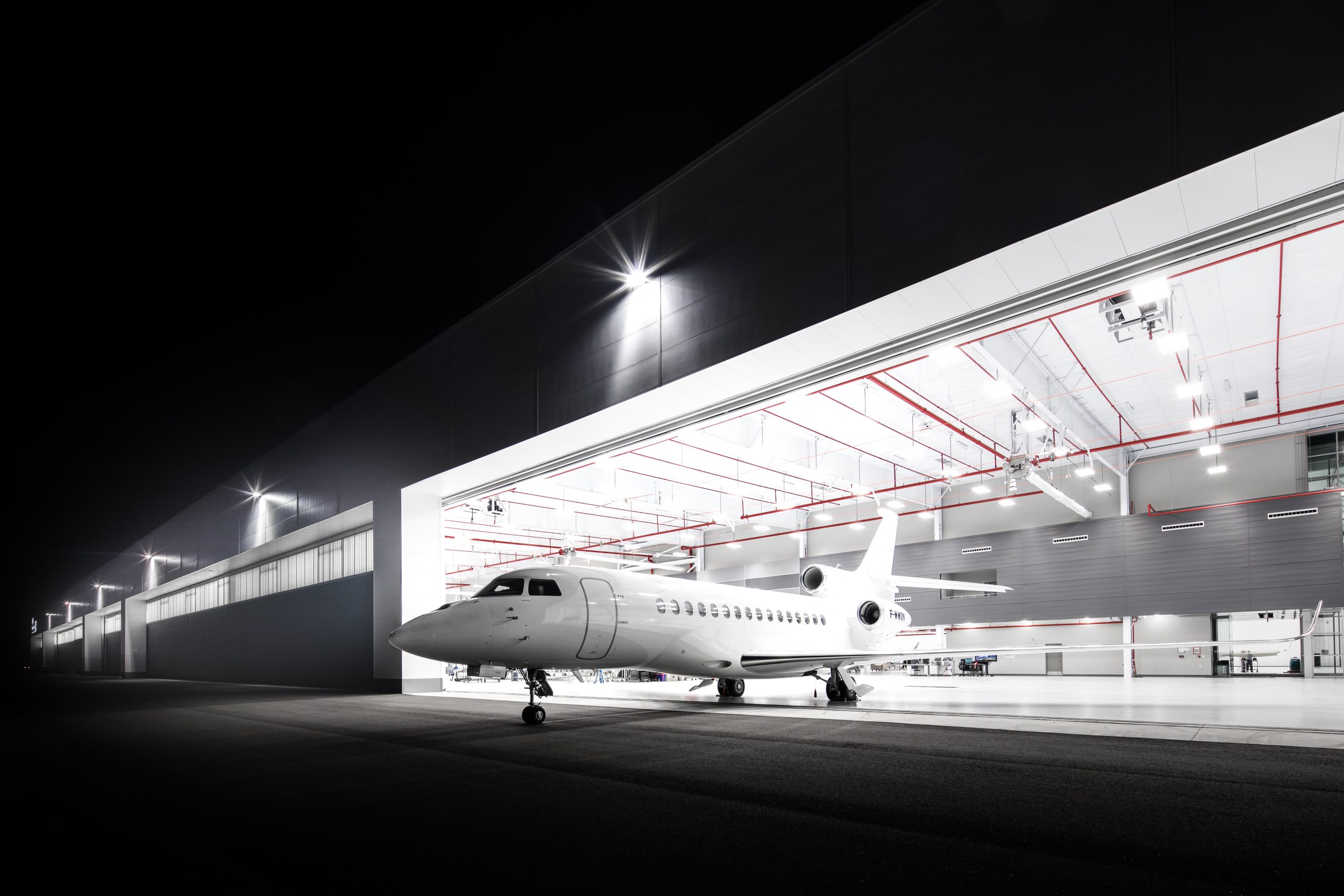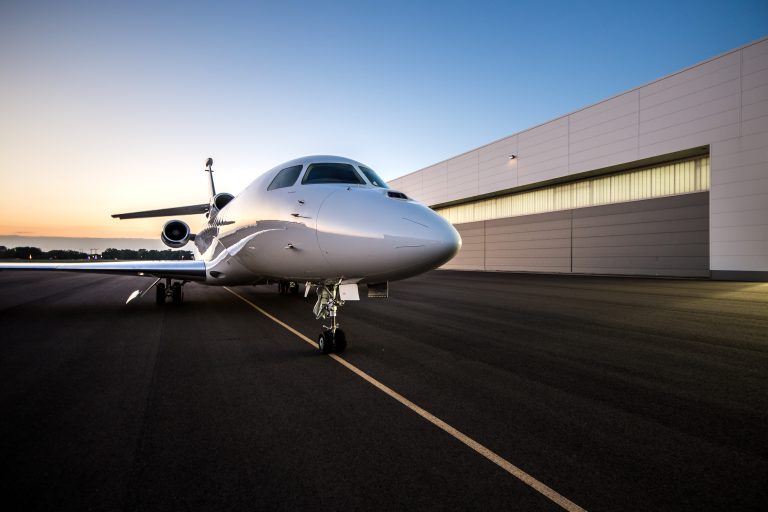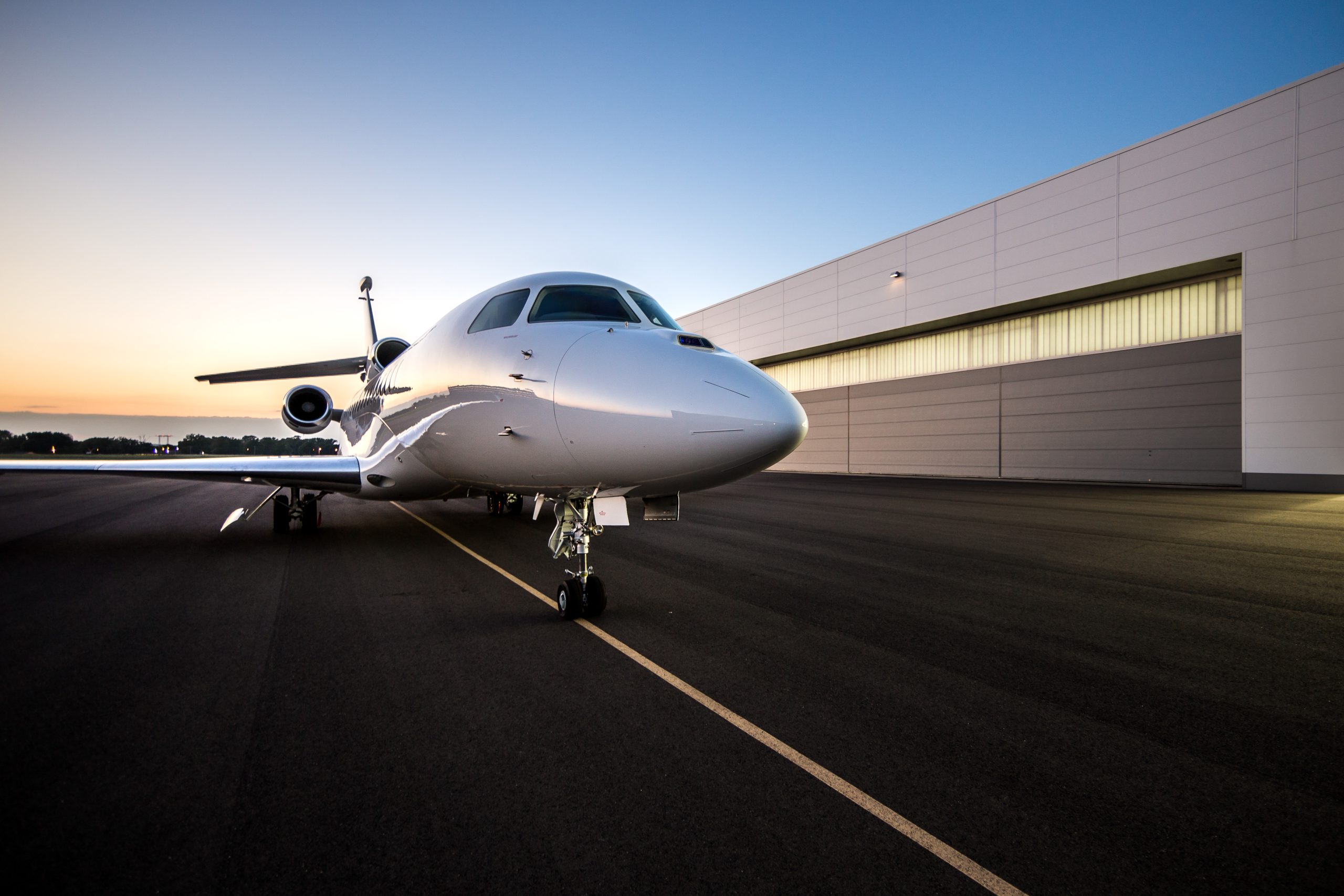The most flexible, cost-efficient long-range business jet on the market. With the quietest cabin in the industry.
The Falcon 8X offers the greatest range in the Falcon line, along with accessibility to shorter runways, lower operating economics, the industry’s largest selection of cabin configurations, and unrivaled flight-handling qualities.
Fly Farther With More Flexibility
Optimum Range with Short-field Capability. Maximum Operational Flexibility.
The range and flexibility of the Falcon 8X enables customers to fly almost anywhere in the world.
The Ultra-Long-Range Leader. The Falcon 8X is capable of flying for 14 hours and 6,450 nm / 11,945 km non-stop – at Mach 0.80 with 8 passengers and 3 crew (85% Annual Wind, NBAA IFR Reserves). This enables direct flights between Asia and North America (Beijing-New York, Shanghai-Seattle), between Asia and Europe (Hong Kong-London), and between Europe and South America (London-São Paulo).
Short and Steep Approaches. The Falcon 8X is capable of approaches up to 6 degrees at 107 knots / 198 kph landing speed (2,220 ft / 677 m landing distance) with a balanced field takeoff distance of 5,880 ft / 1,792 m. This allows it to serve London City Airport and similar steep-approach and climb-out runways located close to business destinations.
Less Weight for More Fuel. The longer range – 550 nm further than the Falcon 7X – was made possible by design innovations that enabled it to stretch the 7X fuselage and accommodate more fuel without adding overall weight. Engineers added 1.1 m (3.6 ft) to the 7X fuselage, allowing the 8X to take on 1,360 kg (3,000 lb) more fuel, or a total fuel weight of 15,940 kg (35,140 lb). The weight gain of the extra fuel was offset by an equal weight reduction in the redesigned wing panels and ribs, making the Falcon 8X empty weight nearly identical to that of the 7X. Reengineered winglets and a new leading-edge wing profile also improve the 8X’s lift-to-drag ratio.
Efficient Consumption. The Falcon 8X is up to 30% more fuel efficient than any other aircraft in the ultra-long-range segment. Range capability is further boosted by a 2% fuel consumption improvement in the three enhanced Pratt & Whitney PW307D engines that power the Falcon 8X. The new engines also provide higher thrust at 6,722 lb / 29.90 kN (sea level, ISA +17C) – a 5% thrust increase over the 7X – and reduce emissions to levels well below the latest emissions standards. Other enhancements include fan seal improvements and more advanced digital flight controls.
Typical Falcon 8X missions.
- Asia to North America: Beijing–New York, Shanghai–Seattle, Hong Kong–Seattle
- Asia to Australia: Mumbai–Sydney
- Asia to Europe: Hong Kong–London
- Europe to Africa: London–Cape Town
- Europe to South America: London–São Paulo
- Europe to Asia: Paris–Singapore
- South America to North America: São Paulo–Los Angeles
- Eastern Europe to North America: Moscow–Los Angeles
- North America to Middle East: New York–Tel Aviv
Short Hop and Go. The Falcon 8X is able to land at 85% of its maximum takeoff weight. This allows operators to make a short hop to an interim airport, pick up passengers, and then continue on to an overseas destination without having to refuel. For example, the 8X can fly from Washington to New York, and then proceed to an onward destination up to 4,500 nm away – up to 20% farther than competitor aircraft.
Cabin Productivity & Comfort
The Largest Selection of Cabin Customization Configurations in Business Aviation. For up to 12-16 passengers.
The longer Falcon 8X cabin enables operators to incorporate virtually any option passengers might wish for in an ultra-long-range business jet: luxury VIP suite, ultra-flexible seating and conference layouts, spacious galley or crew rest area – while retaining the bright cabin and low noise levels that the aircraft is renowned for.
There’s room enough for 12-16 passengers – with a variety of options for working, dining, relaxing and sleeping.
The Most Cabin Choices. Dassault interior designers and industrial engineers collaborated to yield multiple standard cabin configurations, the most in business aviation.
A key to enabling this large variety of customer configurations is the redefined entryway and galley area. Three different galley sizes are available, the longest up to 93-in in length. This galley option incorporates a 78-in lie-flat crew berth plus enough storage capacity to accommodate 14-hour flights. The enlarged forward area can also be used as a lounge / bar for casual conversation. And by incorporating two additional window rows into the forward area design (bringing the total number of windows to 32), engineers made the ratio of window surface to cabin surface among the best in its category.
Customers can also opt for a spacious private VIP stateroom at the rear of the aircraft that can be converted into a media room complete with pop up 32-inch TV screen – or an aft shower and lavatory – and still keep a third lounge. There’s also space mid-cabin for a six-seat conference grouping. Up to six passengers can enjoy sleeping berths on overnight flights.
Simple, Seamless Onboard Connectivity. Falcon aircraft operators no longer need to reach out to multiple service providers for satellite communications: FalconConnect provides a single point of contact for hardware, network installation, troubleshooting, and cost management, including ready access to data consumption through the FalconConnect portal.
Dassault, in partnership with Honeywell / GoDirect, conducted extensive development and testing to evaluate and select reliable, flexible, best-value connectivity choices for cockpit, passenger cabin and ground services. The package includes:
- Cockpit safety communications such as FANS (Future Air Navigation System) and ACARS (Aircraft Communications Addressing and Reporting System);
- High-speed Ka-, Ku- and L-band satellite communications services for passenger cabin connectivity, including real-time videoconferencing, voice over IP, internet browsing, and email;
- 3G and 4G ground networks;
- Third-party compatible EFB (electronic flight bag), ATG (air-to-ground), and other services.
The Falcon 8X comes equipped with the Dassault / Rockwell Collins FalconCabin HD+ option, which utilizes the latest fiber optic network technology to distribute crisp, high-definition audio and video content throughout the cabin. Passengers have total control of cabin functions in one easy-to-use interface.
Whisper Quiet and Superior Comfort. Soundproofing improvements engineered into the Falcon 8X make it even quieter than the Falcon 7X, which has long been the industry benchmark in aircraft sound level. Dassault engineers created a more effective yet lighter weight acoustical insulation package that concentrates noise-absorbing materials where the sound levels tend to be the highest. The result is a further 2dB reduction in cabin sound.
Cabin air is refreshed continuously for an environment that is 10 times cleaner than today’s most advanced office buildings. Cabin altitude pressurization is maintained at a very comfortable 3,900 ft (1,189 m) at 41,000 ft (12,497 m) cruise, compared with 6-8,000 ft for airliners and typical business jets. So, passengers not only travel in the most comfortable conditions, they arrive at their destination fully refreshed and ready to go.
Cabin Specifications.
- 13 m long (42 ft 8 in), 2.34 m wide (7 ft 8 in), 1.88 m high (6 ft 2 in) – 1,765 cu ft total volume
- More than 30 different cabin configurations, including:
- Three galley sizes, two with a crew-rest option
- Lavatory with a shower option
- Passenger seating areas of varying lengths
The Pilot’s Favorite Cockpit, Now Even Better
Industry-innovating Fly-By-Wire, Combined Vision, and more.
To pilots, the Falcon 8X will fly almost identical to the 7X. Aircraft design differences are adjusted for in the control load and fly-by-wire algorithms.
Revolutionary Situational Awareness. Most Falcon 8X buyers opt for the FalconEye combined vision system (CVS) – the first Head-Up Display (HUD) to blend synthetic, database-driven terrain imaging and real-world thermal and low-light camera images into a single view, providing an unprecedented level of situational awareness to flight crews in challenging weather conditions and all phases of flight. FalconEye is certified by EASA and the FAA for an enhanced flight vision system (EFVS) capability that provides operational credit for poor visibility approaches down to 100 ft, greatly improving access to airports and significantly enhancing aircraft fleet efficiency.
In 2020, the FalconEye option will be further enhanced with the addition of a dual-HUD configuration.
FalconEye’s 30×40 degree field of view is one of the widest angles on any HUD, ensuring full viewing coverage with 1280×1024-pixel resolution. FalconEye features a fourth-generation multi-sensor camera whose six sensors present high-quality images in both the visible and infrared spectrums. These images are combined with three dedicated worldwide synthetic vision databases that map terrain, obstacles, navigation, and airport and runway data. FalconEye was developed in partnership with Elbit Systems.
The Most Advanced Digital Controls. Dassault Aviation introduced digital flight control for business aircraft more than a dozen years ago with the launch of the Falcon 7X, leveraging four decades of path-stable, closed-loop auto trim controls for military aircraft. The DFCS on the Falcon 8X builds on this heritage, further simplifying the pilot’s workload for even greater safety and flying efficiency.
Intuitive and EASy Flight Deck. The Falcon 8X cockpit avionics package includes the third-generation EASy III system, powered by Honeywell’s Primus Epic platform. Among new features are an integrated controller-pilot data link communication (CPDLC) system and RDR 4000 IntuVue 3D color weather radar that provides predictive lightning and hail detection as well as 60 nm range Doppler turbulence detection. Hazardous weather and the vertical definition of thunderstorms can be seen at distances up to 320 nm.
Integrated EFB. Dassault’s FalconSphere II electronic flight bags (EFBs) are integrated into the console. Falcon Sphere II hosts weight and balance charts, aircraft manuals, dispatch documentation, master minimum equipment lists, maintenance procedures, and Falcon Aircraft Performance data.
Whatever It Takes® Support
More dispatch reliability. Dassault Aviation’s renowned global support network. Service centers on six continents. A team of more than 1,700 professionals dedicated to keeping customer aircraft in the air.
Throughout the life of the Falcon 8X, customers can rely on the Whatever It Takes® philosophy of Dassault’s global service network.
In 2019, Dassault Aviation acquired the worldwide maintenance facilities of ExecuJet, strengthening its global product support footprint, especially in Asia-Pacific region, Oceania, the Middle East and Africa. Dassault also acquired the maintenance activities of TAG Aviation and RUAG, reinforcing its European service center network.
Worldwide Service and Spares. Dassault Aviation supports Falcon operators with a network of more than 60 service centers, 16 regional spares distribution depots and more than 100 field representatives spread across six continents.
In 2019, Dassault Aviation opened a new $50 million, 180,000-ft2 (16,500-m2) flagship spares distribution center in Tremblay-en-France, in the immediate environs of Paris-Charles de Gaulle Airport. The proximity of the facility to one of the world’s major transport hubs, together with its state-of-the-art design, will help ensure that parts and tools arrive in the hands of Falcon customers in Europe, the Middle East, Africa and the Asia/Pacific even more rapidly than before.
Expedited Go Teams. FalconResponse, an industry first, is Dassault’s comprehensive portfolio of Aircraft On Ground (AOG) services. In the rare event that a Falcon operator has an AOG situation requiring emergency repair, a call to the global 24/7 Falcon Command Center activates a dedicated “GoTeam” of engineers, parts specialists and frontline managers to return the aircraft to flying condition as quickly as possible. If necessary, members of the GoTeam can utilize one of two dedicated Falcon Airborne Support aircraft that stand by to expedite the shipment of repair teams and spares to remote sites. Alternative lift flights – another industry first – are also available to customers affected by an AOG.
Falcon Value
More return on customer investment. Lower operating and maintenance costs. Higher resale value. Falcon models hold their value better than any other business jet. They retain up to 10% more value over an extended 10-year period than their closest competitor. Market analysis shows high demand for second-hand Falcons means they also tend to take less time to resell.
Low Operating Costs Save Millions. Direct operating costs are estimated around US$4,000 per hour, thanks in part to elimination of the basic two-month maintenance interval. If operated for six years at 600 flight hours per year, the Falcon 8X will save an estimated $8.5 to $11 million compared with its primary competitors, including higher resale value.
Reduced Maintenance Cost. The current fleet of more than 2,100 Falcons operated in 90+ countries fully demonstrates the exceptional strength of the Falcon line. Unlike some of their competitors, Falcons do not have any life-limited primary structural parts. Dassault’s FalconCare guaranteed maintenance cost program assures budgeting predictability for parts, labor and AOG onsite service.
Falcon 8X maintenance intervals have been extended in accordance with the latest MSG3 standards, further improving aircraft availability. The 8X is guaranteed for 800 hours or 12 months between inspections – intervals 30% longer than previous-generation aircraft.
World-Class Training. Authorized pilot training for the Falcon 8X is delivered through FlightSafety International at Le Bourget airport in Paris, where FalconEye CVS training is also dispensed. Maintenance training is available at Le Bourget and Dallas, Texas. Cabin crew and customer familiarization sessions are offered though Aircare FACTS Training International.
Falcon 8X Milestones
- Announced May 2014, at the European Business Aviation Conference and Exhibition (EBACE), Geneva, Switzerland
- First flight, 6 February 2015
- PW307D engine certification, Transport Canada and FAA 2015, EASA 2016
- Entry Into Service (EIS), 5 October 2016 (AMJet Executive)
- Certification of FalconEye Combined Vision System, FAA and EASA, March 2017
- EASA and FAA approval of FalconEye for operational credit in poor visibility approaches down to 100 feet, October 2018
Falcon 8X Specifications
PERFORMANCE
- Range: 6,450 nm (11,945 km) at Mach .80 (8 pax, 3 crew, ISA, SL, Zero Wind, NBAA IFR Reserves)
- Maximum Mach Operating (MMO) speed: Mach .90
- Maximum Certified Altitude: 51,000 ft (15,545 m)
- Balanced Field Length (MTOW OF 73,000 LB; SL; ISA; SF2): 5,880 ft (1,792 m)
- Approach Speed, Vref (8 pax, 3 crew, NBAA IFR Reserves): 107 kias (198 km/h)
- Landing Distance (FAR 91, 8 pax, 3 crew, SL, NBAA IFR Reserves): 2,220 ft (677 m)
ENGINES & AVIONICS
- 3 Pratt & Whitney PW307D
- Max Thrust (ISA+170C): 6,722 lb (29.90 kN)
- 3rd Generation EASy Flight Deck
- With Honeywell Primus Epic System
- Optional FalconEye Combined Vision System
EXTERNAL DIMENSION
- Wing Span: 86 ft 3 in (26.29 m)
- Length: 80 ft 3 in (24.46 m)
- Height: 26 ft 1 in (7.94 m)
INTERNAL DIMENSIONS
- Cabin Height: 74 in (1.88 m)
- Cabin Width: 92 in (2.34 m)
- Cabin Length (excluding flight deck and baggage): 42 ft 8 in (13 m)
- Cabin Volume (excluding flight deck and baggage): 1,695 ft3 (48 m3)
- Baggage Volume: 140 ft3 (4 m3)
WEIGHTS/CAPACITIES
- Maximum Takeoff Weight: 73,000 lb (33,113 kg)
- Maximum Landing Weight: 62,400 lb (28,304 kg)
- Maximum Zero-Fuel Weight: 41,000 lb (18,598 kg)
- Maximum Fuel Weight: 35,141 lb (15,940 kg)
